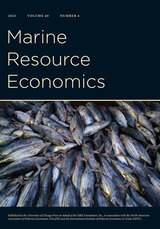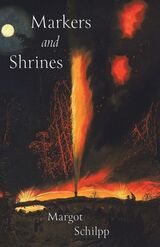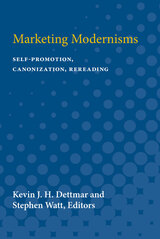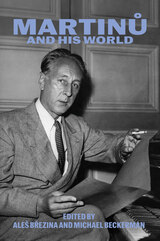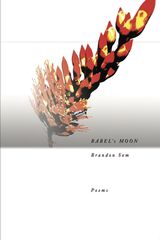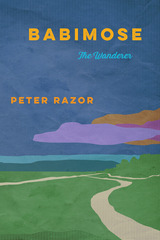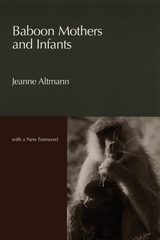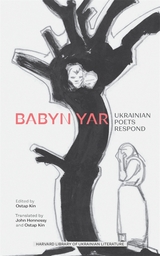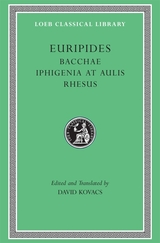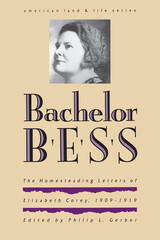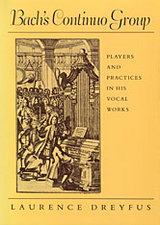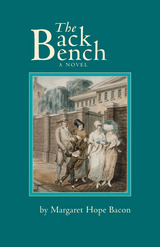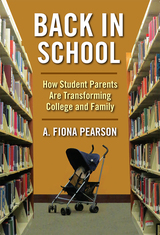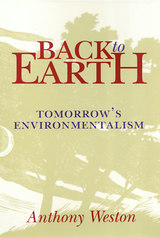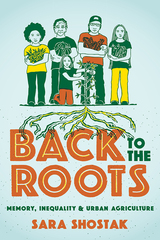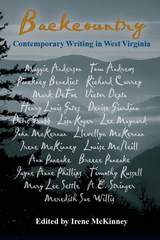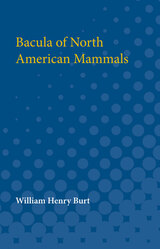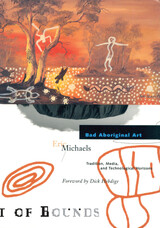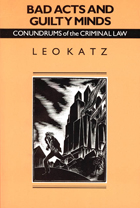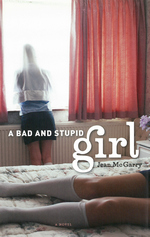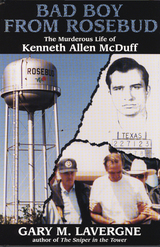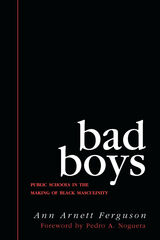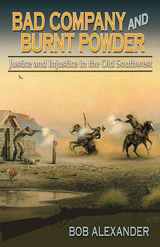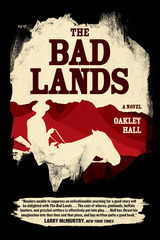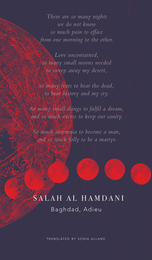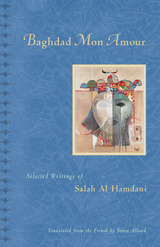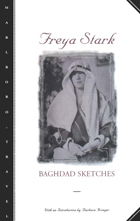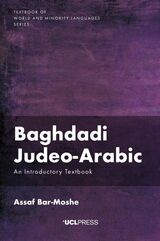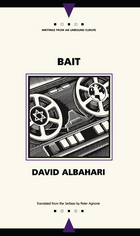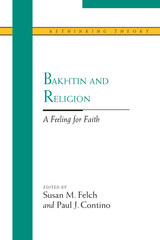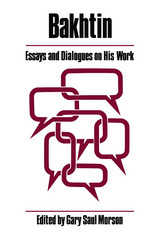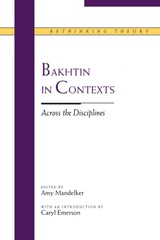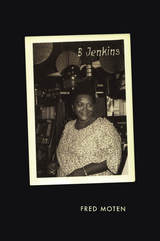 B Jenkins
Fred Moten
Duke University Press, 2010 The fourth collection of poetry from the literary and cultural critic Fred Moten, B Jenkins is named after the poet’s mother, who passed away in 2000. It is both an elegy and an inquiry into many of the themes that Moten has explored throughout his career: language, music, performance, improvisation, and the black radical aesthetic and political tradition. In Moten’s verse, the arts, scholarship, and activism intertwine. Cadences echo from his mother’s Arkansas home through African American history and avant-garde jazz riffs. Formal innovations suggest the ways that words, sounds, and music give way to one another. The first and last poems in the collection are explicitly devoted to Moten’s mother; the others relate more obliquely to her life and legacy. They invoke performers, writers, artists, and thinkers including not only James Baldwin, Roland Barthes, Frederick Douglass, Billie Holiday, Audre Lorde, Charlie Parker, and Cecil Taylor, but also contemporary scholars of race, affect, and queer theory. The book concludes with an interview conducted by Charles Henry Rowell, the editor of the journal Callaloo. Rowell elicits Moten’s thoughts on the relation of his poetry to theory, music, and African American vernacular culture.
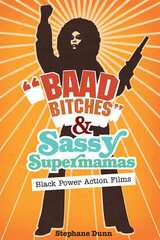 "Baad Bitches" and Sassy Supermamas: Black Power Action Films
Stephane Dunn
University of Illinois Press, 2008 Blaxploitation action narratives as well as politically radical films like Sweet Sweetback's Baadasssss Song typically portrayed black women as trifling "bitches" compared to the supermacho black male heroes. But starting in 1973, the emergence of "baad bitches" and "sassy supermamas" reversed the trend as self-assured, empowered, and tough black women took the lead in the films Cleopatra Jones, Coffy, and Foxy Brown. Stephane Dunn unpacks the intersecting racial, sexual, and gender politics underlying the representations of racialized bodies, masculinities, and femininities in early 1970s black action films, with particular focus on the representation of black femininity. Recognizing a distinct moment in the history of African American representation in popular cinema, Dunn analyzes how it emerged from a radical political era influenced by the Black Power movement and feminism. Dunn also engages blaxploitation's legacy in contemporary hip-hop culture, as suggested by the music’s disturbing gender politics and the "baad bitch daughters" of Foxy Brown and Cleopatra Jones, rappers Foxy Brown and Lil' Kim.
 The Bab Ballads
W. S. Gilbert
Harvard University Press, 1970 W. S. Gilbert, renowned author of the Savoy Operas, was also the creator of the Bab Ballads--"possibly the best comic verse--and surely the best illustrated--in the English language," according to James Ellis. Gilbert published these poems, together with his own, grotesque drawings signed "Bab," a childhood nickname, in Fun and other magazines in the late nineteenth century.
In 1898, the older and by then distinguished Gilbert substituted pallid and inoffensive drawings for the originals, which he had come to believe "erred gravely in the direction of unnecessary extravagance." Since then the ballads have been collected and published in various editions, most of which have featured the revised drawings and only a selection of the poems.
This is the only book to offer the complete collection of ballads with all original illustrations, a tribute to the comic genius of a writer known as "the most original dramatist of his generation." This collection will delight readers with its irreverence and wit.
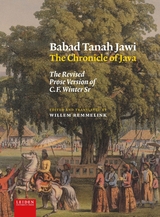 Babad Tanah Jawi, The Chronicle of Java: The Revised Prose Version of C.F. Winter Sr
Edited and translated by Willem Remmelink
Amsterdam University Press, 2022 "The revised prose version of the Babad Tanah Jawi was originally prepared by C.F. Winter Sr. (1799-1859), with the twofold aim of providing Javanese-language teaching material and of setting a standard for formal Javanese prose writing. At that time, Javanese was almost exclusively written in verse, which was not a medium suitable for the modern world that was dawning on Java. Although Winter achieved his aims in other ways and publications, the present text was mostly forgotten, or was just passed over as another copy of the Meinsma text (Pigeaud, Literature of Java). This was unfortunate, because it deprived linguists of one of the first attempts to create a standard Javanese prose language, and historians of a readable text that presented a Javanese view of Javanese history from the beginning until 1742. To belatedly set the record straight and to honour Winter’s contributions to the development of Javanese, the author decided to publish this text in Javanese script and provide an English translation for the general public. Although historians of Java have endeavoured to incorporate Javanese sources in their research, it remains invaluable to view that history directly through the eyes of 17th and 18th century Javanese contemporaries. "
 Babe: The Life and Legend of Babe Didrikson Zaharias
Susan E. Cayleff
University of Illinois Press, 1995 An extraordinarily gifted athlete, Babe Didrikson Zaharias starred in track and field and won three Olympic medals in 1932. She picked up golf late yet quickly dominated the women's sport. She also competed in baseball, bowling, basketball, and tennis. Interviews with members of Babe's family, peers, and others inform Susan E. Cayleff’s story of the athlete and the difficulties she faced as a woman trying to be her own person. The American public was smitten with Babe’s wit, frankness, and "unladylike" bravado. But members of the press insinuated that her femininity, even her femaleness, were suspect. Cayleff looks at how Babe used her androgyny and athleticism to promote herself before crafting a more marketable female persona for golf. She also explores Babe’s role as a cofounder of the Ladies Professional Golf Association (LPGA); her marriage to George Zaharias and their partnership in shaping her career; her romantic relationship with fellow golfer Betty Dodd; and her courageous public fight against cancer.
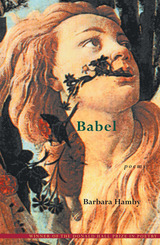 Babel
Barbara Hamby
University of Pittsburgh Press, 2004 Babel features more of the rhetorical acrobatics that fueled Barbara Hamby's earlier work. These whirlwinds of words and sounds form vistas, images, and scenes that are at once unique and immediately recognizable.
In poems such as “Six, Sex, Say,” she displays a linguistic bravado that moves effortlessly through translations, cognates, and homonyms. This love of words permeates the poems, from the husband wooing his future wife “with a barrage of words so cunningly fluent, / so linguistically adroit” in “Flesh, Bone, and Red,” to the alphabetic sampler woven from memory and love in “Ode on My Mother's Handwriting.”
Hamby's poems drift across histories and continents, from early writing and culture in Mesopotamia through the motion-picture heaven that seems so much like Paris, to odes on such thoroughly American subjects as hardware stores, bubblegum, barbecue, and sharp-tongued cocktail waitresses giving mandatory pre-date quizzes to lawyers and “orangutans in the guise of men.” As Booklist noted in reviewing her previous collection, Hamby's poems “are tsunamis carrying you far out to sea and then back to shore giddy and glad to be alive.”
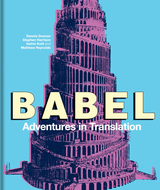 Babel: Adventures in Translation
Dennis Duncan, Stephen Harrison, Katrin Kohl, and Matthew Reynolds
Bodleian Library Publishing, 2019 This innovative collection of essays shows how linguistic diversity has inspired people across time and cultures to embark on adventurous journeys through the translation of texts. It tells the story of how ideas have travelled via the medium of translation into different languages and cultures, focusing on illustrated examples ranging from Greek papyri through illuminated manuscripts and fine early books to fantasy languages and the search for a universal language.
Starting with the concept of Babel itself, which illustrates the early cultural prominence of multilingualism, the book examines a Mediterranean language of four millennia ago called Linear A, which still resists deciphering today. Going on to explore how languages have interacted with each other in different contexts, the book also sheds light on the multilingual transmission of key texts in religion, science, fables and fairy-tales, and epic literature. Lavishly illustrated with a diverse range of material, from papyrus fragments found at Oxyrhynchus in Egypt to Esperanto handbooks to Asterix cartoons, Babel opens up a world of adventures into translation.
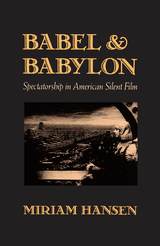 Babel and Babylon: Spectatorship in American Silent Film
Miriam Hansen
Harvard University Press, 1994 Although cinema was invented in the mid-1890s, it was a decade more before the concept of a “film spectator” emerged. As the cinema began to separate itself from the commercial entertainments in whose context films initially had been shown—vaudeville, dime museums, fairgrounds—a particular concept of its spectator was developed on the level of film style, as a means of predicting the reception of films on a mass scale. In Babel and Babylon, Miriam Hansen offers an original perspective on American film by tying the emergence of spectatorship to the historical transformation of the public sphere.
Hansen builds a critical framework for understanding the cultural formation of spectatorship, drawing on the Frankfurt School’s debates on mass culture and the public sphere. Focusing on exemplary moments in the American silent era, she explains how the concept of the spectator evolved as a crucial part of the classical Hollywood paradigm—as one of the new industry’s strategies to integrate ethnically, socially, and sexually differentiated audiences into a modern culture of consumption. In this process, Hansen argues, the cinema might also have provided the conditions of an alternative public sphere for particular social groups, such as recent immigrants and women, by furnishing an intersubjective context in which they could recognize fragments of their own experience.
After tracing the emergence of spectatorship as an institution, Hansen pursues the question of reception through detailed readings of a single film, D. W. Griffith’s Intolerance (1916), and of the cult surrounding a single star, Rudolph Valentino. In each case the classical construction of spectatorship is complicated by factors of gender and sexuality, crystallizing around the fear and desire of the female consumer.
Babel and Babylon recasts the debate on early American cinema—and by implication on American film as a whole. It is a model study in the field of cinema studies, mediating the concerns of recent film theory with those of recent film history.
Babel's Moon
Brandon Som
Tupelo Press, 2011 Babel’s Moon eulogizes an immigrant grandfather, and in doing so explores boundaries that are at once geographic, historical, and cosmological. Brandon Som’s first book moves between vigorously detailed descriptive poems and austere, atmospheric lyrics as he finds new ways of reaching for (and even crossing) the horizons.
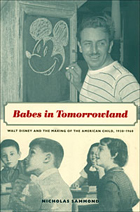 Babes in Tomorrowland: Walt Disney and the Making of the American Child, 1930–1960
Nicholas Sammond
Duke University Press, 2005 Linking Margaret Mead to the Mickey Mouse Club and behaviorism to Bambi, Nicholas Sammond traces a path back to the early-twentieth-century sources of “the normal American child.” He locates the origins of this hypothetical child in the interplay between developmental science and popular media. In the process, he shows that the relationship between the media and the child has long been much more symbiotic than arguments that the child is irrevocably shaped by the media it consumes would lead one to believe. Focusing on the products of the Walt Disney company, Sammond demonstrates that without a vision of a normal American child and the belief that movies and television either helped or hindered its development, Disney might never have found its market niche as the paragon of family entertainment. At the same time, without media producers such as Disney, representations of the ideal child would not have circulated as freely in American popular culture. In vivid detail, Sammond describes how the latest thinking about human development was translated into the practice of child-rearing and how magazines and parenting manuals characterized the child as the crucible of an ideal American culture. He chronicles how Walt Disney Productions’ greatest creation—the image of Walt Disney himself—was made to embody evolving ideas of what was best for the child and for society. Bringing popular child-rearing manuals, periodicals, advertisements, and mainstream sociological texts together with the films, tv programs, ancillary products, and public relations materials of Walt Disney Productions, Babes in Tomorrowland reveals a child that was as much the necessary precursor of popular media as the victim of its excesses.
 Babies and Beasts: THE ARGUMENT FROM MARGINAL CASES
Daniel A. Dombrowski
University of Illinois Press, 1997
Both its defenders and detractors
have described the argument from marginal cases as the most important
to date in defense of animal rights. Hotly debated among philosophers
for some twenty years, the argument concludes that no morally relevant
characteristic distinguishes human beings–including infants, the
severely retarded, the comatose, and other "marginal cases"--from
any other animals.
Babies and Beasts presents
the first book-length exploration of the broad range of views relating
to the argument from marginal cases and sorts out and evaluates its various
uses and abuses.
Daniel Dombrowski analyzes
the views of many who are prominent in the debate--
Peter Singer, Thomas Regan, H. J. McCloskey, Jan Narveson, John Rawls,
R. G. Frey, Peter Carruthers, Michael Leahy, Robert Nozick, and James
Rachels are included--in a volume that will be essential to philosophers,
animal rights activists, those who work in clinical settings, and others
who must sometimes deal with "marginal cases."
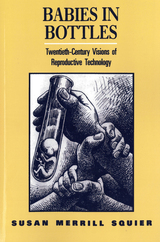 Babies In Bottles
Susan Merrill Squier
Rutgers University Press, 1994 There is a forgotten history to our current debates over reproductive technology - one interweaving literature and science, profoundly gendered, filled with choices and struggles. We pay a price when we accept modern reproductive technology as a scientific breakthrough without a past. Babies in Bottles retrieves some of that history by analyzing the literary and popular science writings of Julian Huxley, J.B.S. Haldane, Charlotte Haldane, Aldous Huxley, and Naomi Mitchison - writings that include representations of reproductive technology from babies in bottles to surrogate mothers. It is to these images, fantasies, practices, and narratives of scientific intervention in reproduction that we must look if we want to understand what acts of ideological construction have been carried out, and are currently being performed, in the name of reproductive technology. Susan Merrill Squier shows how the imaginative construction of reproductive technology helps to shape our contemporary practices. Susan Merrill Squier is Julia Gregg Brill Professor in Women's Studies and English at the Pennsylvania State University, University Park. She is the author of Virginia Woolf and London: The Sexual Politics of the City, editor of Women Writers and the City: Essays in Feminist Literary Criticism, and co-editor of Arms and the Woman: War, Gender, and Literary Representation.
Babimose: The Wanderer
Peter Razor
Michigan State University Press, 2025 Set against the backdrop of the French and Indian War in the 1750s, this book expands on the legend of Babimose. The legend was passed down as an oral history among Indigenous peoples until it was recorded by a traveling historian who was among the northern Wisconsin Ojibwe in the 1850s. The story recalls a gifted Anishinaabe boy who lived south of Gichigami, now known as Lake Superior, who independently traveled among Indigenous nations. The original story was recorded as a one-page description of Babimose; this book expands on this to explore the language barriers and cultural differences that Babimose would have encountered on his journey. The lessons he learned about people and their resilience in the region still offer lessons for readers today.
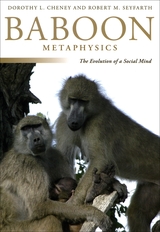 Baboon Metaphysics: The Evolution of a Social Mind
Dorothy L. Cheney and Robert M. Seyfarth
University of Chicago Press, 2007 In 1838 Charles Darwin jotted in a notebook, “He who understands baboon would do more towards metaphysics than Locke.” Baboon Metaphysics is Dorothy L. Cheney and Robert M. Seyfarth’s fascinating response to Darwin’s challenge.
Cheney and Seyfarth set up camp in Botswana’s Okavango Delta, where they could intimately observe baboons and their social world. Baboons live in groups of up to 150, including a handful of males and eight or nine matrilineal families of females. Such numbers force baboons to form a complicated mix of short-term bonds for mating and longer-term friendships based on careful calculations of status and individual need.
But Baboon Metaphysics is concerned with much more than just baboons’ social organization—Cheney and Seyfarth aim to fully comprehend the intelligence that underlies it. Using innovative field experiments, the authors learn that for baboons, just as for humans, family and friends hold the key to mitigating the ill effects of grief, stress, and anxiety.
Written with a scientist’s precision and a nature-lover’s eye, Baboon Metaphysics gives us an unprecedented and compelling glimpse into the mind of another species.
“The vivid narrative is like a bush detective story.”—Steven Poole, Guardian
“Baboon Metaphysics is a distillation of a big chunk of academic lives. . . . It is exactly what such a book should be—full of imaginative experiments, meticulous scholarship, limpid literary style, and above all, truly important questions.”—Alison Jolly, Science
“Cheney and Seyfarth found that for a baboon to get on in life involves a complicated blend of short-term relationships, friendships, and careful status calculations. . . . Needless to say, the ensuing political machinations and convenient romantic dalliances in the quest to become numero uno rival the bard himself.”—Science News “Cheney and Seyfarth’s enthusiasm is obvious, and their knowledge is vast and expressed with great clarity. All this makes Baboon Metaphysics a captivating read. It will get you thinking—and maybe spur you to travel to Africa to see it all for yourself.”—Asif A. Ghazanfar, Nature
“Through ingenious playback experiments . . . Cheney and Seyfarth have worked out many aspects of what baboons used their minds for, along with their limitations. Reading a baboon’s mind affords an excellent grasp of the dynamics of baboon society. But more than that, it bears on the evolution of the human mind and the nature of human existence.”—Nicholas Wade, New York Times
Baboon Mothers and Infants
Jeanne Altmann
University of Chicago Press, 2001 When it was originally released in 1980, Jeanne Altmann's book transformed the study of maternal primate relationships by focusing on motherhood and infancy within a complex ecological and sociological context. Available again with a new foreword by the author, Baboon Mothers and Infants is a classic book that has been, in its own right, a mother to a generation of influential research and will no doubt provide further inspiration.
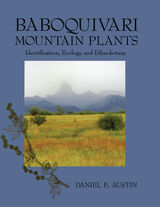 Baboquivari Mountain Plants: Identification, Ecology, and Ethnobotany
Daniel F. Austin
University of Arizona Press, 2010 The Baboquivari Mountains, long considered to be a sacred space by the Tohono O’odham people who are native to the area, are the westernmost of the so-called Sky Islands. The mountains form the border between the floristic regions of Chihuahua and Sonora. This encyclopedic work describes the flora of this unique area in detail. It includes descriptions, identifications, ecology, and extensive etymologies of plant names in European and indigenous languages. Daniel Austin also describes pollination biology and seed dispersal and explains how plants in the area have been used by humans, beginning with Native Americans.
The term “sky island” was first used by Weldon Heald in 1967 to describe mountain ranges that are separated from each other by valleys of grassland or desert. The valleys create barriers to the spread of plant species in a way that is similar to the separation of islands in an ocean. The 70,000-square-mile Sky Islands region of southeastern Arizona, southwestern New Mexico, and northwestern Mexico is of particular interest to botanists because of its striking diversity of plant species and habitats. With more than 3,000 species of plants, the region offers a surprising range of tropical and temperate zones. Although others have written about the region, this is the first book to focus exclusively on the plant life of the Baboquivari Mountains.
The book offers an introduction to the history of the region, along with a discussion of human influences, and includes a useful appendix that lists all of the plants known to be growing in the Baboquivari Mountain chain.
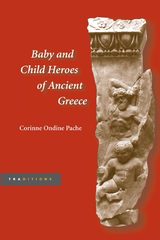 Baby and Child Heroes in Ancient Greece
Corinne Ondine Pache
University of Illinois Press, 2004 In addition to their famous gods and goddesses, the ancient Greeks also worshiped deceased human beings, including child and baby heroes. Although these heroes played an essential role in Greek religion, Corinne Ondine Pache's Baby and Child Heroes in Ancient Greece is the first systematic study of the considerable number of Greek babies and children who became enduring myths, objects of worship, and the recipients of sacrifice.
Examining literary, pictorial, and numismatic representations, Pache opens up a vast territory once occupied by children such as Charila, Opheltes, Melikertes, and the children of Herakles and Medea. She elegantly argues that the stories, songs, and sanctuaries honoring these heroes express parental fears and guilt about children's death. Pache further demonstrates that while the myths and rituals articulate basic human anxieties, their emphasis is ultimately on the beauty that transcends the gruesomeness of the narrative, turning their dread into poetry. By showing the continuity of child heroes in Greek religion, she is able to throw new light on iconographies that have previously defied explanation.
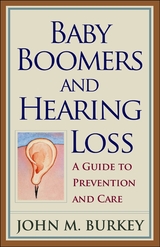 Baby Boomers and Hearing Loss: A Guide to Prevention and Care
Burkey, John M
Rutgers University Press, 2006 In Baby Boomers and Hearing Loss, audiologist John Burkey shows readers how they can continue to enjoy youthful living, regardless of whether their hearing abilities are undiminished or severely compromised. In a reassuring and straightforward style, Burkey explains the typical causes of hearing loss, from genetic factors to years of exposure to loud noises, and demystifies the sometimes confusing results of a hearing test. Fortunately, new technologies and advances in medicine have made it easier to detect signs of initial hearing loss and to prevent it from becoming a serious problem.
For those who have already sustained some damage, the author suggests ways to manage daily activities by using a range of techniques, equipment, and medical procedures. His suggestions include minor changes, such as using a vibrating alarm clock rather than one that is sound-based. More dramatic but often highly effective options, including reconstructive surgery, cochlear implants, and bone-anchored hearing aids, are also described.
In his previous award-winning book, Overcoming Hearing Aid Fears: The Road to Better Hearing, Burkey addressed common fears, concerns, and misconceptions that people have about choosing and using hearing aids. In this second indispensable volume, he offers a comprehensive guide on how to cope with and prevent hearing impairment. For a generation that refuses to slow down or quietly accept limitations, this book is essential reading.
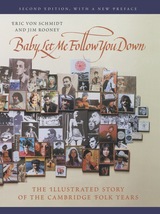 Baby, Let Me Follow You Down: The Illustrated Story of the Cambridge Folk Years
Eric von Schmidt
University of Massachusetts Press, 1979 Baby, Let Me Follow You Down is a classic in the history of American popular culture. The book tells the story of the folk music community in Cambridge, Massachusetts, from its beginnings in living rooms and Harvard Square coffeehouses in the late 1950s to the heyday of the folk music revival in the early 1960s. Hundreds of historical photographs, rescreened for this edition, and dozens of interviews combine to re-create the years when Joan Baez, Bob Dylan, and a lively band of Cambridge folksingers led a generation in the rediscovery of American folk music.
Compiled by two musicians who were active participants in the Cambridge folk scene, the volume documents a special time in United States culture when the honesty and vitality of traditional folk music were combined with the raw power of urban blues and the high energy of electric rock and roll to create a new American popular music.
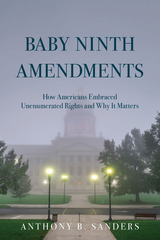 Baby Ninth Amendments: How Americans Embraced Unenumerated Rights and Why It Matters
Anthony B. Sanders
University of Michigan Press, 2023 Listing every right that a constitution should protect is hard. American constitution drafters often list a few famous rights such as freedom of speech, protection against unreasonable searches and seizures, and free exercise of religion, plus a handful of others. However, we do not need to enumerate every liberty because there is another way to protect them: an "etcetera clause." It states that there are other rights beyond those specifically listed: "The enumeration in the Constitution, of certain rights, shall not be construed to deny or disparage others retained by the people." Yet scholars are divided on whether the Ninth Amendment itself actually does protect unenumerated rights, and the Supreme Court has almost entirely ignored it. Regardless of what the Ninth Amendment means, two-thirds of state constitutions have equivalent provisions, or "Baby Ninth Amendments," worded similarly to the Ninth Amendment. This book is the story of how the "Baby Ninths" came to be and what they mean. Unlike the controversy surrounding the Ninth Amendment, the meaning of the Baby Ninths is straightforward: they protect individual rights that are not otherwise enumerated. They are an "etcetera, etcetera" at the end of a bill of rights. This book argues that state judges should do their duty and live up to their own constitutions to protect the rights "retained by the people" that these "etcetera clauses" are designed to guarantee. The fact that Americans have adopted these provisions so many times in so many states demonstrates that unenumerated rights are not only protected by state constitutions, but that they are popular. Unenumerated rights are not a weird exception to American constitutional law. They are at the center of it. We should start treating constitutions accordingly.
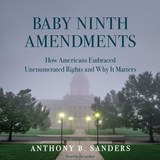 Baby Ninth Amendments: How Americans Embraced Unenumerated Rights and Why It Matters
Anthony B. Sanders
University of Michigan Press, 2023 Listing every right that a constitution should protect is hard. American constitution drafters often list a few famous rights such as freedom of speech, protection against unreasonable searches and seizures, and free exercise of religion, plus a handful of others. However, we do not need to enumerate every liberty because there is another way to protect them: an "etcetera clause." It states that there are other rights beyond those specifically listed: "The enumeration in the Constitution, of certain rights, shall not be construed to deny or disparage others retained by the people." Yet scholars are divided on whether the Ninth Amendment itself actually does protect unenumerated rights, and the Supreme Court has almost entirely ignored it. Regardless of what the Ninth Amendment means, two-thirds of state constitutions have equivalent provisions, or "Baby Ninth Amendments," worded similarly to the Ninth Amendment. This book is the story of how the "Baby Ninths" came to be and what they mean. Unlike the controversy surrounding the Ninth Amendment, the meaning of the Baby Ninths is straightforward: they protect individual rights that are not otherwise enumerated. They are an "etcetera, etcetera" at the end of a bill of rights. This book argues that state judges should do their duty and live up to their own constitutions to protect the rights "retained by the people" that these "etcetera clauses" are designed to guarantee. The fact that Americans have adopted these provisions so many times in so many states demonstrates that unenumerated rights are not only protected by state constitutions, but that they are popular. Unenumerated rights are not a weird exception to American constitutional law. They are at the center of it. We should start treating constitutions accordingly.
Baby Rhyming Time
Linda L. Ernst
American Library Association, 2008 The renowned authority on library services for the very youngest patrons has done it again! Linda Ernst has created programming based on the most important findings in babies' brain development. This new resource is full of activities that stimulate infants' and toddlers' cognitive, physical, and emotional growth.
In this versatile book and CD-ROM package, you'll find book ideas, rhymes, songs and music, props, and more that can be combined to form hundreds of hours of quality programming that will wow parents, educators, and caregivers. The CD-ROM contains lyrics, patterns, forms, and posters that can be adapted and easily reproduced. In addition, the book contains suggestions for scheduling, room arrangement, and parent education. Now your programming for babies and infants can strengthen their language acquisition and motor-skill development... and connect your library with families right from the start!
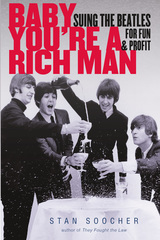 Baby You're a Rich Man: Suing the Beatles for Fun and Profit
Stan Soocher
University Press of New England, 2015 The Beatles, the most popular, influential, and important band of all time, have been the subject of countless books of biography, photography, analysis, history, and conjecture. But this long and winding road has produced nothing like Baby You’re a Rich Man, the first book devoted to the cascade of legal actions engulfing the band, from the earliest days of the loveable mop-heads to their present prickly twilight of cultural sainthood. Part Beatles history, part legal thriller, Baby You’re a Rich Man begins in the era when manager Brian Epstein opened the Pandora’s box of rock ’n’ roll merchandising, making a hash of the band’s licensing and inviting multiple lawsuits in the United States and the United Kingdom. The band’s long breakup period, from 1969 to 1971, provides a backdrop to the Machiavellian grasping of new manager Allen Klein, who unleashed a blizzard of suits and legal motions to take control of the band, their music, and Apple Records. Unsavory mob associate Morris Levy first sued John Lennon for copyright infringement over “Come Together,” then sued him again for not making a record for him. Phil Spector, hired to record a Lennon solo album, walked off with the master tapes and held them for a king’s ransom. And from 1972 to 1975, Lennon was the target of a deportation campaign personally spearheaded by key aides of President Nixon (caught on tape with a drug-addled Elvis Presley) that wound endlessly through the courts. In Baby You’re a Rich Man, Stan Soocher ties the Beatles’ ongoing legal troubles to some of their most enduring songs. What emerges is a stirring portrait of immense creative talent thriving under the pressures of ill will, harassment, and greed. Praise for They Fought the Law: Rock Music Goes to Court “Stan Soocher not only ably translates the legalese but makes both the plaintiffs and defendants engrossingly human. Mandatory reading for every artist who tends to skip his contract’s fine print.”—Entertainment Weekly
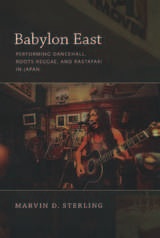 Babylon East: Performing Dancehall, Roots Reggae, and Rastafari in Japan
Marvin D. Sterling
Duke University Press, 2010 An important center of dancehall reggae performance, sound clashes are contests between rival sound systems: groups of emcees, tune selectors, and sound engineers. In World Clash 1999, held in Brooklyn, Mighty Crown, a Japanese sound system and the only non-Jamaican competitor, stunned the international dancehall community by winning the event. In 2002, the Japanese dancer Junko Kudo became the first non-Jamaican to win Jamaica’s National Dancehall Queen Contest. High-profile victories such as these affirmed and invigorated Japan’s enthusiasm for dancehall reggae. In Babylon East, the anthropologist Marvin D. Sterling traces the history of the Japanese embrace of dancehall reggae and other elements of Jamaican culture, including Rastafari, roots reggae, and dub music. Sterling provides a nuanced ethnographic analysis of the ways that many Japanese involved in reggae as musicians and dancers, and those deeply engaged with Rastafari as a spiritual practice, seek to reimagine their lives through Jamaican culture. He considers Japanese performances and representations of Jamaican culture in clubs, competitions, and festivals; on websites; and in song lyrics, music videos, reggae magazines, travel writing, and fiction. He illuminates issues of race, ethnicity, gender, sexuality, and class as he discusses topics ranging from the cultural capital that Japanese dancehall artists amass by immersing themselves in dancehall culture in Jamaica, New York, and England, to the use of Rastafari as a means of critiquing class difference, consumerism, and the colonial pasts of the West and Japan. Encompassing the reactions of Jamaica’s artists to Japanese appropriations of Jamaican culture, as well as the relative positions of Jamaica and Japan in the world economy, Babylon East is a rare ethnographic account of Afro-Asian cultural exchange and global discourses of blackness beyond the African diaspora.
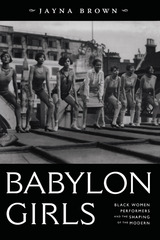 Babylon Girls: Black Women Performers and the Shaping of the Modern
Jayna Brown
Duke University Press, 2008 Babylon Girls is a groundbreaking cultural history of the African American women who performed in variety shows—chorus lines, burlesque revues, cabaret acts, and the like—between 1890 and 1945. Through a consideration of the gestures, costuming, vocal techniques, and stagecraft developed by African American singers and dancers, Jayna Brown explains how these women shaped the movement and style of an emerging urban popular culture. In an era of U.S. and British imperialism, these women challenged and played with constructions of race, gender, and the body as they moved across stages and geographic space. They pioneered dance movements including the cakewalk, the shimmy, and the Charleston—black dances by which the “New Woman” defined herself. These early-twentieth-century performers brought these dances with them as they toured across the United States and around the world, becoming cosmopolitan subjects more widely traveled than many of their audiences. Investigating both well-known performers such as Ada Overton Walker and Josephine Baker and lesser-known artists such as Belle Davis and Valaida Snow, Brown weaves the histories of specific singers and dancers together with incisive theoretical insights. She describes the strange phenomenon of blackface performances by women, both black and white, and she considers how black expressive artists navigated racial segregation. Fronting the “picaninny choruses” of African American child performers who toured Britain and the Continent in the early 1900s, and singing and dancing in The Creole Show (1890), Darktown Follies (1913), and Shuffle Along (1921), black women variety-show performers of the early twentieth century paved the way for later generations of African American performers. Brown shows not only how these artists influenced transnational ideas of the modern woman but also how their artistry was an essential element in the development of jazz.
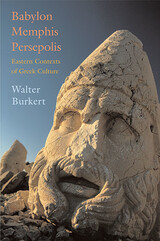 Babylon, Memphis, Persepolis: Eastern Contexts of Greek Culture
Walter Burkert
Harvard University Press, 2007 At the distant beginning of Western civilization, according to European tradition, Greece stands as an insular, isolated, near-miracle of burgeoning culture. This book traverses the ancient world’s three great centers of cultural exchange—Babylonian Nineveh, Egyptian Memphis, and Iranian Persepolis—to situate classical Greece in its proper historical place, at the Western margin of a more comprehensive Near Eastern–Aegean cultural community that emerged in the Bronze Age and expanded westward in the first millennium B.C.
In concise and inviting fashion, Walter Burkert lays out the essential evidence for this ongoing reinterpretation of Greek culture. In particular, he points to the critical role of the development of writing in the ancient Near East, from the achievement of cuneiform in the Bronze Age to the rise of the alphabet after 1000 B.C. From the invention and diffusion of alphabetic writing, a series of cultural encounters between “Oriental” and Greek followed. Burkert details how the Assyrian influences of Phoenician and Anatolian intermediaries, the emerging fascination with Egypt, and the Persian conquests in Ionia make themselves felt in the poetry of Homer and his gods, in the mythic foundations of Greek cults, and in the first steps toward philosophy. A journey through the fluid borderlines of the Near East and Europe, with new and shifting perspectives on the cultural exchanges these produced, this book offers a clear view of the multicultural field upon which the Greek heritage that formed Western civilization first appeared.
Babylonian Chronographic Texts from the Hellenistic Period
R. J. van der Spek
SBL Press, 2025 A comprehensive edition of Akkadian chronographic texts from the fourth to the first centuries BCE
Babylonian Chronographic Texts from the Hellenistic Period gathers in a single volume previously unpublished tablets together with those that have appeared before, including the Babylonian chronicles, the historical sections of the Astronomical Diaries, the Babylonian and Uruk King Lists, and the Antiochus Cylinder from Borsippa. The volume offers new descriptions, transliterations, and translations of each tablet, together with full linguistic and historical commentary. This comprehensive collection brings these important historiographic tools to a broader audience of scholars of history, biblical studies, and the ancient world. An appendix with entries on political institutions, temples, important persons, and Babylonian and Greek words makes this an indispensable tool for students.
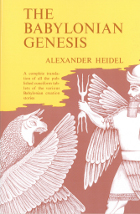 The Babylonian Genesis: The Story of the Creation
Alexander Heidel
University of Chicago Press, 1963 The origins of Judeo-Christian creation accounts: An complete, authoritative translation of all the extant cuneiform tablets of Babylonian creation stories
The Babylonian Genesis offers, in one compact, accessible volume, a complete translation of all the published cuneiform tablets of the various Babylonian creation stories, of both the Semitic Babylonian and the Sumerian material. Each creation account is preceded by a brief introduction from renowned scholar and translator Alexander Heidel dealing with the age and provenance of the tablets, the aim and purpose of the story, and everything else that a reader of any level of knowledge needs to understand these stories in their context. Also included is a translation and discussion of two Babylonian creation versions written in Greek. The final chapter presents a detailed examination of the Babylonian creation accounts in their relation to our Old Testament literature.
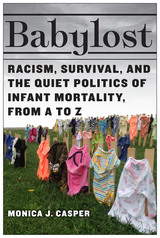 Babylost: Racism, Survival, and the Quiet Politics of Infant Mortality, from A to Z
Monica J. Casper
Rutgers University Press, 2021 The U.S. infant mortality rate is among the highest in the industrialized world, and Black babies are far more likely than white babies to die in their first year of life. Maternal mortality rates are also very high. Though the infant mortality rate overall has improved over the past century with public health interventions, racial disparities have not. Racism, poverty, lack of access to health care, and other causes of death have been identified, but not yet adequately addressed. The tragedy is twofold: it is undoubtedly tragic that babies die in their first year of life, and it is both tragic and unacceptable that most of these deaths are preventable. Despite the urgency of the problem, there has been little public discussion of infant loss. The question this book takes up is not why babies die; we already have many answers to this question. It is, rather, who cares that babies, mostly but not only Black and Native American babies, are dying before their first birthdays? More importantly, what are we willing to do about it? This book tracks social and cultural dimensions of infant death through 58 alphabetical entries, from Absence to ZIP Code. It centers women’s loss and grief, while also drawing attention to dimensions of infant death not often examined. It is simultaneously a sociological study of infant death, an archive of loss and grief, and a clarion call for social change.
Babyn Yar: Ukrainian Poets Respond
Ostap Kin
Harvard University Press, 2023 In 2021, the world commemorates the 80th anniversary of the massacres of Jews at Babyn Yar. The present collection brings together for the first time the responses to the tragic events of September 1941 by Ukrainian Jewish and non-Jewish poets of the Soviet and post-Soviet periods, presented here in the original and in English translation by Ostap Kin and John Hennessy. Written between 1941 and 2018 by over twenty poets, these poems belong to different literary canons, traditions, and time frames, while their authors come from several generations. Together, the poems in Babyn Yar: Ukrainian Poets Respond create a language capable of portraying the suffering and destruction of the Ukrainian Jewish population during the Holocaust as well as other peoples murdered at the site.
Bacchae. Iphigenia at Aulis. Rhesus
Euripides
Harvard University Press, 2002 Three plays by ancient Greece’s third great tragedian.
One of antiquity's greatest poets, Euripides has been prized in every age for the pathos, terror, and intellectual probing of his dramatic creations. The new Loeb Classical Library edition of his plays is in six volumes.
In Bacchae, one of the great masterpieces of the tragic genre, Euripides tells the story of king Pentheus' resistance to the worship of Dionysus and his horrific punishment by the god: dismemberment at the hands of Theban women. Iphigenia at Aulis, also in Volume VI, recounts the sacrifice of Agamemnon's daughter to Artemis, the price exacted by the goddess for favorable sailing winds. Rhesus dramatizes a pivotal incident in the Trojan War. This play is probably not by Euripides; but it does give a sample of what tragedy was like after the great fifth-century playwrights.
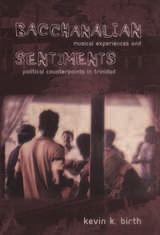 Bacchanalian Sentiments: Musical Experiences and Political Counterpoints in Trinidad
Kevin K. Birth
Duke University Press, 2008 Trinidad is known for its vibrant musical traditions, which reflect the island’s ethnic diversity. The annual Carnival, far and away the biggest event in Trinidad, is filled with soca and calypso music. Soca is a dance music derived from calypso, a music with African antecedents. In parang, a Venezuelan and Spanish derived folk music that dominates Trinidadian Christmas festivities, groups of singers and musicians progress from house to house, performing for their neighbors. Chutney is also an Indo-Caribbean music. In Bacchanalian Sentiments, Kevin K. Birth argues that these and other Trinidadian musical genres and traditions not only provide a soundtrack to daily life on the southern Caribbean island; they are central to the ways that Trinidadians experience and navigate their social lives and interpret political events. Birth draws on fieldwork he conducted in one of Trinidad’s ethnically diverse rural villages to explore the relationship between music and social and political consciousness on the island. He describes how Trinidadians use the affective power of music and the physiological experience of performance to express and work through issues related to identity, ethnicity, and politics. He looks at how the performers and audience members relate to different musical traditions. Turning explicitly to politics, Birth recounts how Trinidadians used music as a means of making sense of the attempted coup d’état in 1990 and the 1995 parliamentary election, which resulted in a tie between the two major political parties. Bacchanalian Sentiments is an innovative ethnographic analysis of the significance of music, and particular musical forms, in the everyday lives of rural Trinidadians.
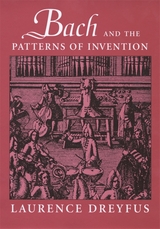 Bach and the Patterns of Invention
Laurence Dreyfus
Harvard University Press, 2004 In this major new interpretation of the music of J. S. Bach, we gain a striking picture of the composer as a unique critic of his age. By reading Bach’s music “against the grain” of contemporaries such as Vivaldi and Telemann, Laurence Dreyfus explains how Bach’s approach to musical invention in a variety of genres posed a fundamental challenge to Baroque aesthetics.
“Invention”—the word Bach and his contemporaries used for the musical idea that is behind or that generates a composition—emerges as an invaluable key in Dreyfus’s analysis. Looking at important pieces in a range of genres, including concertos, sonatas, fugues, and vocal works, he focuses on the fascinating construction of the invention, the core musical subject, and then shows how Bach disposes, elaborates, and decorates it in structuring his composition. Bach and the Patterns of Invention brings us fresh understanding of Bach’s working methods, and how they differed from those of the other leading composers of his day. We also learn here about Bach’s unusual appropriations of French and Italian styles—and about the elevation of various genres far above their conventional status.
Challenging the restrictive lenses commonly encountered in both historical musicology and theoretical analysis, Dreyfus provocatively suggests an approach to Bach that understands him as an eighteenth-century thinker and at the same time as a composer whose music continues to speak to us today.
 Bach: Essays on His Life and Music
Christoph Wolff
Harvard University Press, 1991 Johann Sebastian Bach holds a singular position in the history of music. A uniquely gifted musician, he combined outstanding performing virtuosity with supreme creative powers and remarkable intellectual discipline. More than two centuries after his lifetime, Bach’s work continues to set musical standards.
The noted Bach scholar Christoph Wolff offers in this book new perspectives on the composer’s life and remarkable career. Uncovering important historical evidence, the author demonstrates significant influences on Bach’s artistic development and brings fresh insight on his work habits, compositional intent, and the musical traditions that shaped Bach’s thought. Wolff reveals a composer devoted to an ambitious and highly individual creative approach, one characterized by constant self-criticism and self-challenge, the absorption of new skills and techniques, and the rethinking of riches from the musical past.
Readers will find illuminating analyses of some of Bach’s greatest music, including the B Minor Mass, important cantatas, keyboard and chamber compositions, the Musical Offering, and the Art of Fugue. Discussion of how these pieces “work” will be helpful to performers—singers, players, conductors—and to everyone interested in exploring the conceptual and contextual aspects of Bach’s music. All readers will find especially interesting those essays in which Wolff elaborates on his celebrated discoveries of previously unknown works: notably the fourteen “Goldberg” canons and a collection of thirty-three chorale preludes.
Representing twenty-five years of scholarship, these essays—half of which appear here in English for the first time—have established Christoph Wolff as one of the world’s preeminent authorities on J. S. Bach. All students, performers, and lovers of Bach’s music will find this an engaging and enlightening book.
Bach Perspectives, Volume 1
Edited by Russel Stinson
University of Illinois Press, 2025 Launched in 1995, Bach Perspectives has become the premier English-language serial book series dedicated to cutting-edge Bach scholarship. The University of Illinois Press now offers the first four volumes in open access editions available for free to all interested readers. In Volume One, Bach scholar Russell Stinson edits essays from Stephen A. Crist, Michael Marissen, David Schulenberg, and other experts. Topics range from issues of composition and improvisation to works like the Orgelbüchlein and the First Brandenburg Concerto. Contributors: James A. Brokaw II, Eric T. Chafe, Stephen A. Crist, Michael Marissen, David Schulenberg, and Russell Stinson
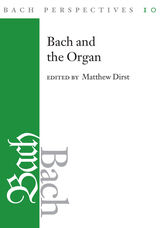 Bach Perspectives, Volume 10: Bach and the Organ
Matthew Dirst
University of Illinois Press, 2016 The official publication of the American Bach Society, Bach Perspectives pioneers new areas of research into the life, times, and music of the master composer. In Volume 10 of the series, Matthew Dirst edits a collection of groundbreaking essays exploring various aspects of Bach's organ-related activities. Lynn Edwards Butler reconsiders Bach's report on Johann Scheibe's organ at St. Paul's Church in Leipzig. Robin Leaver clarifies the likely provenance and purpose of a collection of chorale harmonizations copied in Dresden. George Stauffer investigates the ways various independent trio movements served Bach as an artist and teacher. In separate contributions, Christoph Wolff and Gregory Butler seek the origins of concerted Bach cantata movements spotlighting the organ and propose family trees of both parent works and offspring. Finally, Matthew Cron provides a broad cultural frame for such pieces and notes how their components engage in a larger discourse about the German Baroque organ's intimation of heaven.
 Bach Perspectives, Volume 11: J. S. Bach and His Sons
Edited by Mary Oleskiewicz
University of Illinois Press, 2017 Among his numerous children, Johann Sebastian Bach sired five musically gifted sons. The eleventh volume of Bach Perspectives presents essays that explore these men’s lives and careers via distinctive and, in several cases, alternative and interdisciplinary methodologies. Robert L. Marshall traces how each of the sons grappled with—and at times suffocated beneath—their illustrious father’s legacy. Mary Oleskiewicz’s essay investigates the Bach family’s connections to historical keyboard instruments and musical venues at the Prussian court, while David Schulenberg looks at Carl Philipp Emanuel Bach’s diverse and innovative keyboard works. Evan Cortens digs into everything from performance materials to pay stubs to offer a detailed view of the business of Carl Philipp Emanuel Bach’s liturgical music. Finally, Christine Blanken discusses how the rediscovery of Bach family musical manuscripts in the Breitkopf archive opens up new perspectives on familiar topics. A supplemental companion website is now available for Bach Perspectives 11. This resource features additional images, captions, and short descriptions to provide an essential supplement to the printed text.
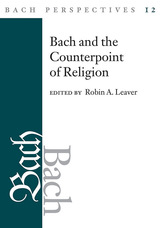 Bach Perspectives, Volume 12: Bach and the Counterpoint of Religion
Edited by Robin A. Leaver
University of Illinois Press, 2018 Johann Sebastian Bach was a Lutheran and much of his music was for Lutheran liturgical worship. As these insightful essays in the twelfth volume of Bach Perspectives demonstrate, he was also influenced by--and in turn influenced--different expressions of religious belief. The vocal music, especially the Christmas Oratorio, owes much to medieval Catholic mysticism, and the evolution of the B minor Mass has strong Catholic connections. In Leipzig, Catholic and Lutheran congregations sang many of the same vernacular hymns. Internal squabbles were rarely missing within Lutheranism, for example Pietists' dislike of concerted church music, especially if it employed specific dance forms. Also investigated here are broader issues such as the close affinity between Bach's cantata libretti and the hymns of Charles Wesley; and Bach's music in the context of the Jewish Enlightenment as shaped by Protestant Rationalism in Berlin. Contributors: Rebecca Cypess, Joyce L. Irwin, Robin A. Leaver, Mark Noll, Markus Rathey, Derek Stauff, and Janice B. Stockigt.
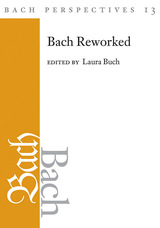 Bach Perspectives, Volume 13: Bach Reworked
Edited by Laura Buch
University of Illinois Press, 2020 Scholars and performers have long noted J.S. Bach's abundant use of parody procedures: that is, the recycling and reworking of pre-existing material from his own compositions or from other sources. Laura Buch edits essays exploring how the composer parodied the work of others and how other composers did the same with him. The contributors delve into the works of Baroque-era composers from Bach himself to C. P. E. Bach, Johann Caspar Ferdinand Fischer, and Ferruccio Busoni. But they also cast a wider net, investigating the ways Bach's music cross-pollinates with contemporary composer-performers John Lewis and the Modern Jazz Quartet, and keyboardist Bernie Worrell and Parliament-Funkadelic. The diverse contexts illuminate a broad range of parody techniques, from structural scaffolding and contrapuntal elaboration to integration with stylistic languages far removed from the Baroque.
An insightful look at how composers build on each other's work, Bach Reworked reveals how nuanced understandings of parody procedures can fuel both musical innovation and historically informed performance.
Contributors: Stephen A. Crist, Ellen Exner, Moira Leanne Hill, Erinn E. Knyt, and Markus Zepf
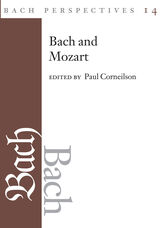 Bach Perspectives, Volume 14: Bach and Mozart: Connections, Patterns, and Pathways
Edited by Paul Corneilson
University of Illinois Press, 2022 Today, the names Bach and Mozart are mostly associated with Johann Sebastian Bach and Wolfgang Amadeus Mozart. But this volume of Bach Perspectives offers essays on the lesser-known musical figures who share those illustrious names alongside new research on the legendary composers themselves. Topics include the keyboard transcriptions of J. S. Bach and Johann Gottfried Walther; J. S. Bach and W. A. Mozart's freelance work; the sonatas of C. P. E. Bach and Leopold Mozart; the early musical training given J. C. Bach by his father and half-brother; the surprising musical similarities between J. C. Bach and W. A. Mozart; and the latest documentary research on Mozart’s 1789 visit to the Thomasschule in Leipzig. An official publication of the American Bach Society, Bach Perspectives, Volume 14 draws on a variety of approaches and a broad range of subject matter in presenting a new wave of innovative classical musical scholarship. Contributors: Eleanor Selfridge-Field, Yoel Greenberg, Noelle M. Heber, Michael Maul, Stephen Roe, and David Schulenberg
Bach Perspectives, Volume 2: J. S. Bach, the Breitkopfs, and Eighteenth-Century Music Trade
Edited by George B. Stauffer
University of Illinois Press, 2025 Launched in 1995, Bach Perspectives has become the premier English-language serial book series dedicated to cutting-edge Bach scholarship. The University of Illinois Press now offers the first four volumes in open access editions available for free to all interested readers. From 1727 to 1787, the Bach and the Breitkopf families enjoyed close professional ties forged by the growing trade between music composers and music printers. The second volume of Bach Perspectives examines the inventive and far-flung activities of the Breitkopf firm from the vantage point of its commerce with J. S. Bach and his relatives. Contributors: Gregory G. Butler, Robert M. Cammarota, Peggy Daub, Andreas Glöckner, George R. Hill, Yoshitake Kobayashi, Ortrun Landmann, Ernest May, Hans-Joachim Schulze, George B. Stauffer, and Neal Zaslaw
Bach Perspectives, Volume 3: Creative Responses to Bach, from Mozart to Hindemith
Edited by Michael Marissen.
University of Illinois Press, 2025 Launched in 1995, Bach Perspectives has become the premier English-language serial book series dedicated to cutting-edge Bach scholarship. The University of Illinois Press now offers the first four volumes in open access editions available for free to all interested readers. The third volume of the acclaimed series features a roster of scholars analyzing the crucial influence of J. S. Bach’s music upon compositions by Mozart, Beethoven, Brahms, Hindemith, and others. Throughout, the contributors highlight Bach’s subtle presence in the history of composition and illuminate the intertwined works of Bach and his successors. Contributors: Thomas Christensen, Ludwig Finscher, Walter Frisch, Stephen Hinton, William Kinderman, and Robert L. Marshall
Bach Perspectives, Volume 4: The Music of J. S. Bach: Analysis and Interpretation
Edited by David Schulenberg
University of Illinois Press, 2025 Launched in 1995, Bach Perspectives has become the premier English-language serial book series dedicated to cutting-edge Bach scholarship. The University of Illinois Press now offers the first four volumes in open access editions available for free to all interested readers. The fourth volume of Bach Perspectives analyzes J. S. Bach’s orchestral works, especially his concertos, and the interpretation and performance of his music in general. The diverse contributors come from the fields of performance, organology, music theory, and music history, and their expertise across multiple areas provides an interdisciplinary perspective to their chapters. Contributors: Gregory G. Butler, John Butt, John Koster, Alfred Mann, Mary Oleskiewicz, William Renwick, David Schulenberg, Jeanne Swack, and Paul Walker
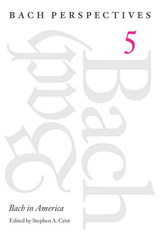 Bach Perspectives, Volume 5: Bach in America
Edited by Stephen A. Crist
University of Illinois Press, 2002 More than a century passed after Johann Sebastian Bach's death in 1750 before his music found an audience in the United States. Volume Five in the Bach Perspectives series tracks the composer's reputation in America from obscure artist to a cultural mainstay whose music has spread to all parts of the country. Barbara Owen surveys Bach's early reception in America. Matthew Dirst focuses on John Sullivan Dwight's role in advocating Bach's work. Michael Broyles considers Bach's early impact in Boston while Mary J. Greer offers a counterpoint in her study of Bach's reception in New York. Hans-Joachim Schulze's essay links the American descendants of August Reinhold Bach to the composer. Christoph Wolff also focuses on Bach's descendants in America, particularly Friederica Sophia Bach, the daughter of Bach's eldest son. Peter Wollny evaluates manuscripts not included in Gerhard Herz's study of Bach Sources in America. The volume concludes with Carol K. Baron's comparison of Bach with Charles Ives while Stephen A. Crist measures Bach's influence on the jazz icon Dave Brubeck.
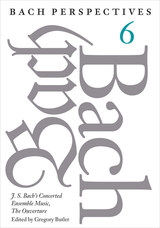 Bach Perspectives, Volume 6: J. S. Bach's Concerted Ensemble Music, The Ouverture
Edited by Gregory Butler
University of Illinois Press, 2005 The sixth volume in the Bach Perspectives series opens with Joshua Rifkin's seminal study of the early source history of the B-minor orchestral suite. Rifkin elaborates on his discovery that the work in its present form for solo flute goes back to an earlier version in A minor, ostensibly for solo violin. He also takes the discovery as the point of departure for a wide-ranging discussion of the origins and extent of Bach's output in the area of concerted ensemble music. In other essays, Jeanne Swack presents an enlightening comparison of Georg Phillip Telemann's and Bach's approach to the French overture as concerted movements in their church cantatas. Steven Zohn views the B-minor orchestral suite from the standpoint of the "concert en ouverture." In addition, Zohn responds to Rifkin by suggesting Bach may have scored the early version of the B-minor orchestral suite for flute.
 Bach Perspectives, Volume 7: J. S. Bach's Concerted Ensemble Music: The Concerto
Edited by Gregory Butler
University of Illinois Press, 2007 J. S. Bach's creativity is so overwhelming his compositions in some genres eclipse his work in others. His glorious choral works, profound organ compositions, and exquisite solo compositions for violin and cello attract the most attention. Volume Seven of Bach Perspectives restores Bach's concertos to their rightful place of honor. Gregory Butler focuses on Bach's Concerto for Harpsichord and Strings in E Major (BWV 1053) as a pastiche created by a process of assemblage of three earlier heterogeneous movements. Pieter Dirksen delves into the source history of the Concerto for Harpsichord and Strings in F Minor (BWV 1056) and concludes it represents a transcription of an earlier violin concerto in G minor. David Schulenberg investigates the generic ambiguity of the concerto in the early eighteenth century and how it diverged from the sonata to become a distinct genre. Completing the volume is Christoph Wolff's examination of the ""Siciliano"" as a slow movement in Bach's concertos and its implications for the source history of his Concerto for Harpsichord and Strings in E Major (BWV 1053).
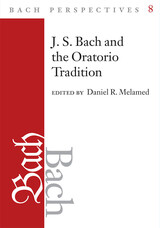 Bach Perspectives, Volume 8: J.S. Bach and the Oratorio Tradition
Edited by Daniel R. Melamed
University of Illinois Press, 2011 As the official publication of the American Bach Society, Bach Perspectives has pioneered new areas of research in the life, times, and music of Bach since its first appearance in 1995. Volume 8 of Bach Perspectives emphasizes the place of Bach's oratorios in their repertorial context. These essays consider Bach's oratorios from a variety of perspectives: in relation to models, antecedents, and contemporary trends; from the point of view of musical and textual types; and from analytical vantage points including links with instrumental music and theology. Christoph Wolff suggests the possibility that Bach's three festive works for Christmas, Easter, and Ascension Day form a coherent group linked by liturgy, chronology, and genre. Daniel R. Melamed considers the many ways in which Bach's passion music was influenced by the famous poetic passion of Barthold Heinrich Brockes. Markus Rathey examines the construction and role of oratorio movements that combine chorales and poetic texts (chorale tropes). Kerala Snyder shows the connections between Bach's Christmas Oratorio and one of its models, Buxtehude's Abendmusiken spread over many evenings. Laurence Dreyfus argues that Bach thought instrumentally in the composition of his passions at the expense of certain aspects of the text. And Eric Chafe demonstrates the contemporary theological background of Bach's Ascension Oratorio and its musical realization
 Bach Perspectives, Volume 9: J.S. Bach and His Contemporaries in Germany
Edited by Andrew Talle
University of Illinois Press, 2013 This provocative addition to the Bach Perspectives series offers a counternarrative to the isolated genius status that J. S. Bach and his music currently enjoy. Contributors contextualize Bach by examining the output, reputation, and compositional practices of his contemporaries in Germany whose work was widely played and enjoyed in his time, including Georg Philipp Telemann, Christoph Graupner, Gottlieb Muffat, and Johann Adolf Scheibe. Essays place Bach and his work in relation to his peers, examining avenues of composition they took while he did not and showing how differing treatments of the same subjects or texts resulted in markedly different compositional results and legacies. By looking closely at how Bach's contemporaries addressed the tasks and challenges of their time, this project provides a more nuanced view of the musical world of Bach's time while revealing in more specific terms than ever how and why Bach's own music remains fresh and compelling. In this volume, Wolfgang Hirschmann proposes an ethnographic approach that contextualizes Bach's works, addressing the aesthetic paths he took as well as those he did not pursue. Steven Zohn's essay considers Telemann's contribution to the orchestral Ouverture genre, observering how Telemann's approach to integrating the national styles of his time was quite different from, but no less rich than, Bach's. Andrew Talle compares settings and strategies of Vergnügte Ruh, beliebte Seelenlust by Bach and Graupner. Alison Dunlop presents valuable primary research on Muffat, the most commonly cited keyboard music composer in Vienna during Bach's lifetime. Finally, Michael Maul sheds new light on the Scheibe-Birnbaum controversy, contextualizing the most famous critique of J. S. Bach's compositional style by discussing the other composers that Scheibe critiqued.
Bachelor Bess: The Homesteading Letters of Elizabeth Corey, 1909-1919
Philip L. Gerber
University of Iowa Press, 1990 In July 1909 twenty-one-year-old Elizabeth Corey left her Iowa farm to stake her claim to a South Dakota homestead. Over the next ten years, as she continued her schoolteaching career and carved out a home for herself in this inhospitable territory, she sent a steady stream of letters to her family back in Iowa. From the edge of modern America, Bess wrote long, gossipy accounts—"our own continuing adventure story," according to her brother Paul—of frontier life on the high plains west of the Missouri River. Irrepressible, independent-minded, and evidently fearless, the self-styled Bachelor Bess gives us a firsthand, almost daily account of her homesteading adventures. We can all stake a claim in her energetic letters.
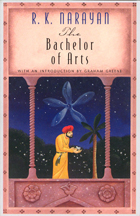 The Bachelor of Arts
R. K. Narayan
University of Chicago Press, 1978 "There are writers—Tolstoy and Henry James to name two—whom we hold in awe, writers—Turgenev and Chekhov—for whom we feel a personal affection, other writers whom we respect—Conrad for example—but who hold us at a long arm's length with their 'courtly foreign grace.' Narayan (whom I don't hesitate to name in such a context) more than any of them wakes in me a spring of gratitude, for he has offered me a second home. Without him I could never have known what it is like to be Indian."—Graham Greene
Offering rare insight into the complexities of Indian middle-class society, R. K. Narayan traces life in the fictional town of Malgudi. The Dark Room is a searching look at a difficult marriage and a woman who eventually rebels against the demands of being a good and obedient wife. In Mr. Sampath, a newspaper man tries to keep his paper afloat in the face of social and economic changes sweeping India. Narayan writes of youth and young adulthood in the semiautobiographical Swami and Friends and The Bachelor of Arts. Although the ordinary tensions of maturing are heightened by the particular circumstances of pre-partition India, Narayan provides a universal vision of childhood, early love and grief.
"The experience of reading one of his novels is . . . comparable to one's first reaction to the great Russian novels: the fresh realization of the common humanity of all peoples, underlain by a simultaneous sense of strangeness—like one's own reflection seen in a green twilight."—Margaret Parton, New York Herald Tribune
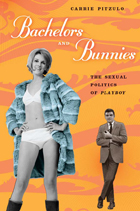 Bachelors and Bunnies: The Sexual Politics of Playboy
Carrie Pitzulo
University of Chicago Press, 2011 For a lot of people, thoughts about the sexual politics of Playboy run along the lines of what Gloria Steinem reportedly once told Hugh Hefner: “A woman reading Playboy feels a little like a Jew reading a Nazi manual.” Hefner’s magazine celebrates men as swinging bachelors and women as objects of desire; ergo, it’s sexist.
Not so fast, says Carrie Pitzulo. With Bachelors and Bunnies, she delves into the history of the magazine to reveal its surprisingly strong record of support for women’s rights and the modernization of sexual and gender roles. Taking readers behind the scenes of Playboy’s heyday, Pitzulo shows how Hefner’s own complicated but thoughtful perspective on modern manhood, sexual liberation, and feminism played into debates—both in the editorial offices and on the magazine’s pages—about how Playboy’s trademark “girl next door” appeal could accommodate, acknowledge, and even honor the changing roles and new aspirations of women in postwar America. Revealing interviews with Hugh Hefner and his daughter (and later Playboy CEO) Christie Hefner, as well as with a number of editors and even Playmates, show that even as the magazine continued to present a romanticized notion of gender difference, it again and again demonstrated a commitment to equality and expanded opportunities for women.
Offering a surprising new take on a twentieth-century icon, Bachelors and Bunnies goes beyond the smoking jacket and the centerfold to uncover an unlikely ally for the feminist cause.
The Bachelors' Ball: The Crisis of Peasant Society in Béarn
Pierre Bourdieu
University of Chicago Press, 2008 Over the past four decades, French sociologist Pierre Bourdieu produced one of the most imaginative and subtle bodies of social theory of the postwar era. When he died in 2002, he was considered to be the most influential sociologist in the world and a thinker on a par with Foucault and Lévi-Strauss—a public intellectual as important to his generation as Sartre was to his. Bourdieu’s final book, The Bachelors’ Ball, sees him return to Béarn, the region where he grew up, to examine the gender dynamics of rural France. This personal connection adds poignancy to Bourdieu’s ethnographic account of the way the influence of urban values has precipitated a crisis for male peasants. Tied to the land through inheritance, these bachelors find themselves with little to offer the women of Béarn who, like the young Bourdieu himself, abandon the country for the city in droves.
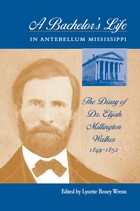 A Bachelor's Life In Antebellum Mississippi: The Diary of Dr. Elijah Millington Walker, 1849-1852
Lynette Boney Wrenn
University of Tennessee Press, 2004
“This is a splendid diary of a man and physician during the late antebellum years, sure to interest not only historians of medicine but also historians of gender, the South, and antebellum politics. . . . An exceptionally useful historical document as well as a good read.” —Steven M. Stowe, Indiana University
Elijah Millington Walker began to keep a diary midway through his medical apprenticeship in Oxford, Mississippi. He composed a lengthy preface to the diary, in which he remembered his life from the time of his family’s arrival in north Mississippi in 1834, when he was ten years old, until late 1848, when the University of Mississippi opened and Walker’s diary begins.
On one level, the diary records the life of a bachelor, chronicling the difficulties of an ambitious young physician who would like to marry but is hampered by poverty and his professional aspirations. Walker details the qualities he desires in a wife and criticizes women who do not measure up; a loyal wife, in Walker’s highly romanticized image, remains a true helpmeet even to the most debased drunkard. On another level, Walker describes various medical cases, giving readers an idea of the kinds of diseases prevalent in the lower South at mid-century, as well as their treatment by orthodox physicians. In this vivid chronicle of everyday life in antebellum Mississippi, Walker also finds space to comment on a wide range of topics that affected the state and the region, including pioneer life in north Mississippi, evangelical Protestantism, the new state university at Oxford, the threat of secession in 1849–50, Henry Clay’s Compromise of 1850, foreign affairs, and local railroad development. A strong defender of the Union at mid-century, Walker nonetheless defended slavery and distinctively Southern institutions.
A Bachelor’s Life in Antebellum Mississippi brings to the public one of the few diaries of a very intelligent yet “ordinary” man, a non-elite member of a society dominated by a planter aristocracy. The author’s frankness and flair for writing reflect a way of life not often seen; this volume will thus prove a valuable addition to the body of primary documents from the early republic.
Lynette Boney Wrenn has taught history at Memphis State University and Southwestern College. She is the author of Crisis and Commission Government in Memphis: Elite Rule in a Gilded Age City and Cinderella of the New South: A History of the Cottonseed Industry, 1855–1955. Wrenn lives in Greensboro, North Carolina.
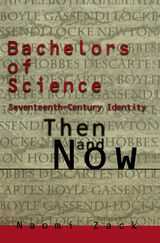 Bachelors of Science: Seventeenth Century Identity, Then and Now
Naomi Zack
Temple University Press, 1996 Naomi Zack begins this extraordinary book with the premise that if one is to understand Western conceptions of racialized and gendered identity, one needs to go back to a period when such categories were not salient and examine how notions of identity in the seventeenth century were fundamentally different from subsequent constructions. The seventeenth century is the last time, for example, that Europeans had any contact with non-Europeans without racializing them. From the eighteenth century onward, race becomes a central category for Europeans in their transactions with a different world, and gender undergoes radical transformation.
Zack takes the reader through a lucid tour of the lives, times, and writings of such key "bachelors of Science" as Bacon, Descartes, Newton, and Gassendi. The book situates these empiricist philosophers and their canonical reputations within the larger framework of the de facto "masculinization of science" and "scientizing of masculinity" in the seventeenth century, arguing for a more nuanced understanding of these key thinkers of the period.
Other fascinating issues examined in this book include pre-racial conceptions of slavery, witchcraft trials and their connection to homosociality, and the highly sexualized nature of women's identity in the seventeenth century. Zack points out the link between elite bachelorhood, the profession of philosophy, and scientific pursuit as recreational activity. This book is a must for understanding the historical and philosophical precedents of modern scientific identity, race, and gender.
Bach’s Continuo Group: Players and Practices in His Vocal Works
Laurence Dreyfus
Harvard University Press, 1987 When Bach’s cantatas, masses, passions, and chorales were originally performed under the composer’s direction, which instruments played the basso continuo, the line that establishes the harmonic framework? Bach’s Continuo Group answers this and other fundamental questions and probes the rationale behind Baroque performance conventions.
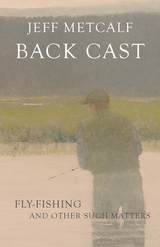 Back Cast: Fly-Fishing and Other Such Matters
Jeff Metcalf
University of Utah Press, 2018 A storyteller and avid fly fisherman, Jeff Metcalf is, for compelling personal reasons, an enhanced observer of the human condition, who finds himself often in the streams of the American West. Not only rivers run through his essays, his cancer does too. But so do camaraderie, adventures, reveling in nature and outdoor devotions, and the sheer bliss of focused engagement with the fish and the cast. Metcalf’s keenly observed companions are river guides, small-town locals, academics, and other city folk, all like him among those who run to the river for solace and joy.
These essays are much more than fish stories; they reveal the community and communion of fishing and the bonds to place the author nurtured through it. Whether he recalls carousing and tale-swapping with friends or excellence found through the challenge of the cast, Metcalf’s words, sometimes roiling and turbulent, sometimes calm and reflective, like a western river, vividly convey the pull of the steelhead and the fight for survival. Whether or not you fish, Metcalf’s sharp-eyed, open and honest look at life will draw you in.
"These waters have been my home, and I fish them more than most. In truth, they have saved my life on more than a few occasions. I seek refuge in the quiet solitude of rivers, and in dark hours of my life—including this particular year—I need desperately to be fly-fishing." —From the book
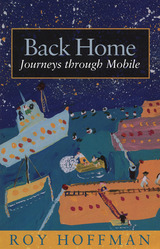 Back Home: Journeys through Mobile
Roy Hoffman
University of Alabama Press, 2007 After twenty years in New York City, a prize-winning writer takes a "long look back" at his hometown of Mobile, Alabama. In Back Home: Journeys through Mobile, Roy Hoffman tells stories—through essays, feature articles, and memoir—of one of the South's oldest and most colorful port cities. Many of the pieces here grew out of Hoffman's work as Writer-in-Residence for his hometown newspaper, the Mobile Register, a position he took after working in New York City for twenty years as a journalist, fiction writer, book critic, teacher, and speech writer. Other pieces were first published in the New York Times, Southern Living, Preservation, and other publications. Together, this collection comprises a long, second look at the Mobile of Hoffman's childhood and the city it has since become. Like a photo album, Back Home presents close-up portraits of everyday places and ordinary people. There are meditations on downtown Mobile, where Hoffman's grandparents arrived as immigrants a century ago; the waterfront where longshoremen labor and shrimpers work their nets; the back roads leading to obscure but intriguing destinations. Hoffman records local people telling their own tales of race relations, sports, agriculture, and Mardi Gras celebrations. Fishermen, baseball players, bakers, authors, political figures--a strikingly diverse population walks across the stage of Back Home. Throughout, Hoffman is concerned with stories and their enduring nature. As he writes, "When buildings are leveled, when land is developed, when money is spent, when our loved ones pass on, when we take our places a little farther back every year on the historical time-line, what we have still are stories."
Back in School: How Student Parents Are Transforming College and Family
A. Fiona Pearson
Rutgers University Press, 2019 Fifty years ago, students who were parents were a rarity in college classrooms, but by the beginning of the twenty-first century, over a quarter of all undergraduate students were parents. In Back in School, A. Fiona Pearson explores how these student parents navigate cultural norms and institutional resources, forging pathways as they journey to become better parents and successful students. Back in School examines how policy makers, professors, college administrators, counselors, and social workers provide or deny access to child care, tutoring, financial aid, or other campus- or community-based resources. Pearson further explores how social norms and governmental and organizational policies influence access to these resources and student parents’ experiences on campus and at home.
Back of the Yards: The Making of a Local Democracy
Robert A. Slayton
University of Chicago Press, 1986 "Robert A. Slayton's Back of the Yards is one of the finest accounts I have ever read on an urban, working-class neighborhood in twentieth-century America. Its focus on family, politics, and worklife is penetrating and its conclusions reinforce an emerging scholarly picture of ordinary people exercising unique forms of power."—John Bodnar, author of The Transplanted: A History of Immigrants in Urban America
 BACK ON THE ROAD TO SERFDOM: The Resurgence of Statism
Thomas Woods
Intercollegiate Studies Institute, 2010
Leviathan is back
The threat of statism has reemerged in force. The federal government has seized on the economic crisis to radically expand its power—through bailouts, “stimulus” packages, a trillion-dollar health care plan, “jobs bills,” massive expansions of the money supply, and much more. But such interventionism did not suddenly materialize with the recent collapse. The dangerous trends of government growth, debt increases, encroachments on individual liberty, and attacks on the free market began years earlier and continued no matter which political party was in power.
This shift toward statism “will not end happily,” declares bestselling author Thomas E. Woods. In Back on the Road to Serfdom, Woods brings together ten top scholars to examine why the size and scope of government has exploded, and to reveal the devastating consequences of succumbing to the statist temptation.
Spanning history, economics, politics, religion, and the arts, Back on the Road to Serfdom shows: ul>
•How government interventionism endangers America’s prosperity and the vital culture of entrepreneurship
•The roots of statism: from the seminal conflict between Thomas Jefferson and Alexander Hamilton to the vast expansion of federal power in the twentieth century
•Why the standard explanation for the recent economic crisis is so terribly wrong—and why the government’s frenzied responses to the downturn only exacerbate the problems
•Why the European welfare state is not a model to aspire to but a disaster to be avoided
•How an intrusive state not only harms the economy but also imperils individual liberty and undermines the role of civil society
•The fatal flaws in the now-common arguments against free markets and free trade
•How big business is helping government pave the road to serfdom
•Why the Judeo-Christian tradition does not demand support for the welfare state, but in fact values the free market
•How the arrogance of government power extends even to the cultural realm—and how central planning is just as inefficient and destructive there
It’s been more than sixty-five years since F. A. Hayek published his seminal work The Road to Serfdom. Now this impeccably timed book provides another desperately needed warning about—and corrective to—the dangers of statism.
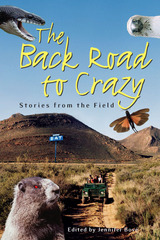 Back Road To Crazy: Stories From The Field
Jennifer Bove
University of Utah Press, 2005 Strap on your snake chaps and slap on some sunscreen as biologist Jennifer Bové takes you out to the field in the company of biologists working on the frontlines of wildlife studies, botany, and resource management. This exuberant and entertaining collection of stories ranges from Myanmar to the Midwest, from Argentina to Alaska and many points in between, offering tales that are by turns thoughtful, funny, tragic, and just-plain-crazy.
During five years of working in snake-ridden sloughs and rough northern seas, Jennifer Bové often asked herself 'Why am I doing this?' Realizing her own experiences were only the tip of the iceberg, she invited friends and colleagues to answer the same question. The result is stories that include deadly snakebites, a plague of marmots, special delivery skunk oil, bald eagle wrangling, and a mountain goat loose in the galley of a research vessel. These adventures are the details behind the data collected by these men and women driven to unlock nature’s truths. In The Back Road to Crazy, seasoned researchers and novices alike reveal the impulse to trade the comfort of a more sheltered career for demanding physical labor, whims of weather, and the company of unruly creatures.
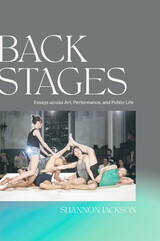 Back Stages: Essays across Art, Performance, and Public Life
Shannon Jackson
Northwestern University Press, 2022 Shannon Jackson explores a range of disciplinary, institutional, and political puzzles that engage the social and aesthetic practice of performance in this collection of twenty essential essays spanning her career. Back Stages starts by considering the historical connection between performance practice and movements of social reform, while later writings analyze disciplinary debates on the place of performance in higher education and within the contemporary field of socially engaged art, tracking fraught and allied relationships to literary studies, art history, visual culture, theater, social theory, and critical theory.
At a time of increased aesthetic experimentation and political debate within the art world, these essays alight on artists, groups, and cultural organizations whose experiments have challenged conventions of curation and critique, including Theaster Gates, Paul Ramírez Jonas, Harrell Fletcher, and My Barbarian. Throughout, Jackson navigates the political ambivalences of performance, from the late nineteenth to the twenty-first century, tracking shifts in participatory art that seek to resist capitalism, even as such performance work paradoxically risks neoliberal appropriation by a post-Fordist experience economy.
Back Stages surfaces unexpected cross-disciplinary connections and provides new opportunities for mutual engagement within a wide network of educational, artistic, and civic sectors. A substantial introduction excavates the critical links between the essays and a variety of disciplines and movements.
Back Talk: Teaching Lost Selves to Speak
Joan Weimer
University of Chicago Press, 1996 Joan Weimer had spent three years researching the life of nineteenth-century novelist Constance Fenimore Woolson for a critical biography when a devastating back injury left her virtually immobile. Pain reshaped her research as she discovered more about Woolson's writing, family, and grief. The imaginative relationship she developed with Woolson—chronicled in this heart-felt book— helped Weimer to escape her physical disability as she wrestled with the question of how to redefine herself.
In this elegant, humorous, and brutally frank memoir, Weimer's discoveries—documentative and imaginative, historical and personal—reveal much about what motivates research, and what motivates healing.
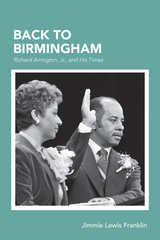 Back To Birmingham: Richard Arrington, Jr., and His Times
Jimmie Lewis Franklin
University of Alabama Press, 1989 The story of Richard Arrington Jr., the first African American mayor of Birmingham, Alabama
During the 1960s, Birmingham, Alabama was the central battleground in the struggle for human rights in the American South. As one of the most segregated cities in the United States, the city of Birmingham became infamous for its suppression of civil rights and for official and vigilante violence against its African American citizens, most notoriously the use of explosives in the Sixteenth Street Baptist Church bombing and the bombing of the home of Reverend Fred Shuttlesworth.
In October of 1979, Birmingham elected its first Black mayor, Richard Arrington Jr. He was born in the rural town of Livingston, Alabama. His family moved to Birmingham when he was a child. A man of quiet demeanor, he was nevertheless destined to bring to fruition many of the fundamental changes that the Civil Rights Movement had demanded. This is his story. Not a conventional political or Civil Rights history, Back to Birmingham is the story of a man who demonstrated faith in his region and people. The work illuminates Arrington's sense of place, a quality that enables a person to claim sentimentally a portion of the natural and human environment. Franklin passionately underscores the importance of the attachment of Southern Blacks to their land and place.
Back to Birmingham will appeal to both the general reader and the serious student of American society. The book endeavors to bridge the gap between popular and scholarly history. It is guided by the assumption that Americans of whatever description can find satisfaction in comprehending social change and that they are buoyed by the individual triumph of those who beat the odds.
 Back to Bizkaia: A Basque-American Memoir
Vince J. Juaristi
University of Nevada Press, 2011 Nevada sheep rancher Joe Juaristi spoke for years about making a trip back to the Spanish Basque Country that he left sixty years earlier, but each time the subject came up the discussion evolved into a family debate about the scope and members of the journey. Finally Joe's son, Vince, secretly resolved to organize the trip that his father wanted and needed--the two of them, traveling alone, making a quiet reunion with Joe's twin sister, who suffers from Alzheimer's, visiting other aging siblings and friends, and recounting the places that formed Joe's memories of his youth. Back to Bizkaia is part travel book, part memoir of two men exploring their mutual roots and their unique father-son bond. The narrative intertwines an engaging account of the contemporary Basque Country with Joe's experiences as an immigrant making his way in a new country and Vince's memories of growing up in a close Basque-American community in the American West. This is a book about Basques and their American families, but on another level it is every immigrant's story of return to a beloved homeland.
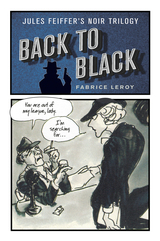 Back to Black: Jules Feiffer’s Noir Trilogy
Fabrice Leroy
Rutgers University Press, 2025 The legendary American cartoonist and author Jules Feiffer has enjoyed a long and varied career, working on everything from illustrating The Phantom Tollbooth to writing the screenplay for the film Popeye. But some of his most innovative work came very late in his career, with a trio of graphic novels he composed in his eighties: Kill My Mother (2014), Cousin Joseph (2016), and The Ghost Script (2018).
Back to Black provides the first full-length critical analysis of this trilogy, exploring how it pays homage to the iconography and themes of film noir through constant graphic experimentation and a striking reinvention of Feiffer’s distinctive style. Fabrice Leroy shows how Feiffer deftly alternates between dramatic and satirical tones as he plays with the conventions of noir to provide a caustic yet moving commentary on mid-twentieth-century American life. Through close readings of each novel in the trilogy, he examines Feiffer’s singular depiction of the central political issues in the United States from the Great Depression to the 1950s, which still resonate today: unionization struggles, cinematic propaganda, McCarthyism, the American Dream, immigration, antisemitism, civil rights, and gender discrimination. Placing the noir trilogy into the context of Feiffer’s long career, Back to Black demonstrates how he offers a loving pastiche of the genre without losing his unique voice or critical edge.
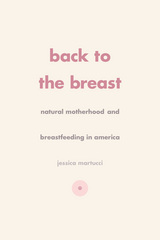 Back to the Breast: Natural Motherhood and Breastfeeding in America
Jessica Martucci
University of Chicago Press, 2015 After decades of decline during the twentieth century, breastfeeding rates began to rise again in the 1970s, a rebound that has continued to the present. While it would be easy to see this reemergence as simply part of the naturalism movement of the ’70s, Jessica Martucci reveals here that the true story is more complicated. Despite the widespread acceptance and even advocacy of formula feeding by many in the medical establishment throughout the 1940s, ’50s, and ’60s, a small but vocal minority of mothers, drawing upon emerging scientific and cultural ideas about maternal instinct, infant development, and connections between the body and mind, pushed back against both hospital policies and cultural norms by breastfeeding their children. As Martucci shows, their choices helped ideologically root a “back to the breast” movement within segments of the middle-class, college-educated population as early as the 1950s.
That movement—in which the personal and political were inextricably linked—effectively challenged midcentury norms of sexuality, gender, and consumption, and articulated early environmental concerns about chemical and nuclear contamination of foods, bodies, and breast milk. In its groundbreaking chronicle of the breastfeeding movement, Back to the Breast provides a welcome and vital account of what it has meant, and what it means today, to breastfeed in modern America.
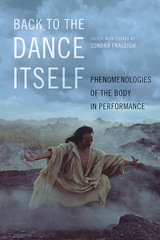 Back to the Dance Itself: Phenomenologies of the Body in Performance
Edited with Essays by Sondra Fraleigh
University of Illinois Press, 2018 In Back to the Dance Itself, Sondra Fraleigh edits essays that illuminate how scholars apply a range of phenomenologies to explore questions of dance and the world; performing life and language; body and place; and self-knowing in performance. Some authors delve into theoretical perspectives, while others relate personal experiences and reflections that reveal fascinating insights arising from practice. Collectively, authors give particular consideration to the interactive lifeworld of making and doing that motivates performance. Their texts and photographs study body and the environing world through points of convergence, as correlates in elemental and constant interchange modeled vividly in dance. Selected essays on eco-phenomenology and feminism extend this view to the importance of connections with, and caring for, all life. Contributors: Karen Barbour, Christine Bellerose, Robert Bingham, Kara Bond, Hillel Braude, Sondra Fraleigh, Kimerer LaMothe, Joanna McNamara, Vida Midgelow, Ami Shulman, and Amanda Williamson.
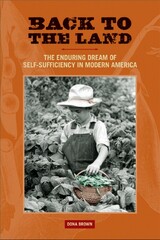 Back to the Land: The Enduring Dream of Self-Sufficiency in Modern America
Dona Brown
University of Wisconsin Press, 2011 For many, “going back to the land” brings to mind the 1960s and 1970s—hippie communes and the Summer of Love, The Whole Earth Catalog and Mother Earth News. More recently, the movement has reemerged in a new enthusiasm for locally produced food and more sustainable energy paths. But these latest back-to-the-landers are part of a much larger story. Americans have been dreaming of returning to the land ever since they started to leave it. In Back to the Land, Dona Brown explores the history of this recurring impulse. ? Back-to-the-landers have often been viewed as nostalgic escapists or romantic nature-lovers. But their own words reveal a more complex story. In such projects as Gustav Stickley’s Craftsman Farms, Frank Lloyd Wright’s “Broadacre City,” and Helen and Scott Nearing’s quest for “the good life,” Brown finds that the return to the farm has meant less a going-backwards than a going-forwards, a way to meet the challenges of the modern era. Progressive reformers pushed for homesteading to help impoverished workers get out of unhealthy urban slums. Depression-era back-to-the-landers, wary of the centralizing power of the New Deal, embraced a new “third way” politics of decentralism and regionalism. Later still, the movement merged with environmentalism. To understand Americans’ response to these back-to-the-land ideas, Brown turns to the fan letters of ordinary readers—retired teachers and overworked clerks, recent immigrants and single women. In seeking their rural roots, Brown argues, Americans have striven above all for the independence and self-sufficiency they associate with the agrarian ideal. Best Books for General Audiences, selected by the American Association of School Librarians
Back to the Roots: Memory, Inequality, and Urban Agriculture
Sara Shostak
Rutgers University Press, 2021 Across the Commonwealth of Massachusetts, urban farmers and gardeners are reclaiming cultural traditions linked to food, farming, and health; challenging systemic racism and injustice in the food system; demanding greater community control of resources in marginalized neighborhoods; and moving towards their visions of more equitable urban futures. As part of this urgent work, urban farmers and gardeners encounter and reckon with both the cultural meanings and material legacies of the past. Drawing on their narratives, Back to the Roots demonstrates that urban agriculture is a critical domain for explorations of, and challenges to, the long standing inequalities that shape both the materiality of cities and the bodies of their inhabitants.
Back to the Rough Ground: Practical Judgment and the Lure of Technique
Joseph Dunne
University of Notre Dame Press, 1993 Back to the Rough Ground is a philosophical investigation of practical knowledge, with major import for professional practice and the ethical life in modern society. Its purpose is to clarify the kind of knowledge that informs good practice in a range of disciplines such as education, psychotherapy, medicine, management, and law. Through reflection on key modern thinkers who have revived cardinal insights of Aristotle, and a sustained engagement with the Philosopher himself, it presents a radical challenge to the scientific assumptions that have dominated how these professional domains have been conceived, practiced, and institutionalized.
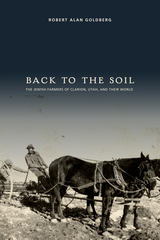 Back to the Soil: The Jewish Farmers of Clarion, Utah, and Their World
Robert Alan Goldberg
University of Utah Press, 1986 The image of the Jew solely as urbanite may stem from the period of 1880 to 1920, when two million Jews left their homes in Eastern Europe and established themselves in the urban centers of America. Lesser known are the agrarian efforts of Jewish immigrants. In Back to the Soil, Robert Goldberg focuses on the attempt of one such Jewish colony in Clarion, Utah. In 1911, eighty-one families left eastern cities to farm the Clarion tract. Jewish families funded the venture, the governor of Utah en-couraged it, and the Mormon Church financially aided the community. Despite these efforts, Clarion died as an organizational entity in 1916, with the dozen remaining families departing by the mid-1920s. Goldberg sheds light on the values and ideals of the colonists, the daily rhythm of life, the personalities of the settlers, and the struggle for and eventual collapse of their dream. Of all the attempts to establish a Jewish colony on the land, Clarion was the largest and had the longest existence of any colony west of the Appalachians. The Clarion fragment, lost and forgotten, thus becomes a crucial part of the larger mosaic of Jewish history in the West. Release of this new paperback edition is timed to coincide with the celebration of the centennial of the founding of the Clarion colony.
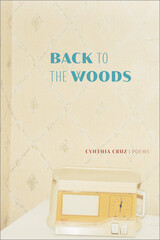 Back to the Woods
Cynthia Cruz
Four Way Books National Book Critics Circle Award Winner Cynthia Cruz reevaluates the paradox of the death drive in her eighth collection of poetry, Back to the Woods. Could it be that in ceaselessly snuffing ourselves out we are, in fact, trying to survive? In “Shine,” Cruz’s speaker attests that “if [she] had a home, it would be // a still in a film / where the sound / got jammed.” This book inhabits the silence of the empty orchestra pit, facing “dread, and its many / instruments of sorrow.” The quiet asks, “Did you love this world / and did this world / not love you?” We return to the site of our suffering, we perform the symphony of all our old injuries, to master what has broken us. To make possible the future, we retreat into the past. “I don’t know / the ending. // I don’t know anything,” our speaker insists, but she follows the wind’s off-kilter song of “winter / in the pines” and “the dissonance / of siskins.” Cruz heeds the urgency of our wandering, the mandate that we must get back to the woods, not simply for the forest to devour us — she recognizes in the oblivion “flooding out / from its spiral branches” an impossible promise. At the tree line, we might vanish to begin again.
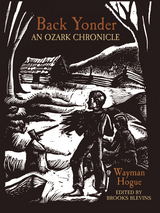 Back Yonder: An Ozark Chronicle
Charles Wayman Hogue
University of Arkansas Press, 2016 Wayman Hogue’s stories of growing up in the Ozarks, according to a 1932 review in the New York Times, “brilliantly illuminate mountain life to its very heart and in its most profound aspects.” A standout among the Ozarks literature that was popular during the Great Depression, this memoir of life in rural Arkansas in the decades following the Civil War has since been forgotten by all but a few students of Arkansas history and folklore. Back Yonder is a special book. Hogue, like his contemporary Laura Ingalls Wilder, weaves a narrative of a family making its way in rugged, impoverished, and sometimes violent places. From one-room schoolhouses to moonshiners, the details in this story capture the essence of a particular time and place, even as the characters reflect a universal quality that will endear them to modern readers. Historian Brooks Blevins’s new introduction explores the life of Charles Wayman Hogue, analyzes the people and events that inspired the book, and places the volume in the context of America’s discovery of the Ozarks in the years between the World Wars. The University of Arkansas Press is proud to reissue Back Yonder as the first book in the Chronicles of the Ozarks series, making this Arkansas classic available again, ready to be discovered and rediscovered by readers sure to find the book as interesting and entertaining as ever.
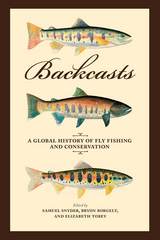 Backcasts: A Global History of Fly Fishing and Conservation
Edited by Samuel Snyder, Bryon Borgelt, and Elizabeth Tobey
University of Chicago Press, 2016 “Many of us probably would be better fishermen if we did not spend so much time watching and waiting for the world to become perfect.”-Norman Maclean
Though Maclean writes of an age-old focus of all anglers—the day’s catch—he may as well be speaking to another, deeper accomplishment of the best fishermen and fisherwomen: the preservation of natural resources.
Backcasts celebrates this centuries-old confluence of fly fishing and conservation. However religious, however patiently spiritual the tying and casting of the fly may be, no angler wishes to wade into rivers of industrial runoff or cast into waters devoid of fish or full of invasive species like the Asian carp. So it comes as no surprise that those who fish have long played an active, foundational role in the preservation, management, and restoration of the world’s coldwater fisheries. With sections covering the history of fly fishing; the sport’s global evolution, from the rivers of South Africa to Japan; the journeys of both native and nonnative trout; and the work of conservation organizations such as the Federation of Fly Fishers and Trout Unlimited, Backcasts casts wide.
Highlighting the historical significance of outdoor recreation and sports to conservation in a collection important for fly anglers and scholars of fisheries ecology, conservation history, and environmental ethics, Backcasts explores both the problems anglers and their organizations face and how they might serve as models of conservation—in the individual trout streams, watersheds, and landscapes through which these waters flow.
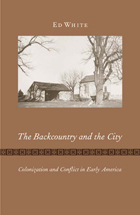 The Backcountry and the City: Colonization and Conflict in Early America
Ed White
University of Minnesota Press, 2005 What would an account of early America look like if it were based on examining rural insurrections or Native American politics instead of urban republican literature? Offering a new interpretation of eighteenth-century America, The Backcountry and the City focuses on the agrarian majority as distinct from the elite urban minority.
Ed White explores the backcountry-city divide as well as the dynamics of indigenous peoples, bringing together two distinct bodies of scholarship: one stressing the political culture of the Revolutionary era, the other taking an ethnohistorical view of white–Native American contact. White concentrates his study in Pennsylvania, a state in which the majority of the population was rural, and in Philadelphia, a city that was a center of publishing and politics and the national capital for a decade. Against this backdrop, White reads classic political texts such as Crèvecoeur’s Letters from an American Farmer, Franklin’s Autobiography, and Paine’s “Agrarian Justice,” alongside missionary and captivity narratives, farmers’ petitions, and Native American treaties. Using historical and ethnographic sources to enrich familiar texts, White demonstrates the importance of rural areas in the study of U.S. nation formation and finds unexpected continuities between the early colonial period and the federal ascendancy of the 1790s.
Ed White is associate professor of English at the University of Florida.
BACKCOUNTRY: CONTEMPORARY WRITING IN WEST VIRGINIA
IRENE MCKINNEY
West Virginia University Press, 2002 This is as closely-knit an anthology as you are ever likely to see. It is as though a large, extended family were drawing on the same store of family stories, jokes, symbols, landscapes, animals, trees, language, and vernacular. How many snakes are in this book? How many foxes, possums? Fossils? And how very many coal mines? But it is not merely local references that unites these writers. There is a larger vision that ties these works together. "The connection is not so much in mutual influence, though there is some of that, but in each writer’s total immersion in place. Even those writers who no longer live in the state remember the feel, the physical texture, the overwhelming and enfolding vegetal surround of the place." Editor, Irene McKinney
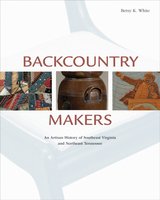 Backcountry Makers: An Artisan History of Southwest Virginia and Northeast Tennessee
Betsy K. White
University of Tennessee Press, 2013 This new book brings to life the material-culture heritage of southwest Virginia and northeast Tennessee. In Backcountry Makers, Betsy K. White expands on her previous study of the region’s rich decorative arts legacy, Great Road Style, to offer a closer look at the individual artisans responsible for the diverse works that constitute that legacy.
Beautifully illustrated with some 230 photographs, most of them in color, this volume includes biographical sketches of seventy-five makers—potters, weavers, spinners, quilters, embroiderers, cabinetmakers, metalsmiths, clocksmiths, gunsmiths, and artists—who worked in the region from the earliest eighteenth-century settlement days to the late twentieth century. The entry for each artisan is accompanied by one or more images of a signed or marked work, or, in a number of instances, an unmarked work with certain provenance.
These vignettes offer a fascinating glimpse of the people behind the various pieces, describing their background, family life, and where they learned their trade. Using census records and other documentary evidence, White has traced the earliest of these artisans from their origins in such places as Europe and Philadelphia down through the Great Valley of Virginia to their ultimate destinations in southwest Virginia and northeast Tennessee. Along with the photos displaying the products of their craftsmanship, the book also includes a number of evocative images of the artists and their homes and towns, thus giving the reader a fuller sense of the region where these gifted people lived and worked.
One of the few studies to addresses handmade objects in this locale—and one of the even fewer works to focus on the artisans themselves— Backcountry Makers will be of great value not only to scholars of material culture and the arts in Appalachia but also to those who collect regional antiques and crafts and want to know more about the individuals who made them.
Betsy K. White is the author of Great Road Style: The Decorative Arts Legacy of Southwest Virginia and Northeast Tennessee. Until her retirement in 2008, she was director of the William King Regional Arts Center (now William King Museum) in Abingdon, Virginia.
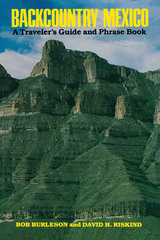 Backcountry Mexico: A Traveler’s Guide and Phrase Book
By Bob Burleson and David H. Riskind
University of Texas Press, 1986 <p>If you've always longed to strike out through the open country of northern Mexico armed with frying pan and bedroll, then this guide to the people, culture, folkways, landscape, and language of rural Mexico is for you. Out of twenty years of travel in backcountry Mexico, authors Bob Burleson and David Riskind have produced perhaps the most practical and accurate guide available for the unconventional tourist—the man or woman who prefers to get off the beaten path by foot, burro, mule, canoe, raft, or vehicle.</p>
<p>Going well beyond the usual tourist guidebook entries, <cite>Backcountry Mexico</cite> will help you hire a guide and burro, navigate rural roads and trails, and communicate with the friendly and, sometimes, unfriendly folks you are likely to meet in a rural setting.</p>
<p>In addition to English-Spanish and Spanish-English vocabulary lists containing both standard words and numerous terms relating to people, conditions, land, and situations not ordinarily encountered in tourists' lists, the authors have provided literally hundreds of helpful phrases and short conversations in easy-to-use sections arranged according to topics. Experienced unconventional travelers themselves, Burleson and Riskind have become experts in such subjects as "Eating and Staying Well on the Road, " "Camping in Mexico, " "Rural Mexican Village Life," and many more. Their experience, and the resultant wealth of language and cultural information contained in this guide, will help you to enjoy your trip ancd to better understand and appreciate the people and the land you visit.</p>
<p>Throughout the book, the language examples are interwoven with beautifully illustrated anecdotes about culture and lifeways, so that the traveler is equipped with practical knowledge as well as appropriate behavior and speech. Fascinating in its treatment of a culture that is little known and unique in its coverage of rural-style Mexican Spanish, <cite>Backcountry Mexico</cite> will prove invaluable to anyone who ventures forth into northern Mexico.</p>
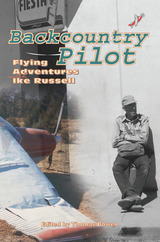 Backcountry Pilot: Flying Adventures with Ike Russell
Edited by Thomas Bowen
University of Arizona Press, 2002 When people get together around southern Arizona, there's a good chance that somebody will say, "That reminds me of the time I flew with Ike Russell. . . . " A backcountry pilot famous for his jaunts into the wildest, most remote regions of the borderlands, Alexander "Ike" Russell has become something of a legend since his death in 1980, and the stories surrounding his flights never fail to amaze.
This book combines biography and oral history by offering a wide range of anecdotes and remembrances about Ike by friends and family. Many describe the great adventures and gut-wrenching close calls that have become enshrined in local folklore as classic "Ike Russell stories," in all their hair-raising and hilarious splendor.
Russell was an easterner who moved to Arizona for his health and got his pilot's license in 1948—despite suffering from a respiratory disorder that would have kept other men firmly anchored to the ground. Over the years he flew scientists and other scholars to remote field locations in Mexico's Gulf of California and Sierra Madre Occidental that otherwise might not have been investigated. He often landed on short and dangerous airstrips and never seemed to mind running out of gas, getting caught without provisions, or attempting night landings in unlighted terrain. He took along a teapot wherever he went—and wherever he stopped, his first priority was to brew a quick cup.
Backcountry Pilot is the story of a larger-than-life adventurer, with those who knew Ike sharing tales tall and true about his famous exploits, brushes with fate, and sometimes narrow escapes from the jaws of disaster. It includes reminiscences by such scientists and friends as botanist Richard Felger, whom Ike frequently flew down to Seriland; ethnohistorian Bernard Fontana, whom Ike took to Tarahumara country; and paleoecologist Paul Martin, who talked Ike into a nine-month trip through Africa over totally unfamiliar terrain. A concluding chapter by Thomas Bowen offers a brief biographical sketch of Russell.
Ike Russell was a central figure for a generation of people who studied the southwestern desert and who helped others see it as a biological treasure rather than a wasteland. More than a highly skilled bush pilot, he was an extraordinary human being who touched the lives of everyone he met. For those who never got the chance, Backcountry Pilot secures Ike Russell's legacy in the desert skies.
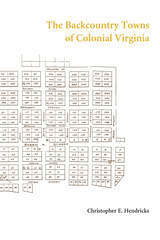 The Backcountry Towns of Colonial Virginia
Christopher E. Hendricks
University of Tennessee Press, 2006
For decades historians and historical geographers have neglected the study of town life in the colonial South, simply portraying towns as the result of increasing population density. The Backcountry Towns of Colonial Virginia, the first comprehensive study of town development in the interior of the colonial South, marshals evidence that planned urban settlements were the essential agents in accelerating westward expansion. Through the analysis of twenty-five attempts to create towns in the Virginia backcountry, the work demonstrates there was a distinctly southern urban movement in the colonial period. It explores the factors that lead to the success or failure of a community and examines how each backcountry region operated as an economic unit uniquely suited to its development. Towns opened up land, attracting people to move into new areas or participate in new business opportunities. They furthered settlement, influenced immigration, created family and social networks, and fostered the development of trade and systems of credit. The actions of a few individuals and groups of people resulted in the rapid occupation, settlement, and development of the Virginia backcountry through the conscious creation of economic and social forces. The most complete study of southern towns since John Reps’s Tidewater Towns, The Backcountry Towns of Colonial Virginia offers a new understanding of property ownership, burgeoning trade, and immigration factors–the very elements of urban centers–in backcountry Virginia.
Christopher E. Hendricks is professor of history at Armstrong Atlantic State University. He is a contributor to The Encyclopedia of Appalachia and his publications have appeared in the Journal of the Georgia Association of Historians, the Journal of Southwest Georgia History, and the North Carolina Historical Review.
 Backcountry War: The Rise of Francis Marion, Banastre Tarleton, and Thomas Sumter
Andrew Waters
Westholme Publishing, 2024 FINALIST FOR THE 2025 AMERICAN BATTLEFIELD TRUST PRIZE FOR HISTORY
Over the past several decades, the history of the American Revolution in the South has undergone a transformation to better incorporate regional events into the greater narrative of the war. Among these events was the vicious “backcountry” war from the Georgia border, across the South Carolina wilderness, to the North Carolina Piedmont between rebel Americans and loyalist and British forces. Centered in South Carolina, this running battle saw some of the most intense and continuous fighting of the war, and from its skirmishes, feints, and sieges, three key leaders emerged: American partisans Francis “Swamp Fox” Marion and Thomas “Gamecock” Sumter, and British Legion commander Banastre “Bloody Ban” Tarleton.
For the first time, Backcountry War: The Rise of Francis Marion, Banastre Tarleton, and Thomas Sumter by Andrew Waters frames the history of these three men into in a single narrative, focusing on the events of 1780 in South Carolina that witnessed their collective ascendance from common soldiers to American legends. It was a time when British victories at Charleston and Camden left the Continental Army in tatters and the entire American South vulnerable to British conquest. Yet in those dark hours, Sumter, Marion, and others like them rose in the swamps and hills of the South Carolina wilderness. Fighting a wildly successful partisan war against better trained and better equipped British forces, including Tarleton’s British Legion, with victories at lesser-known places like Hanging Rock and Nelson’s Ferry, they gained precious months for the reorganizing Continental Army. Their collective efforts led to the stunning American victory at Cowpens and a stalemate at Guilford’s Courthouse the following year that finally convinced British general Charles Cornwallis to abandon the Carolinas for Virginia.
With background biographies of its three main protagonists, a thorough sketch of Great Britain’s Southern Strategy, and a sociocultural examination of the South Carolina frontier in the years leading up to the American Revolution, Backcountry War offers a fresh perspective on an extraordinary chapter of American history and a compelling account of the deadly contest between three of the war’s most charismatic leaders.
Backflash: A Parker Novel
Richard Stark
University of Chicago Press, 2011 An action-packed novel starring Parker, the heister starring in the forthcoming Shane Black film Play Dirty!
Parker's got a couple of rules that have helped keep him alive throughout his long career. One of those is never to work on a boat. But with a gambling boat cruising down the Hudson, stuffed to the gunwales with cash, Parker’s got a plan, a team, and a new rule: a shot at a big enough score makes any rule worth breaking. Parker and his crew hit the boat, hard, but as always, there are a lot of complications—and a lot of bodies—before this one's in the bag.
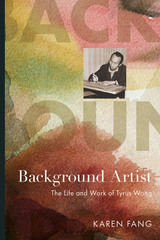 Background Artist: The Life and Work of Tyrus Wong
Karen Fang
Rutgers University Press, 2025 Chinese American Librarians Association Best Book Award (Honorary Mention, Adult Non-fiction category)
You might not know the name Tyrus Wong, but you probably know some of the images he created, including scenes from the beloved Disney classic Bambi. Yet when he came to this country as a child, Tyrus was an illegal immigrant locked up in an offshore detention center. How did he go on to a long and prosperous career drawing animation cels, storyboards, and greeting cards that shaped the American imagination?
Background Artist shares the inspiring story of Tyrus Wong’s remarkable 106-year life and showcases his wide array of creative work, from the paintings and fine art prints he made working for Roosevelt’s Works Progress Administration to the unique handmade kites he designed and flew on the Santa Monica beach. It tells how he came to the United States as a ten-year-old boy in 1920, at a time when the Chinese Exclusion Act barred him from legal citizenship. Yet it also shows how Wong found American communities that welcomed him and nurtured his artistic talent. Covering everything from his work as a studio sketch artist for Warner Bros. to the best-selling Christmas cards he designed for Hallmark and other greeting card companies, this book celebrates a multitalented Asian American artist and pioneer.
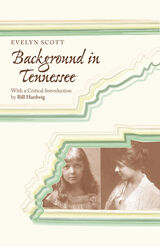 Background in Tennessee
Evelyn Scott
University of Tennessee Press, 2021 Born Elsie Dunn in 1893 Clarksville, Tennessee, Evelyn Scott lived a tumultuous life that took her to New York, Brazil, western Europe, and the Caribbean. She published twelve novels during her lifetime and was a notable literary figure in the 1920s and 1930s. Published in 1937 alongside her penultimate novel, Background in Tennessee is an autobiographical work devoted to Scott’s Tennessee birthplace, her family’s history, and her broad view of Southern history. Her wide-ranging exploration of the south interweaves Scott’s personal history with discussions of colonial settlement of the region, local leadership of Clarksville and the larger Nashville area, and race relations. In this new edition, Bill Hardwig provides an analytical introduction that guides the reader through Scott’s intricate and winding exploration of early twentieth-century Tennessee and her own past. He notes at once Scott’s ambivalence toward her native South and yet the nostalgia with which she recounts personal memories. Complicated yet critical to a full understanding of Evelyn Scott and her literary legacy, this edition of Background in Tennessee makes available an important voice in Tennessee’s literary history for a new generation.
The Background of Swedish Emigration to the United States: An Economic and Sociological Study in the Dynamics of Migration
John Lindberg
University of Minnesota Press, 1930 The Background of Swedish Emigration to the United States was first published in 1930. Minnesota Archive Editions uses digital technology to make long-unavailable books once again accessible, and are published unaltered from the original University of Minnesota Press editions.The author, for three years a fellow of the Laura Spelman Rockefeller Memorial, examines the movement that, about the middle of the nineteenth century, swept over Sweden like an epidemic and carried away a large portion of her youth to America. Some of the more important chapters discuss the character of group emigration, the pattern of mass emigration, the background of agricultural emigration, the selection of emigrants, the industrial emigration, the professional emigration, the return of the emigrants, and the cessation of emigration.
 Background of Thomson’s Seasons
Alan Dugald McKillop
University of Minnesota Press, 1942
Background of Thomson's Seasons was first published in 1942. Minnesota Archive Editions uses digital technology to make long-unavailable books once again accessible, and are published unaltered from the original University of Minnesota Press editions.
There have been many valuable scattered studies of James Thomson's famous Seasons,but this is the first comprehensive book on the subject to be published in this country. This most popular long poem published in England in the eighteenth century well deserves reexamination. It is interesting not only to students of literature but also to those concerned with the history of ideas and the relationship of the fields of human knowledge.
Thomson's Seasons reflects the trends of his time in literature, philosophy, science, history, and religion. Professor McKillop presents an illuminating and systematic analysis of the general philosophic and literary situation in which Thomson worked. Then he discusses Thomson's use of the natural sciences and of the literature of history, geography, and travel. He shows that the poet was also concerned with the patterns of human society, both primitive and civilized.
The author reveals clearly how Thomson was indebted to the classical tradition; to the literary inspiration of Milton; to the scientific discussions and theories of Newton, Halley, Burnet, and the writers of popular physico-theological manuals; to the philosophical discussions of Shaftesbury and Locke; to the contemporary periodical essay; to the religious works of Blackmore and Hill; to the descriptions of remote regions and peoples in such writers as Scheffer, Varenius, and Maupertuis. All Thomson's borrowings and characteristic ideas fall into the framework of his poem.
As this book was leaving the bindery, discovery was made in Glasgow of a catalogue of Thomson's library. The document substantiates many of Professor McKillop's deductions.
 Backgrounds of English Literature, 1700-1760
Cecil Moore
University of Minnesota Press, 1953
Backgrounds of English Literature, 1700-1760 was first published in 1953. Minnesota Archive Editions uses digital technology to make long-unavailable books once again accessible, and are published unaltered from the original University of Minnesota Press editions.The five studies collected in this volume have the common purpose of establishing a background for an understanding of eighteenth-century English literature. Some of the most popular ideas and ideals of the period are traced to their sources in contemporary philosophy, science, politics, and religion.All of the studies relate in some way to what the seventeenth century called the climate of opinion. They confirm the observation of Shelley that all writers are subjected to “a common influence which arises out of an infinite combination of circumstances belonging to the time in which they live.” All the studies belong to that older style of literary investigation to which scholarship owes its name and to which every student interested in basic ideas and the origins of concepts will sooner or later wish to turn.The first two studies, “Shaftesbury and the Ethical Poets” and “The Return to Nature in English Poetry of the Eighteenth Century,” throw as much light on the Romantic poetry of the nineteenth century as they do on the poetry of the eighteenth. The nature worship that one thinks of as peculiarly Wordsworthian is shown to lie at the heart of deism, the rationalistic philosophy of a century earlier.In “Whig Panegyric Verse,” the ideals of the Whig party, as expressed by poets of the time, are examined in relation to Shaftesbury’s moral philosophy. In “John Dunton: Pietist and Impostor,” the morbid gloom familiar in the “graveyard poets” is seen to reflect a widespread popular taste. That the melancholia of the period was so common as to be considered a national characteristic appears from “The English Malady,” which is largely concerned with the medical literature of the time.
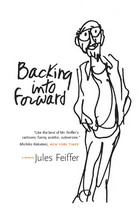 Backing into Forward: A Memoir
Jules Feiffer
University of Chicago Press, 2012 Subversive, funny, and effortlessly droll, Jules Feiffer’s cartoons were all over New York in the 1960s and ’70s—featured in the Village Voice, but also cut out and pinned to bulletin boards in offices and on refrigerators at home. Feiffer describes himself as “lucking into the zeitgeist,” and there’s some truth to the sentiment; Feiffer’s brand of satire reflected Americans’ ambivalence about the Vietnam War, changing social mores, and much more.
Feiffer’s memoir, Backing into Forward, like his cartoons, is sharply perceptive with a distinctive bite of mordant humor. Beginning with his childhood in Brooklyn, Feiffer paints a picture of a troubled kid with an overbearing mother and a host of crippling anxieties. From there, he discusses his apprenticeship with his hero, Will Eisner, and his time serving in the military during the Korean War, which saw him both feigning a breakdown and penning a cartoon narrative called “Munro” that solidified his distinctive aesthetic as an artist. While Feiffer’s voice grounds the book, the sheer scope of his artistic accomplishment, from his cartoons turning up in the New Yorker, Playboy, and the Nation to his plays and film scripts, is remarkable and keeps the narrative bouncing along at a speedy clip. A compelling combination of a natural sense of humor and a ruthless dedication to authenticity, Backing into Forward is full of wit and verve, often moving but never sentimental.
“Jules Feiffer’s original and neurotic voice. . . . reinvented comics in the 1950s and made possible what’s now called the ‘graphic novel.’ His engaging new memoir is told in that same witty and perceptive New York cadence, mellowed and laced with wisdom. He’s an inspiration.”—Art Spiegelman
 Backlash Against the ADA: Reinterpreting Disability Rights
Linda Hamilton Krieger, Editor
University of Michigan Press, 2003 For civil rights lawyers who toiled through the 1980s in the increasingly barren fields of race and sex discrimination law, the approval of the Americans with Disabilities Act in 1990 by a nearly unanimous U.S. House and Senate and a Republican President seemed almost fantastic. Within five years of the Act's effective date, however, observers were warning of an unfolding assault on the ADA by federal judges, the media, and other national opinion-makers. A year after the Supreme Court issued a trio of decisions in the summer of 1999 sharply limiting the ADA's reach, another decision invalidated an entire title of the act as it applied to the states. By this time, disability activists and disability rights lawyers were speaking openly of a backlash against the ADA.
What happened, why did it happen, and what can we learn from the patterns of public, media, and judicial response to the ADA that emerged in the 1990s? In this book, a distinguished group of disability activists, disability rights lawyers, social scientists and humanities scholars grapple with these questions. Taken together, these essays construct and illustrate a new and powerful theoretical model of sociolegal change and retrenchment that can inform both the conceptual and theoretical work of scholars and the day-to-day practice of social justice activists.
Contributors include Lennard J. Davis, Matthew Diller, Harlan Hahn, Linda Hamilton Krieger, Vicki A. Laden, Stephen L. Percy, Marta Russell, and Gregory Schwartz.
Backlash Against the ADA will interest disability rights activists, lawyers, law students and legal scholars interested in social justice and social change movements, and students and scholars in disability studies, political science, media studies, American studies, social movement theory, and legal history.
Linda Hamilton Krieger is Professor of Law, University of California School of Law, Berkeley.
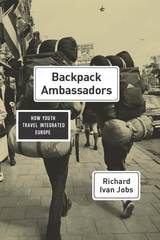 Backpack Ambassadors: How Youth Travel Integrated Europe
Richard Ivan Jobs
University of Chicago Press, 2017 Even today, in an era of cheap travel and constant connection, the image of young people backpacking across Europe remains seductively romantic. In Backpack Ambassadors, Richard Ivan Jobs tells the story of backpacking in Europe in its heyday, the decades after World War II, revealing that these footloose young people were doing more than just exploring for themselves. Rather, with each step, each border crossing, each friendship, they were quietly helping knit the continent together.
From the Berlin Wall to the beaches of Spain, the Spanish Steps in Rome to the Pudding Shop in Istanbul, Jobs tells the stories of backpackers whose personal desire for freedom of movement brought the people and places of Europe into ever-closer contact. As greater and greater numbers of young people trekked around the continent, and a truly international youth culture began to emerge, the result was a Europe that, even in the midst of Cold War tensions, found its people more and more connected, their lives more and more integrated. Drawing on archival work in eight countries and five languages, and featuring trenchant commentary on the relevance of this period for contemporary concerns about borders and migration, Backpack Ambassadors brilliantly recreates a movement that was far more influential and important than its footsore travelers could ever have realized.
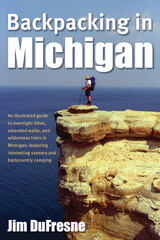 Backpacking in Michigan
Jim DuFresne
University of Michigan Press, 2007 With 65 photographs and 77 detailed maps, this indispensable guide to the state's hiking trails gives beginners to advanced hikers all the information they need to plan their next Michigan overnight or weekend backpacking trip. Featuring 50 trails---27 in the Lower Peninsula---ranging from one-hour to multiple-day treks in both the Upper and Lower Peninsulas, Backpacking in Michigan has something for every hiker. Information on hike length and difficulty, elevation gain, the amount of time needed to complete the hike, camping facilities, and nearby towns accompanies each of the trail listings. The author also provides extensive reference maps along with a description of scenic highlights. In addition to backcountry explorations of remote trails, Backpacking in Michigan includes classic Michigan adventures such as the Lakeshore Trail in Pictured Rocks National Lakeshore, the Greenstone Ridge Trail in Isle Royale National Park, North Manitou Island in Sleeping Bear Dunes National Lakeshore, and Jordan River Pathway in the Mackinaw State Forest. While Backpacking in Michigan focuses primarily on the trails themselves, it also makes planning your Michigan adventure as easy as possible by providing important information on routes to and from the trailhead, as well as park fees and reservation information for shelters, walk-in cabins, rental yurts, and overnight camping. Jim DuFresne is a Michigan native and author of more than a dozen wilderness, travel, and hiking guidebooks. He is author of Isle Royale National Park: Foot Trails and Water Routes; 50 Hikes in Michigan: The Best Walks, Hikes, and Backpacks in the Lower Peninsula; Best Hikes with Children: Michigan; Porcupine Mountains Wilderness State Park: A Backcountry Guide for Hikers, Campers, Backpackers, and Skiers; as well as The Complete Guide to Michigan Sand Dunes, copublished by the University of Michigan Press and Petoskey Publishing.
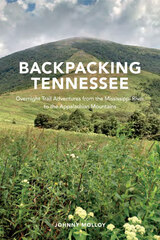 Backpacking Tennessee: Overnight Trail Adventures from the Mississippi River to the Appalachian Mountains
Johnny Molloy
University of Tennessee Press, 2022 “The reason I travel and explore the outdoors is simple,” writes Johnny Molloy, “the world is a beautiful place!” And Molloy would know: he has backpacked more than 2,500 nights in forty states. It is this experience—much of it garnered in his home state of Tennessee—combined with his extensive production of guidebooks spanning activities from hiking and camping to paddling and bicycling, that enabled him to produce Backpacking Tennessee: Overnight Trail Adventures from the Mississippi River to the Appalachian Mountains.
Complete with directions, distances, descriptions, and maps, Backpacking Tennessee is divided into four sections that together outline forty overnight hikes across West Tennessee, Middle Tennessee, the Cumberland Plateau, and East Tennessee and the Appalachian Mountains. The trails Molloy has chosen to highlight are a mix of well-known hikes and lesser-known areas, ranging in distance and difficulty for both novice hikers and experienced backpackers. Woven throughout the trail descriptions are comments on scenery, notes about safety, and historical information that help readers get a true feel for each hike. To round out his comprehensive guide, Molloy also includes ratings, 1–5, on the family- and dog-friendliness of each trail—an especially helpful feature for readers bringing loved ones along.
From the Great Smoky Mountains National Park and Cherokee National Forest to Big South Fork and Land Between the Lakes, Tennessee offers thousands of miles of trails for adventurers looking to explore. For budding outdoor enthusiasts and experienced backpackers alike, Backpacking Tennessee answers the timeless question: where do we go next?
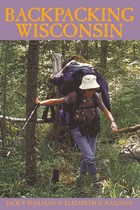 Backpacking Wisconsin
Elizabeth D. Hailman
University of Wisconsin Press, 2000 Wisconsin is a premier backpacking state, with outstanding opportunities for weekend trips. With its Great Lakes and river boundaries, national and state parks and forests, and stunning geological diversity, it offers a variety of experiences for both novice and experienced backpackers. In Backpacking Wisconsin Jack and Liz Hailman, drawing on years of personal experience, provide first-hand information for trails in every corner of the state—from the wooded Apostle Islands National Lakeshore, inhabited by whitetailed deer and black bears, to picturesque Newport State Park in Door County, set upon Silurian-age limestone laid down over 100 million years ago.
For each backpacking site you’ll find:
• information on entrance fees and permits, campsites, & contact sources
• directions to the location
• detailed trail maps with keys that pinpoint roads, parking, trail shelters, water supplies, outhouses
• ratings for trails, scenery, quiet, solitude, and interest
• background information on history, geology, and terrain
• trail notes describing trees, shrubs, wildflowers, birds, and animals you may encounter.
Backpacking Wisconsin also provides an overview of the backpacking experience, tips for the beginner and the expert, hints on how to choose equipment (boots, packs, tents, sleeping bags, rain gear, stoves), notes on troublesome plants and animals, a list of state areas that no longer offer backpacking, schedules of fees, a checklist for backpacks, and a list of trail, outdoor, and conservation organizations. For those hesitant to venture deep into wilderness, the Hailmans spotlight “quasi-backpacking” sites. All you have to do is pick a trail!
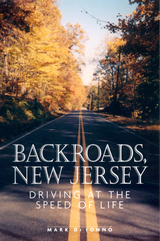 Backroads, New Jersey: Driving at the Speed of Life
Di Ionno, Mark
Rutgers University Press, 2002 Mark Di Ionno is a Jersey guy through and through. He’s lived in fifteen different towns in six different New Jersey counties. He’s been a journalist for the state’s top newspapers, currently the Star-Ledger, where his first job was to go out and write about things that were “interesting.” Who better to take readers on a personal tour of the backroads of New Jersey?
In Backroads, New Jersey, Di Ionno leads readers off the congested interstates with their commonplace scenery to the seldom-explored secondary roads, where the real life of the state can be found. These inter-county or 500 series roads are a 6,788-mile network of mostly one-lane highways. Marked by blue-and-yellow five-sided shields bearing county names, they make up more than 20 percent of New Jersey’s public roads. They are never the fastest or most direct way to get anywhere, but when you break out of the towns and hit the country, they are a pleasure to drive.
Travel with Di Ionno as he takes readers to see the state’s amazing beauty¾from the dizzying cliffs of the Palisades, to the blunted peaks of the Highlands and Kittatinny Ridges, to the rolling hills of Morris, Hunterdon, and Somerset counties, to the topsoil-wealthy agricultural belts of Monmouth and the southern counties, to the flat, sandy beaches of the 127-mile Jersey Shore. Travel with him as he shows us the homes of New Jersey’s culturally diverse population, whose men and women work at everything from farms to pharmacies, from banks to auto assembly lines. And travel with him as he recounts the history made along the back country roads in towns like Rocky Hill, where George Washington wrote his farewell orders. Di Ionno calls New Jersey “a place of infinite natural beauty, a place of intricate human patterns. A place where you can see a lot in a little time. This is, simply put, the overriding theme of this book. New Jersey is a restless state for restless people. A state for wanderers to explore.” Backroads, New Jersey is a rare chance to see it all through the eyes of a well-traveled Jerseyan. Happy wandering!
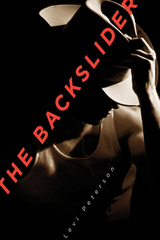 The Backslider
Peterson, Levi
Signature Books, 2013 Recognized as a Mormon classic twenty years after its release,The Backslider features longstanding Christian conflicts played out in a scenic, sparsely populated area of southern Utah. A young ranch-hand, Frank Windham, conceives of God as an implacable enemy of human appetite. He is a dedicated sinner until family tragedy catapults him into an arcane form of penitence preached among frontier Mormons. He is saved by an epiphany that has proved controversial among readers, either interpreting it as an extreme impiety or celebrating it as a moving and entirely plausible rendering of a biblical theme in a Western setting. Frank comes into contact with a host of rural and urban characters. Of central importance is his Lutheran girlfriend, Marianne, whom Frank seduces, begrudgingly marries, and eventually loves. Frank’s extended family is just a generation removed from polygamy and still energized by old-time grudges and deprivations. Along the way Frank encounters a closeted secular humanist, a polygamist prophet, a psychiatrist, a Mason, government employees, college professors, lawyers, and entrepreneurs—all drawn with heightened realism reminiscent of Charles Dickens or the grotesque forms of William Faulkner and Flannery O’Connor. The story engages readers as it alternates almost imperceptibly between Frank’s naïve consciousness and the more informed awareness of its narrator. It can be read as a love story, a satiric comedy, or a dark and sobering study of self-mutilation. Shifting from one to another, it builds suspense and elicits
complex emotions, among them a profound sense of compassion. More joyous than cynical, it sympathizes deeply with the plight of all of God’s backsliders.
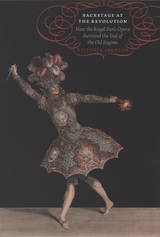 Backstage at the Revolution: How the Royal Paris Opera Survived the End of the Old Regime
Victoria Johnson
University of Chicago Press, 2008 On July 14, 1789, a crowd of angry French citizens en route to the Bastille broke into the Paris Opera and helped themselves to any sturdy weapon they could find. Yet despite its long association with the royal court, its special privileges, and the splendor of its performances, the Opera itself was spared, even protected, by Revolutionary officials. Victoria Johnson’s Backstage at the Revolution tells the story of how this legendary opera house, despite being a lightning rod for charges of tyranny and waste, weathered the most dramatic political upheaval in European history.
Sifting through royal edicts, private letters, and Revolutionary records of all kinds, Johnson uncovers the roots of the Opera’s survival in its identity as a uniquely privileged icon of French culture—an identity established by the conditions of its founding one hundred years earlier under Louis XIV. Johnson’s rich cultural history moves between both epochs, taking readers backstage to see how a motley crew of singers, dancers, royal ministers, poet entrepreneurs, shady managers, and the king of France all played a part in the creation and preservation of one of the world’s most fabled cultural institutions.
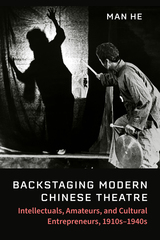 Backstaging Modern Chinese Theatre: Intellectuals, Amateurs, and Cultural Entrepreneurs, 1910s–1940s
Man He
University of Michigan Press, 2025 Modern Chinese theatre once entailed a variety of forms, but now it primarily refers to spoken drama, or huaju. Backstaging Modern Chinese Theatre looks beyond scripts to examine visuality, acoustics, and performance between the two World Wars, the period when huaju gained canonical status. The backstage in this study expands from being a physical place offstage to a culturally and historically constructed social network that encompasses theatre networks, academies, and government institutions—as well as the collective work of dramatists, amateurs, and cultural entrepreneurs. Early huaju was not a mere imitation of Western realist theatre, as it is commonly understood, but a creative synthesis of Chinese and Western aesthetics. Charting huaju’s evolution from American colleges to China’s coastal cities and then to its rural hinterland, Man He demonstrates how the formation of modern Chinese theatre challenges dominant understandings of modernism and brings China to the center of discussions on transnational modernities and world theatres.
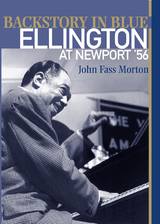 Backstory in Blue: Ellington at Newport '56
John Fass Morton
Rutgers University Press, 2008 Certificate of Merit for the 2009 Association for Recorded Sound Collections Award for Excellence in Historical Recorded Sound Research
It may be that the song most baby boomers identify from July 1956 is a simple twelve-bar blues, hyped on national television by a twenty-one-year-old Elvis Presley and his handlers. But it is a very different song, with its elongated fourteen-bar choruses of rhythm and dissonance, played on the night of July 7, 1956, by a fifty-seven-year-old Duke Ellington and his big band that got everybody on their feet and moving as one. More than fifty years later, “Diminuendo and Crescendo in Blue,” recorded at the 1956 Newport Jazz Festival, still makes a profound statement about postwar America—how we got there and where it all went.
Backstory in Blue is a behind-the-scenes look at this epic moment in American cultural history. It is the story of who and what made Ellington’s composition so compelling and how one piece of music reflected the feelings and shaped the sensibilities of the postwar generation. As John Fass Morton explains, it was music expressed as much by those who performed offstage as by those who performed on.
Written from the point of view of the audience, this unique account draws on interviews with fans and music professionals of all kinds who were there and whose lives were touched, and in some cases changed, by the experience. Included are profiles of George Avakian, who recorded and produced Ellington at Newport 1956; Paul Gonsalves, the tenor sax player responsible for the legendary twenty-seven choruses that enabled the rebirth of Ellington’s career; and the “Bedford Blonde,” Elaine Anderson, whose dance ignited both the band and the crowd.
Duke Ellington once remarked, “I was born at Newport.” Here we learn that Newport was much more than the turning point for Ellington’s career. It was the tipping point for a generation and a musical genre.
 Backtalk: Women Writers Speak Out
Donna Perry
Rutgers University Press, 1993 Agents or victims, liberated or oppressed, "bad girls" or "good girls." What do these labels mean and do they further or hinder women's progress? How are today's visions of female sexuality and power like or unlike those of the past? How do younger women define feminism? Isn't the personal still political? Dismayed by the media's tendency to reduce the feminist enterprise to labels and superstars, Donna Perry and Nan Bauer Maglin decided to find out what a diverse group of feminists think about women, sex, and power in the nineties. The result is a provocative and varied collection of twenty-four essays by second- and third-wave feminists; artists and activists; professors and graduate students; professional journalists and just-published writers; mothers and daughters. By focusing on society's construction, containment, and exploitation of female sexuality, in particular, these essays offer fresh perspectives on women's agency or lack of it. The contributors focus on the oversimplifications and false dichotomies in current discussions of female sexuality, as well as the privileged perspective and individualism that currently dominate the popularized feminist message. Individual writers--including Emma Amos, bell hooks, Ann Jones, Lisa Jones, Paula Kamen, Matuschka, Marge Piercy, Katha Pollitt, Anna Quindlen, Elayne Rapping, Lillian S. Robinson, and Ellen Willis--reexamine women's empowerment in the light of issues like AIDS, battering, acquaintance rape, narratives of childhood sexual abuse, and pornography. Several draw political conclusions from their personal struggles, while others read stories and texts--from history, the art world, the media, popular culture, and social science research--in new and controversial ways.
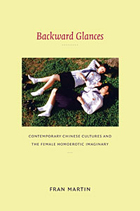 Backward Glances: Contemporary Chinese Cultures and the Female Homoerotic Imaginary
Fran Martin
Duke University Press, 2010 Backward Glances reveals that the passionate love one woman feels for another occupies a position of unsuspected centrality in contemporary Chinese mass cultures. By examining representations of erotic and romantic love between women in popular films, elite and pulp fiction, and television dramas, Fran Martin shows how youthful same-sex love is often framed as a universal, even ennobling, feminine experience. She argues that a temporal logic dominates depictions of female homoeroticism, and she traces that logic across texts produced and consumed in mainland China, Hong Kong, and Taiwan during the twentieth century and the early twenty-first. Attentive to both transnational cultural flows and local particularities, Martin shows how loving relations between women in mass culture are usually represented as past experiences. Adult protagonists revel in the repeated, mournful narration of their memories. Yet these portrayals do not simply or finally consign the same-sex loving woman to the past—they also cause her to reappear ceaselessly in the present. As Martin explains, memorial schoolgirl love stories are popular throughout contemporary Chinese cultures. The same-sex attracted young woman appears in both openly homophobic and proudly queer-affirmative narratives, as well as in stories whose ideological valence is less immediately clear. Martin demonstrates that the stories, television programs, and films she analyzes are not idiosyncratic depictions of marginal figures, but manifestations of a broader, mainstream cultural preoccupation. Her investigation of representations of same-sex love between women sheds new light on contemporary Chinese understandings of sex, love, gender, marriage, and the cultural ordering of human life.
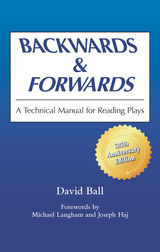 Backwards & Forwards: A Technical Manual for Reading Plays
David Ball. Forewords by Michael Langham and Joseph Haj
Southern Illinois University Press, 1983 The best-selling script analysis book for thirty-five years
Considered an essential text since its publication thirty-five years ago, this guide for students and practitioners of both theater and literature complements, rather than contradicts or repeats, traditional methods of literary analysis of scripts.
Ball developed his method during his work as literary director at the Guthrie Theater, building his guide on the crafts playwrights of every period and style use to make their plays stageworthy. The text is full of tools for students and practitioners to use as they investigate plot, character, theme, exposition, imagery, conflict, theatricality, and the other crucial parts of the superstructure of a play. Also included are guides for discovering what the playwright considers a play’ s most important elements, thus permitting interpretation based on the foundation of the play rather than its details.
Using Shakespeare’s Hamlet as illustration, Ball assures a familiar base for clarifying script-reading techniques as well as exemplifying the kinds of misinterpretation readers can fall prey to by ignoring the craft of the playwright. Of immense utility to those who want to put plays on the stage (actors, directors, designers, production specialists) Backwards & Forwards is also a fine playwriting manual because the structures it describes are the primary tools of the playwright.
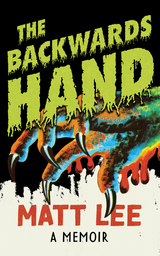 The Backwards Hand: A Memoir
Matt Lee
Northwestern University Press, 2024 Fear. Disgust. Pity. The cripple evokes our basest human emotions—as does the monster.
Told in lyric fragments, The Backwards Hand traces Matt Lee’s experience living in the United States for more than thirty years with a rare congenital defect. Weaving in historical research and pop culture references, Lee dissects how the disabled body has been conflated with impurity, worthlessness, and evil. His voice swirls amid those of artists, criminals, activists, and philosophers. With a particular focus on horror films, Lee juxtaposes portrayals of fictitious monsters with the real-life atrocities of the Nazi regime and the American eugenics movement. Through examining his struggles with physical and mental health, Lee confronts his own beliefs about monstrosity and searches for atonement as he awaits the birth of his son.
The Backwards Hand interrogates what it means to be a cripple in a predominantly ableist society, deconstructing how perceptions of disability are—and are not—reflected in art and media.
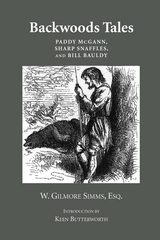 Backwoods Tales: Paddy McGann, Sharp Snaffles, and Bill Bauldy
William Gilmore Simms
University of Arkansas Press, 2010 The writings of William Gilmore Simms (1806–1870) provide a sweeping fictional portrait of the colonial and antebellum South in all of its regional diversity. Simms’s account of the region is more comprehensive than that of any other author of his time; he treats the major intellectual and social issues of the South and depicts the bonds and tensions among all of its inhabitants. By the mid-1840s Simms’s novels were so well known that Edgar Allan Poe could call him “the best novelist which this country has, on the whole, produced.” The twelfth volume in the ongoing Arkansas Edition of the works of William Gilmore Simms, Backwoods Tales brings together three of the best examples of his comic writing. All were written during the last decade of Simms’s life, when he had become a master of his craft. These three tales belong in the tradition of southern backwoods humor, a genre that flourished before the Civil War and produced classic tales by such authors as George Washington Harris, Johnson Jones Hooper, and Thomas Bangs Thorpe. Paddy McGann, “Sharp Snaffles,” and “Bill Bauldy” are all frame tales, told by rustic narrators in authentic dialect, with frequent pauses for libation and comment. These three pieces of writing, never before published together, stand among the best examples of American humor of the nineteenth century.
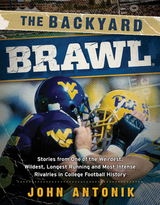 The Backyard Brawl: Stories from One of the Weirdest, Wildest, Longest Running, and Most Instense Rivalries in College Football History
John Antonik
West Virginia University Press, 2012 The West Virginia University Mountaineers and the University of Pittsburgh Panthers, separated by less than eighty miles of highway, have battled it out on the football field for more than one hundred years. Now, with Pitt announcing its departure from the Big East Conference to join the Atlantic Coast Conference and West Virginia becoming a member of the Big 12 Conference, this intense rivalry has come to an abrupt end. Thousands of players and dozens of coaches - some among the very best to ever play the game - have been a part of this famous series known as the “Backyard Brawl.” With fantastic tales about this feud’s star-studded rosters, including White, Slaton, Harris, Luck, Huff, Nehlen, and Rodriguez for West Virginia and Fitzgerald, Marino, Dorsett, Green, Majors, and Sherrill for Pitt, The Backyard Brawl celebrates the tradition, heritage, and pride of two outstanding universities. With unparalleled access, John Antonik, a 20-year West Virginia University athletic administrator and WVU alumnus, unearths the fascinating and humorous stories that make up this revered, colorful, and cherished football game-and more importantly, the great passion and pride these schools exhibit every time they take the field.
 A Backyard Prairie: The Hidden Beauty of Tallgrass and Wildflowers
Fred Delcomyn and James L. Ellis
Southern Illinois University Press, 2021 All the makings of natural wonder in your backyard
In 2003 Fred Delcomyn imagined his backyard of two and a half acres, farmed for corn and soybeans for generations, restored to tallgrass prairie. Over the next seventeen years, Delcomyn, with help from his friend James L. Ellis scored, seeded, monitored, reseeded, and burned these acres into prairie. In A Backyard Prairie, they document their journey and reveal the incredible potential of a backyard to travel back to a time before the wild prairie was put into plow rows. It has been said, “Anyone can love the mountains, but it takes a soul to love the prairie.” This book shows us how.
The first book to celebrate a smaller, more private restoration, A Backyard Prairie offers a vivid portrait of what makes a prairie. Delcomyn and Ellis describe selecting and planting seeds, recount the management of a prescribed fire, and capture the prairie’s seasonal parades of colorful flowers in concert with an ever-growing variety of animals, from the minute eastern tailed-blue butterfly to the imperious red-winged blackbird and the reclusive coyote.
This book offers a unique account of their work and their discovery of a real backyard, an inviting island of grass and flowers uncovered and revealed. We often travel miles and miles to find nature larger than ourselves. In this rich account of small prairie restoration, Delcomyn and Ellis encourage the revival of original prairie in our backyards and the patient, beauty-seeking soul sleeping within ourselves.
Bacteria to AI: Human Futures with Our Nonhuman Symbionts
N. Katherine Hayles
University of Chicago Press, 2025 A new theory of mind that includes nonhuman and artificial intelligences.
The much-lauded superiority of human intelligence has not prevented us from driving the planet into ecological disaster. For N. Katherine Hayles, the climate crisis demands that we rethink basic assumptions about human and nonhuman intelligences. In Bacteria to AI, Hayles develops a new theory of mind—what she calls an integrated cognitive framework (ICF)—that includes the meaning-making practices of lifeforms from bacteria to plants, animals, humans, and some forms of artificial intelligence. Through a sweeping survey of evolutionary biology, computer science, and contemporary literature, Hayles insists that another way of life, with ICF at its core, is not only possible but necessary to safeguard our planet’s future
 The Bacteriology of Tuberculosis
Egons Darzins
University of Minnesota Press, 1958
The Bacteriology of Tuberculosis was first published in 1958.Although tuberculosis is one disease against which, it may be said with little argument, medical science has scored tremendous victories, the goal of complete conquest still lies ahead. To fix accurate sights for that goal, a thorough understanding of the present status of knowledge about the disease is needed. This volume is published in response to that need.Through an exhaustive study of the literature on tuberculosis bacteriology from the late nineteenth century to the present, Dr. Darzins presents a comprehensive account of the knowledge and practices which have developed in this field. An important aspect is the discussion of the relatively new problems raised in bacteriological science by recent advances in the use of chemotherapeutics, antibiotics, and surgery for the treatment of tuberculosis.The first section is devoted to the morphology and cytology of the tubercle bacillus. Here Dr. Darzins outlines the physical, biological, and chemical methods of identifying cell structures. In the next section he considers the sources of energy and growth of the bacillus. He proceeds in the following section to a discussion of the methods of isolating and identifying the bacillus. The fourth part deals with a major problem of tuberculosis bacteriology, that of distinguishing the types of bacilli and determining their pathogenicity. In the final section he considers the problems of experimental work and points out the hazards and the need for precautions in laboratory work.
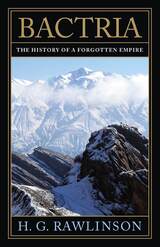 Bactria: The History of a Forgotten Empire
Hugh George Rawlinson
Westholme Publishing, 2013 An Important Account of the Greek State That Ruled the Hindu Kush for Centuries in the Wake of Alexander the Great
“If through the Bactrian Empire European ideas were transmitted to the Far East, through that and similar channels Asiatic ideas found their way to Europe.”—Intellectual Development of Europe
Following the Macedonian invasion of Persian in the fourth century B.C., an independent Greek-ruled empire emerged over an area encompassing modern Afghanistan, eastern Iran, and northern Pakistan. This ancient empire, called Bactria, is recorded in texts, both Asian and European, as well as through coins, inscriptions, and architectural remnants. Bactria served as a contact point between Europe, South Asia, and the Far East for more than two hundred years before disappearing under the pressure of a resurgent Persia to the west and Indian states to the east. In Bactria: The History of a Forgotten Empire, historian Hugh G. Rawlinson begins with the early history of Bactria and its subjugation by Persia, and then describes the conquest of Iran by Alexander the Great and the establishment of an independent Bactria ruled by Greeks. The Bactrians adopted Buddhism early on and helped establish the religion throughout the area. The author then follows the history of the empire through its rulers, including Menander, until Greek rule was extinguished around 135 B.C. Finally, the author discusses the effects of Greek occupation on the region. Based on meticulous research in ancient texts from Greece, Persia, and India, and using material evidence of the time, this history, which won the Hare University Prize at Cambridge in 1909, remains relevant today, providing a fascinating portrait of a little-known connection between East and West.
Bacula of North American Mammals
William Henry Burt
University of Michigan Press, 1960 In Bacula of North American Mammals, originally published by the Museum of Zoology at the University of Michigan, William Henry Burt describes the bacula of various North American mammals. Before this work, there was little material and few articles on the bacula of mammals. With the help of university staff and graduate students, Burt was able to preserve these bones and accumulate a large collection between 1930 and 1960. Although this collection incorporated a vast array of mammals, bats and cats were excluded due to their status as insectivores. The results of Burt’s study are organized by species, and include the generas Procyon, Nasua, Potos, Bassariscus, and Jentinkia.
Bad Aboriginal Art: Tradition, Media, and Technological Horizons
Eric Michaels
University of Minnesota Press, 1994 Bad Aboriginal Art is the extraordinary account of Eric Michaels’ period of residence and work with the Warlpiri Aborigines of western Central Australia, where he studied the impact of television on remote Aboriginal communities. Sharp, exact, and unrelentingly honest, Michaels records with an extraordinary combination of distance and immersion the intervention of technology into a remote Aboriginal community and that community’s forays into the technology of broadcasting. Michaels’s analyses in Bad Aboriginal Art will disrupt and redirect current debates surrounding the theory and practice of anthropology, ethnography, film and video making, communications policy, and media studies - no less than his work has already disrupted and redirected the cultural technologies of both the Warlpiri and Australian technocrats.
Bad Acts and Guilty Minds: Conundrums of the Criminal Law
Leo Katz
University of Chicago Press, 1987 With wit and intelligence, Leo Katz seeks to understand the basic rules and concepts underlying the moral, linguistic, and psychological puzzles that plague the criminal law.
"Bad Acts and Guilty Minds . . . revives the mind, it challenges superficial analyses, it reminds us that underlying the vast body of statutory and case law, there is a rationale founded in basic notions of fairness and reason. . . . It will help lawyers to better serve their clients and the society that permits attorneys to hang out their shingles."—Edward N. Costikyan, New York Times Book Review
A Bad and Stupid Girl
Jean McGarry
University of Michigan Press, 2006 Siri is a legacy admission, rich and spoiled and destined to flunk out of her freshman year at college. Esther, her roommate, is a scholarship student from humble means, brilliant and driven to succeed.
Brought together by chance, the girls soon become partners in a struggle to find their way in a world where neither Esther’s brains nor Siri’s beauty is enough. Never having been forced to work hard at anything, Siri must rely on Esther to teach her to learn and attend class. But as Siri wakes from her dream world to discover the life of the mind, Esther begins shedding her rational bonds to explore the mysteries of the soul. For both, some of the most devastating lessons in the attainment of worldly knowledge come from love.
Deadpan funny and bittersweet, A Bad and Stupid Girl is above all else a moving portrait of two friends helping each other to uncover the potential splendor of their lives.
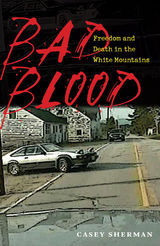 Bad Blood: Freedom and Death in the White Mountains
Casey Sherman
University Press of New England, 2012 In the shadow of the fallen Old Man of the Mountain, on a lonely stretch of mountain road, two men lay dead. A spasm of violence that took only a few minutes to play out leaves a community divided and searching for answers. From the author of newly released Boston Strong: A City’s Triumph Over Tragedy, about the 2013 Boston Marathon bombings, Bad Blood is the riveting account of the long-standing feud between Franconia, New Hampshire, police officer Bruce McKay, 48, and Liko Kenney, 24. In May 2007, Kenney shot and killed Officer McKay, following a dramatic chase that began with a routine traffic stop. Kenney, cousin of ski legend Bode Miller, was then shot and killed by a shadowy passerby. Almost immediately, the tragic incident revealed deep tensions within this otherwise quiet community in the White Mountains with charges that Kenney was a hell-raiser and mentally unstable and counter-charges that Officer McKay was a rogue cop who dispensed justice as a way to settle personal scores. Striving to get at the truth of the story, the author uncovers a complicated mix of personalities and motivations. Local and statewide interests clash while regional and national media— and even YouTube viewers— supply ready stereotypes to fit their agendas. Amid larger questions of the meaning of individual freedom we are, ultimately, helpless witnesses to an inevitable clash of characters.
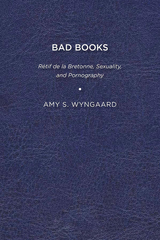 Bad Books: Rétif de la Bretonne, Sexuality, and Pornography
Amy S. Wyngaard
University of Delaware Press, 2013 Bad Books reconstructs how the eighteenth-century French author Nicolas-Edme Rétif de la Bretonne and his writings were at the forefront of the development of modern conceptions of sexuality and pornography. Although certain details are well known (for example, that Rétif’s 1769 treatise on prostitution, Le Pornographe, is the work from which the term pornography is derived, or that he was an avid foot and shoe fetishist), much of this story has been obscured and even forgotten: how the author actively worked to define the category of obscenity and the modern pornographic genre; how he coined the psycho-sexual term “fetish” and played a central role in the formation of theories of sexual fetishism in the late nineteenth and early twentieth centuries. Thus this book is also about literary history and how it is written: it explores how Rétif, perceived as a bad author in both senses of the term, and his contributions were glossed over or condemned, such that the originality of his texts has still not been fully established.
Published by University of Delaware Press. Distributed worldwide by Rutgers University Press.
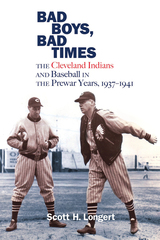 Bad Boys, Bad Times: The Cleveland Indians and Baseball in the Prewar Years, 1937–1941
Scott H. Longert
Ohio University Press, 2019 In 1937, the Great Depression was still lingering, but at baseball parks across the country there was a sense of optimism. Major League attendance was on a sharp rise. Tickets to an Indians game at League Park on Lexington and East 66th were $1.60 for box seats, $1.35 for reserve seats, and $.55 for the bleachers. Cleveland fans were particularly upbeat—Bob Feller, the teenage phenomenon, was a farm boy with a blistering fast ball. Night games were an exciting development. Better days were ahead. But there were mounting issues facing the Indians. For one thing, it was rumored that the team had illegally signed Feller. Baseball Commissioner Judge Kenesaw Mountain Landis was looking into that matter and one other. Issues with an alcoholic catcher, dugout fights, bats thrown into stands, injuries, and a player revolt kept things lively. In Bad Boys, Bad Times: The Cleveland Indians and Baseball in the Prewar Years, 1937–1941—the follow-up to his No Money, No Beer, No Pennants: The Cleveland Indians and Baseball in the Great Depression—baseball historian Scott H. Longert writes about an exciting period for the team, with details and anecdotes that will please fans all over.
Bad Boys: Public Schools in the Making of Black Masculinity
Ann Arnett Ferguson
University of Michigan Press, 2020 Black males are disproportionately "in trouble" and suspended from the nation’s school systems. This is as true now as it was when Ann Arnett Ferguson’s now classic Bad Boys was first published. Bad Boys offers a richly textured account of daily interactions between teachers and students in order to demonstrate how a group of eleven- and twelve-year-old males construct a sense of self under adverse circumstances. This new edition includes a foreword by Pedro A. Noguera, and an afterword and bibliographic essay by the author, all of which reflect on the continuing relevance of this work nearly two decades after its initial publication.
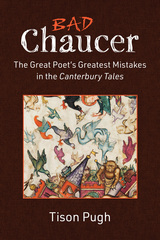 Bad Chaucer: The Great Poet’s Greatest Mistakes in the Canterbury Tales
Tison Pugh
University of Michigan Press, 2024 Acclaimed for centuries as the “Father of English Literature,” Geoffrey Chaucer enjoys widespread and effusive praise for his classic Canterbury Tales—and rightfully so. Still, even the greatest of authors cannot claim perfection, and so Bad Chaucer: The Great Poet’s Greatest Mistakes in the Canterbury Tales analyzes his various missteps, missed opportunities, and other blunders in this peerless masterpiece. From a vexing catalog of trees in the Knight’s Tale to the flirtations with blasphemy in the Parson’s Tale, this volume progresses through the Canterbury Tales story by story, tale by tale, pondering the most egregious failing of each in turn. Viewed collectively, Chaucer’s troubles stem from clashing genres that disrupt interpretive clarity, themeless themes that undermine any message a tale might convey, mischaracterized characters who act without clear motivation, purposeful and otherwise pleasureful badness that show Chaucer’s appreciation for the humor of bad literature, and outmoded perspectives that threaten to alienate modern readers. Badness is not always to be lamented but often celebrated, even cherished, for badness infuses artistic creations with the vitality that springs from varied responses, spirited engagements, and the inherent volatility of enjoying literature. On the whole, Bad Chaucer: The Great Poet’s Greatest Mistakes in the Canterbury Tales swerves literary criticism in a new direction by examining the provocative question, for too long overlooked, of what this great author got wrong.
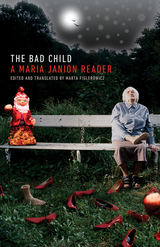 The Bad Child: A Maria Janion Reader
Maria Janion
University of Minnesota Press, 2025 Collected writings from a visionary thinker about the perilous edge between patriotism and fascism
How do nationalism and patriotism shape our understanding of identity, and when do they drift into dangerous territory? Marta Figlerowicz gathers a selection of writings from Maria Janion, one of Eastern Europe’s most profound and original intellectuals, to explore this fine line. Between her birth in Vilnius in 1926 and her death in Warsaw in 2020, Janion witnessed some of the most consequential events of the turbulent twentieth century: the rise of authoritarian nationalism in Poland, German occupation during World War II, Soviet control, and Poland’s uneasy integration into the West. As Western countries face their own nationalist resurgences, Janion’s writing holds tools to help move through this historical condition. The Bad Child offers sharp insights into how societies develop and assert their identities and histories—often at the cost of the people. Janion’s reflections on fascism, popular culture, and national self-fashioning presciently name and critique regional dynamics that have most recently resulted in the war between Russia and Ukraine, and they broadly expose the illusions that cultures can promote and the dangerous slide from national pride to exclusionary right-wing politics. A queer woman and survivor of World War II, a leftist who resisted Soviet orthodoxy, Janion lends a uniquely disruptive voice to contemporary discussions of fascism, and her insights resonate far beyond her Eastern European roots. Retail e-book files for this title are screen-reader friendly with images accompanied by short alt text and/or extended descriptions.
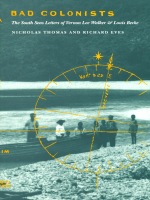 Bad Colonists: The South Seas Letters of Vernon Lee Walker and Louis Becke
Nicholas Thomas and Richard Eves
Duke University Press, 1999 In Bad Colonists Nicholas Thomas and Richard Eves provide a window into the fantasies and realities of colonial life by presenting separate sets of letters by two late-nineteenth-century British colonists of the South Pacific: Vernon Lee Walker and Louis Becke. Thomas and Eves frame the letters—addressed mostly to the colonists’ mothers—with commentary that explores colonial degeneration in the South Pacific. Using critical anthropology and theories of history-making to view the letter as artifact and autobiography, they examine the process whereby men and women unraveled in the hot, violent, uncivil colonial milieu.
An obscure colonial trader, Walker wrote to his mother in England from Australia, the New Hebrides (now Vanuatu), and New Caledonia—and also from ships in between those places—during the 1870s and 1880s. Becke was a trader, too, but he was also a successful author of popular fiction that drew on his experiences in the Pacific. Written from Micronesia in the early 1880s, Becke’s letters are like Walker’s in that they report one setback after another. Both collections vividly evoke the day-to-day experiences of ordinary late-nineteenth-century colonists and open up new questions concerning the making and writing of selves on the colonial periphery.
Exposing insecurities in an epoch normally regarded as one of imperial triumph, Bad Colonists will appeal to students and scholars of anthropology, colonial history, cultural studies, and Pacific history and culture.
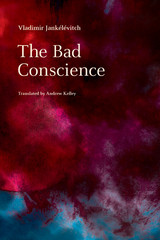 The Bad Conscience
Vladimir Jankélévitch
University of Chicago Press, 2014 Vladimir Jankélévitch was one of the most distinctive voices in twentieth-century philosophy. In The Bad Conscience—published in 1933 and subsequently revised and expanded—Jankélévitch lays the foundations for his later work, Forgiveness, grappling with the conditions that give rise to the moral awareness without which forgiveness would make no sense. Remorse, or “the bad conscience,” arises from the realization that the acts one has committed become irrevocable. This realization, in turn, gives rise to an awareness of moral virtues and values, as well as freedom and the responsibilities freedom entails. Thus, while the majority of moral systems try to shield us from remorse, the remedy for the bad conscience lies not in repentance but in the experience of remorse itself.
To this careful and sensitive English-language translation of The Bad Conscience, translator Andrew Kelley has added a substantial introduction situating the work in historical and intellectual context. Notes throughout indicate differences between this and earlier editions. A thought-provoking critique of standard conceptions of moral philosophy, The Bad Conscience restores this work by an important philosopher who has only recently begun to receive his due from the English-speaking world.
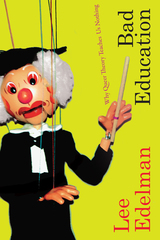 Bad Education: Why Queer Theory Teaches Us Nothing
Lee Edelman
Duke University Press, 2022 Long awaited after No Future, and making queer theory controversial again, Lee Edelman’s Bad Education proposes a queerness without positive identity—a queerness understood as a figural name for the void, itself unnamable, around which the social order takes shape. Like Blackness, woman, incest, and sex, queerness, as Edelman explains it, designates the antagonism, the structuring negativity, preventing that order from achieving coherence. But when certain types of persons get read as literalizing queerness, the negation of their negativity can seem to resolve the social antagonism and totalize community. By translating the nothing of queerness into the something of “the queer,” the order of meaning defends against the senselessness that undoes it, thus mirroring, Edelman argues, education’s response to queerness: its sublimation of irony into the meaningfulness of a world. Putting queerness in relation to Lacan’s “ab-sens” and in dialogue with feminist and Afropessimist thought, Edelman reads works by Shakespeare, Jacobs, Almodóvar, Lemmons, and Haneke, among others, to show why queer theory’s engagement with queerness necessarily results in a bad education that is destined to teach us nothing.
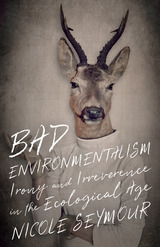 Bad Environmentalism: Irony and Irreverence in the Ecological Age
Nicole Seymour
University of Minnesota Press, 2018 Traces a tradition of ironic and irreverent environmentalism, asking us to rethink the movement’s reputation for gloom and doom Activists today strive to educate the public about climate change, but sociologists have found that the more we know about alarming issues, the less likely we are to act. Meanwhile, environmentalists have acquired a reputation as gloom-and-doom killjoys. Bad Environmentalism identifies contemporary texts that respond to these absurdities and ironies through absurdity and irony—as well as camp, frivolity, irreverence, perversity, and playfulness. Nicole Seymour develops the concept of “bad environmentalism”: cultural thought that employs dissident affects and sensibilities to reflect critically on our current moment and on mainstream environmental activism. From the television show Wildboyz to the short film series Green Porno, Seymour shows that this tradition of thought is widespread—spanning animation, documentary, fiction film, performance art, poetry, prose fiction, social media, and stand-up comedy since at least 1975. Seymour argues that these texts reject self-righteousness and sentimentality, undercutting public negativity toward activism and questioning basic environmentalist assumptions: that love and reverence are required for ethical relationships with the nonhuman and that knowledge is key to addressing problems like climate change. Funny and original, Bad Environmentalism champions the practice of alternative green politics. From drag performance to Indigenous comedy, Seymour expands our understanding of how environmental art and activism can be pleasurable, even in a time of undeniable crisis.
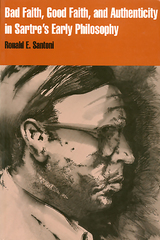 Bad Faith Good Faith
Ronald E. Santoni
Temple University Press, 1995 From the beginning to the end of his philosophizing, Sartre appears to have been concerned with "bad faith"—our "natural" disposition to flee from our freedom and to lie to ourselves. Virtually no aspect of his monumental system has generated more attention. Yet bad faith has been plagued by misinterpretation and misunderstanding. At the same time, Sartre's correlative concepts of "good faith" and "authenticity" have suffered neglect or insufficient attention, or been confused and wrongly identified by Sartre scholars, even by Sartre himself. Ronald E. Santoni takes on the challenge of distinguishing these concepts, and of showing whether either or both existential "attitudes" afford deliverance from the hell of Sartre's bad faith. He offers the first fill-scale analysis, reconstruction, and differentiation of these ways of existing as they develop in Sartre's early works (1937-1947). Although he attempts to redeem Sartre's slighted concept of good faith, Santoni warns that it must not be viewed interchangeably with authenticity. Further, in one of the earliest and most sustained studies of Sartre's Notebooks for an Ethics available in English, Santoni shows how Sartre's posthumously published notes for an "ethics of Salvation" confirm his differentiation and argument. The way out of Sartrean hell, Santoni insists, is authenticity—living "with fidelity" to our unjustifiable freedom and assuming responsibility for it.
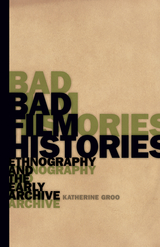 Bad Film Histories: Ethnography and the Early Archive
Katherine Groo
University of Minnesota Press, 2019 A daring, deep investigation into ethnographic cinema that challenges standard ways of writing film history and breaks important new ground in understanding archives
Bad Film Histories is a vital work that unsettles the authority of the archive. Katherine Groo daringly takes readers to the margins of the film record, addressing the undertheorization of film history and offering a rigorous corrective. Taking ethnographic cinema as a crucial case study, Groo challenges standard ways of thinking and writing about film history and questions widespread assumptions about what film artifacts are and what makes them meaningful. Rather than filling holes, Groo endeavors to understand the imprecisions and absences that define film history and its archives. Bad Film Histories draws on numerous works of ethnographic cinema, from Edward S. Curtis’s In the Land of the Head Hunters, to a Citroën-sponsored “croisière” across Africa, to the extensive archives of the Maison Lumière and the Musée Albert-Kahn, to dozens of expedition films from the 1910s and 1920s. The project is deeply grounded in poststructural approaches to history, and throughout Groo draws on these frameworks to offer innovative and accessible readings that explain ethnographic cinema’s destabilizing energies. As Groo describes, ethnographic works are mostly untitled, unauthored, seemingly infinite in number, and largely unrestored even in their digital afterlives. Her examination of ethnographic cinema provides necessary new thought for both film scholars and those who are thrilled by cinema’s boundless possibilities. In so doing, she boldly reexamines what early ethnographic cinema is and how these films produce meaning, challenging the foundations of film history and prevailing approaches to the archive.
 Bad Girls Dirty Pictures: The Challenge to Reclaim Feminism
Alison Assiter and Avedon Carol
Pluto Press, 1993 For well over a decade, half-baked analysis and phony science have been used by some feminists to side-track the women's movement into puritanical campaigns against sexual material and imaginative sexual exploration.
Many feminists would say that this widely publicised version of feminism is itself sexist, and that the increasingly vocal anti-pornography campaigns are founded on theoretical dead-ends that have allowed feminists to deviate drastically from the basic goals of women's liberation.
Bad Girls & Dirty Pictures puts these anti-sex, anti-porn arguments under the microscope of a more thorough and considered feminist analysis. It examines the flaws in the research that purports to prove the harm of pornography and warns against the continuing use of censorship by politicians and the moral right, as well as exposing the dangers of anti-porn feminist arguments.
Contributions from a wide range of women, including sex workers and academics, remind us that pornography does not have a special place in our oppression, and that censorship must still be seen as dangerous enemy of women. Bad Girls & Dirty Pictures is a much-needed antidote to falsehoods, shabby thinking, and patronising sexism that have fuelled anti-pornography campaigns and misled the women's movement.
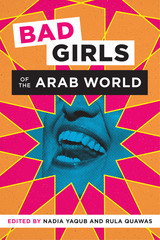 Bad Girls of the Arab World
Edited by Nadia Yaqub and Rula Quawas
University of Texas Press, 2017 Women’s transgressive behaviors and perspectives are challenging societal norms in the Arab world, giving rise to anxiety and public debate. Simultaneously, however, other Arab women are unwillingly finding themselves labeled “bad” as authority figures attempt to redirect scrutiny from serious social ills such as patriarchy and economic exploitation, or as they impose new restrictions on women’s behavior in response to uncertainty and change in society. Bad Girls of the Arab World elucidates how both intentional and unintentional transgressions make manifest the social and cultural constructs that define proper and improper behavior, as well as the social and political policing of gender, racial, and class divisions. The works collected here address the experiences of women from a range of ages, classes, and educational backgrounds who live in the Arab world and beyond. They include short pieces in which the women themselves reflect on their experiences with transgression; academic articles about performance, representation, activism, history, and social conditions; an artistic intervention; and afterwords by the acclaimed novelists Laila al-Atrash and Miral al-Tahawy. The book demonstrates that women’s transgression is both an agent and a symptom of change, a site of both resistance and repression. Showing how transnational forces such as media discourses, mobility and confinement, globalization, and neoliberalism, as well as the legacy of colonialism, shape women’s badness, Bad Girls of the Arab World offers a rich portrait of women’s varied experiences at the boundaries of propriety in the twenty-first century.
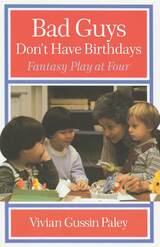 Bad Guys Don't Have Birthdays: Fantasy Play at Four
Vivian Gussin Paley
University of Chicago Press, 1991 Bad guys are not allowed to have birthdays, pick blueberries, or disturb the baby. So say the four-year-olds who announce life's risks and dangers as they play out the school year in Vivian Paley's classroom.
Their play is filled with warnings. They invent chaos in order to show that everything is under control. They portray fear to prove that it can be conquered. No theme is too large or too small for their intense scrutiny. Fantasy play is their ever dependable pathway to knowledge and certainty.
" It . . . takes a special teacher to value the young child's communications sufficiently, enter into a meaningful dialogue with the youngster, and thereby stimulate more productivity without overwhelming the child with her own ideas. Vivian Paley is such a teacher."—Maria W. Piers, in the American Journal of Education
"[Mrs. Paley's books] should be required reading wherever children are growing. Mrs. Paley does not presume to understand preschool children, or to theorize. Her strength lies equally in knowing that she does not know and in trying to learn. When she cannot help children—because she can neither anticipate nor follow their thinking—she strives not to hinder them. She avoids the arrogance of adult to small child; of teacher to student; or writer to reader."—Penelope Leach, author of Your Baby & Child in the New York Times Book Review
"[Paley's] stories and interpretation argue for a new type of early childhood education . . . a form of teaching that builds upon the considerable knowledge children already have and grapple with daily in fantasy play."—Alex Raskin, Los Angeles Times Book Review
"Through the 'intuitive language' of fantasy play, Paley believes, children express their deepest concerns. They act out different roles and invent imaginative scenarios to better understand the real world. Fantasy play helps them cope with uncomfortable feelings. . . . In fantasy, any device may be used to draw safe boundaries."—Ruth J. Moss, Psychology Today
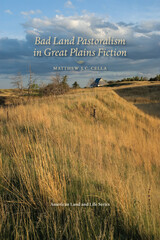 Bad Land Pastoralism in Great Plains Fiction
Matthew J. C. Cella
University of Iowa Press, 2010 At the core of this nuanced book is the question that ecocritics have been debating for decades: what is the relationship between aesthetics and activism, between art and community? By using a pastoral lens to examine ten fictional narratives that chronicle the dialogue between human culture and nonhuman nature on the Great Plains, Matthew Cella explores literary treatments of a succession of abrupt cultural transitions from the Euroamerican conquest of the “Indian wilderness” in the nineteenth century to the Buffalo Commons phenomenon in the twentieth. By charting the shifting meaning of land use and biocultural change in the region, he posits this bad land—the arid West—as a crucible for the development of the human imagination. Each chapter deals closely with two novels that chronicle the same crisis within the Plains community. Cella highlights, for example, how Willa Cather reconciles her persistent romanticism with a growing disillusionment about the future of rural Nebraska, how Tillie Olsen and Frederick Manfred approach the tragedy of the Dust Bowl with strikingly similar visions, and how Annie Proulx and Thomas King use the return of the buffalo as the centerpiece of a revised mythology of the Plains as a palimpsest defined by layers of change and response. By illuminating these fictional quests for wholeness on the Great Plains, Cella leads us to understand the intricate interdependency of people and the places they inhabit. Cella uses the term “pastoralism” in its broadest sense to mean a mode of thinking that probes the relationship between nature and culture: a discourse concerned with human engagement—material and nonmaterial—with the nonhuman community. In all ten novels discussed in this book, pastoral experience—the encounter with the Beautiful—leads to a renewed understanding of the integral connection between human and nonhuman communities. Propelling this tradition of bad land pastoralism are an underlying faith in the beauty of wholeness that comes from inhabiting a continuously changing biocultural landscape and a recognition of the inevitability of change. The power of story and language to shape the direction of that change gives literary pastoralism the potential to support an alternative series of ideals based not on escape but on stewardship: community, continuity, and commitment.
The Bad Lands: A Novel
Oakley Hall
University of Chicago Press, 2016 It’s 1883 in Johnson County, in the old Dakota Territory—a rugged, wide-open landscape of rolling, red earth, prairie, and cattle as far as the eye can see. But the land is closing, the “Beef Bonanza” is ending, and the free-range cattlemen are stuck watching a way of life disappear in a blaze of drought and gunfire.
An action-packed western from one of the masters of the genre, Oakley Hall’s The Bad Lands blends roundups and rustlers, whorehouses and land grabs, shoot-outs and the threat of hangings in a tale of the war between the cowboys and the cattle barons. But more than this, it is an elegy to the wild beauty of the badlands before the ranchers moved in, chased off the free-rangers, the trappers, and the tribes, and fenced it all in.
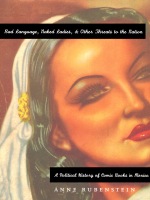 Bad Language, Naked Ladies, and Other Threats to the Nation: A Political History of Comic Books in Mexico
Anne Rubenstein
Duke University Press, 1998 In Bad Language, Naked Ladies, and Other Threats to the Nation, Anne Rubenstein examines how comic books—which were overwhelmingly popular but extremely controversial in post-revolutionary Mexico—played an important role in the development of a stable, legitimate state. Studying the relationship of the Mexican state to its civil society from the 1930s to the 1970s through comic books and their producers, readers, and censors, Rubenstein shows how these thrilling tales of adventure—and the debates over them—reveal much about Mexico’s cultural nationalism and government attempts to direct, if not control, social change.
Since their first appearance in 1934, comic books enjoyed wide readership, often serving as a practical guide to life in booming new cities. Conservative protest against the so-called immorality of these publications, of mass media generally, and of Mexican modernity itself, however, led the Mexican government to establish a censorship office that, while having little impact on the content of comic books, succeeded in directing conservative ire away from government policies and toward the Mexican media. Bad Language, Naked Ladies, and Other Threats to the Nation examines the complex dynamics of the politics of censorship occasioned by Mexican comic books, including the conservative political campaigns against them, government and industrial responses to such campaigns, and the publishers’ championing of Mexican nationalism and their efforts to preserve their publishing empires through informal influence over government policies. Rubenstein’s analysis suggests a new Mexican history after the revolution, one in which negotiation over cultural questions replaced open conflict and mass-media narrative helped ensure political stability.
This book will engage readers with an interest in Mexican history, Latin American studies, cultural studies, and popular culture.
 Bad Medicine: Settler Colonialism and the Institutionalization of American Indians
Sarah A. Whitt
Duke University Press, 2025 In Bad Medicine, Sarah A. Whitt exposes how Native American boarding schools and other settler institutions like asylums, factories, and hospitals during the late nineteenth and early twentieth centuries worked together as a part of an interconnected system of settler domination. In so doing, Whitt centers the experiences of Indigenous youth and adults alike at the Carlisle Indian School, Canton Asylum for Insane Indians, Ford Motor Company Factory, House of the Good Shepherd, and other Progressive Era facilities. She demonstrates that in the administration of these institutions, which involved moving Indigenous people from one location to another, everyday white Americans became deputized as agents of the settler order. Bringing together Native American history, settler colonial studies, and the history of medicine, Whitt breaks new ground by showing how the confinement of Indigenous people across interlocking institutional sites helped concretize networks of white racial power—a regime that Native nations and communities continue to negotiate and actively resist today.
 Bad Mexican, Bad American: Poems
Jose Hernandez Diaz
Acre Books, 2024 This collection of poems by Jose Hernandez Diaz showcases the unique style that has made him a rising star in the poetry community.
In Bad Mexican, Bad American, the minimalist, working-class aesthetic of a “disadvantaged Brown kid” takes wing in prose poems that recall and celebrate that form’s ties to Surrealism. With influences like Alberto Ríos and Ray Gonzalez on one hand, and James Tate and Charles Baudelaire on the other, the collection spectacularly combines “high” art and folk art in a way that collapses those distinctions, as in the poem “My Date with Frida Kahlo”: “Frida and I had Cuban coffee and then vegetarian tacos. We sipped on mescal and black tea. At the end of the night, following an awkward silence during a conversation on Cubism, we kissed for about thirty minutes beneath a protest mural by David Alfaro Siqueiros.”
Bad Mexican, Bad American demonstrates how having roots in more than one culture can be both unsettling and rich: van Gogh and Beethoven share the page with tattoos, graffiti, and rancheras; Quetzalcoatl shows up at Panda Express; a Mexican American child who has never had a Mexican American teacher may become that teacher; a parent’s “broken” English is beautiful and masterful. Blending reality with dream and humility with hope, Hernandez Diaz contributes a singing strand to the complex cultural weave that is twenty-first-century poetry.
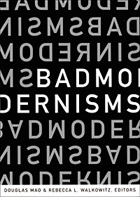 Bad Modernisms
Douglas Mao and Rebecca L. Walkowitz, eds.
Duke University Press, 2006 Modernism is hot again. At the dawn of the twenty-first century, poets and architects, designers and critics, teachers and artists are rediscovering the virtues of the previous century’s most vibrant cultural constellation. Yet this widespread embrace raises questions about modernism’s relation to its own success. Modernism’s “badness”—its emphasis on outrageous behavior, its elevation of negativity, its refusal to be condoned—seems essential to its power. But once modernism is accepted as “good” or valuable (as a great deal of modernist art now is), its status as a subversive aesthetic intervention seems undermined. The contributors to Bad Modernisms tease out the contradictions in modernism’s commitment to badness. Bad Modernisms thus builds on and extends the “new modernist studies,” recent work marked by the application of diverse methods and attention to texts and artists not usually labeled as modernist. In this collection, these developments are exemplified by essays ranging from a reading of dandyism in 1920s Harlem as a performance of a “bad” black modernist imaginary to a consideration of Filipino American modernism in the context of anticolonialism. The contributors reconsider familiar figures—such as Virginia Woolf, D. H. Lawrence, Josef von Sternberg, Ludwig Wittgenstein, W. H. Auden, and Wyndham Lewis—and bring to light the work of lesser-known artists, including the writer Carlos Bulosan and the experimental filmmaker Len Lye. Examining cultural artifacts ranging from novels to manifestos, from philosophical treatises to movie musicals, and from anthropological essays to advertising campaigns, these essays signal the capaciousness and energy galvanizing the new modernist studies. Contributors. Lisa Fluet, Laura Frost, Michael LeMahieu, Heather K. Love, Douglas Mao, Jesse Matz, Joshua L. Miller, Monica L. Miller, Sianne Ngai, Martin Puchner, Rebecca L. Walkowitz
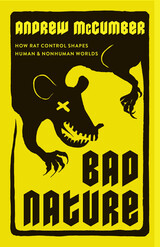 Bad Nature: How Rat Control Shapes Human and Nonhuman Worlds
Andrew McCumber
University of Chicago Press, 2025 Offers insights into the social and cultural implications of humans’ relationships with rats and the natural world.
Apart from the occasional pet owner who has rats, most people regard rats as disease-carrying nocturnal pests, scurrying around dumpsters and dragging slices of pizza through New York City subways. Since rats are seemingly omnipresent in human life, why do we harbor such negative feelings about them, and why are they among the creatures most frequently targeted for systematic extermination?
In Bad Nature, sociologist Andrew McCumber draws out the cultural underpinnings of rat extermination across three countries and two continents. Drawing from ethnographic, interview, and textual data from the frigid prairie of Alberta, Canada; the heart of downtown Los Angeles, California; and the iconic Galápagos Islands of Ecuador, McCumber studies how humans have sought to suppress and exterminate rat populations in a variety of environmental, social, and political situations. He shows how, in these disparate locations, rat control is a social practice that draws and clarifies the spatial and symbolic boundaries between “good” and “bad” forms of nature. Rats are near the bottom of a symbolic hierarchy of species that places human life at the top, companion animals and majestic wildlife just below them, and the “invasive species” that call for systematic extermination at the very bottom. This hierarchy of living things that places rats at the bottom, McCumber argues, mirrors human systems of social inequalities and power dynamics.
Both original and engaging, Bad Nature urges readers to consider, when charting a just and sustainable future, where will the rats be placed in the worlds we envision?
 Bad Nature: How Rat Control Shapes Human and Nonhuman Worlds
Andrew McCumber
University of Chicago Press, 2025 This is an auto-narrated audiobook version of this book.
Offers insights into the social and cultural implications of humans’ relationships with rats and the natural world.
Apart from the occasional pet owner who has rats, most people regard rats as disease-carrying nocturnal pests, scurrying around dumpsters and dragging slices of pizza through New York City subways. Since rats are seemingly omnipresent in human life, why do we harbor such negative feelings about them, and why are they among the creatures most frequently targeted for systematic extermination?
In Bad Nature, sociologist Andrew McCumber draws out the cultural underpinnings of rat extermination across three countries and two continents. Drawing from ethnographic, interview, and textual data from the frigid prairie of Alberta, Canada; the heart of downtown Los Angeles, California; and the iconic Galápagos Islands of Ecuador, McCumber studies how humans have sought to suppress and exterminate rat populations in a variety of environmental, social, and political situations. He shows how, in these disparate locations, rat control is a social practice that draws and clarifies the spatial and symbolic boundaries between “good” and “bad” forms of nature. Rats are near the bottom of a symbolic hierarchy of species that places human life at the top, companion animals and majestic wildlife just below them, and the “invasive species” that call for systematic extermination at the very bottom. This hierarchy of living things that places rats at the bottom, McCumber argues, mirrors human systems of social inequalities and power dynamics.
Both original and engaging, Bad Nature urges readers to consider, when charting a just and sustainable future, where will the rats be placed in the worlds we envision?
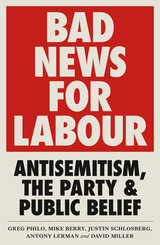 Bad News for Labour: Antisemitism, the Party and Public Belief
Greg Philo
Pluto Press, 2019 Jointly written by five leading voices on the topic, this book looks at the contentious issue of antisemitism in the Labour Party today, and sets out ways of addressing the problem while maintaining the integrity of the organisation. The first part of the book includes original material on public beliefs about antisemitism in the Labour Party, and the kinds of problems this poses regarding voting intentions and demoralization of the membership. The writers then investigate the institutional problems and policy decisions that prevented a coherent and well-planned response from the party, and how Labour can rectify this today. The book progresses to explore in depth the coverage of the issue in mainstream media outlets, and the partial accounts presented to the public. The writers focus on the debates around the IHRA definition, and the accusations made against David Miller which were eventually dismissed and set an important precedent. At the end of the book, Mike Berry provides a helpful chronological account of the arguments surrounding this issue from the beginning of Corbyn's leadership to the present.
Bad News for Refugees
Greg Philo, Emma Briant, and Pauline Donald
Pluto Press, 2013 Bad News for Refugees analyses the political, economic and environmental contexts of migration and looks specifically at how refugees and asylum seekers have been stigmatised in political rhetoric and in media coverage.
Through forensic research it shows how hysterical and inaccurate media accounts act to legitimise political action which can have terrible consequences both on the lives of refugees and also on established migrant communities.
Based on new research by the renowned Glasgow Media Group, Bad News for Refugees is essential reading for those concerned with the negative effects of media on public understanding and for the safety of vulnerable groups and communities in our society.
 Bad News, Good News: Conversational Order in Everyday Talk and Clinical Settings
Douglas W. Maynard
University of Chicago Press, 2003 When we share or receive good or bad news, from ordinary events such as the birth of a child to public catastrophes such as 9/11, our "old" lives come to an end, and suddenly we enter a new world. In Bad News, Good News, Douglas W. Maynard explores how we tell and hear such news, and what's similar and different about our social experiences when the tidings are bad rather than good or vice versa.
Uncovering vocal and nonvocal patterns in everyday conversations, clinics, and other organizations, Maynard shows practices by which people give and receive good or bad news, how they come to realize the news and their new world, how they suppress or express their emotions, and how they construct social relationships through the sharing of news. He also reveals the implications of his study for understanding public affairs in which transmitting news may influence society at large, and he provides recommendations for professionals and others on how to deliver bad or good tidings more effectively.
For anyone who wants to understand the interactional facets of news delivery and receipt and their social implications, Bad News, Good News offers a wealth of scholarly insights and practical advice.
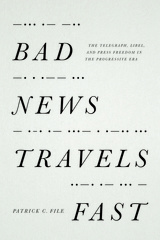 Bad News Travels Fast: The Telegraph, Libel, and Press Freedom in the Progressive Era
Patrick C. File
University of Massachusetts Press, 2019 At the turn of the twentieth century, American journalists transmitted news across the country by telegraph. But what happened when these stories weren't true? In Bad News Travels Fast, Patrick C. File examines a series of libel cases by a handful of plaintiffs—including socialites, businessmen, and Annie Oakley—who sued newspapers across the country for republishing false newswire reports. Through these cases, File demonstrates how law and technology intertwined to influence debates about reputation, privacy, and the acceptable limits of journalism.
This largely forgotten era in the development of American libel law provides crucial historical context for contemporary debates about the news media, public discourse, and the role of a free press. File argues that the legal thinking surrounding these cases laid the groundwork for the more friendly libel standards the press now enjoys and helped to establish today's regulations of press freedom amid the promise and peril of high-speed communication technology.
 Bad Object
Elizabeth Weed and Ellen Rooney, special issue editors
Duke University Press, 2017 Before her death in 2001, Naomi Schor was a leading scholar in feminist and critical theory and a founding coeditor of differences: A Journal of Feminist Cultural Studies. This issue takes as its starting point Schor’s book Bad Objects: Essays Popular and Unpopular (1995), in which she discussed her attraction to the “bad objects” the academy had overlooked or ignored: universalism, essentialism, and feminism. Underpinning these bad objects was her mourning of the literary, a sense that her work—and feminist theory more generally—had departed from the textual readings in which they were grounded.
Schor’s question at the time was “Will a new feminist literary criticism arise that will take literariness seriously while maintaining its vital ideological edge?” The contributors take literariness—the “bad object” of this issue—seriously. They do not necessarily engage in debates about reading, theorize new formalisms, or thematize language; rather, they invigorate and unsettle the reading experience, investigating the relationship between language and meaning.
Contributors. Lee Edelman, Frances Ferguson, Peggy Kamuf, Ramsey McGlazer, Thangam Ravindranathan, Denise Riley, Ellen Rooney, Elizabeth Weed
 Bad Objects: Essays Popular and Unpopular
Naomi Schor
Duke University Press, 1995 Bad objects are a contrarian’s delight. In this volume, leading French feminist theorist and literary critic Naomi Schor revisits some of feminist theory’s most widely discredited objects, essentialism and universalism, with surprising results. Bilingual and bicultural, she reveals the national character of contemporary theories that are usually received as beyond borders, while making a strong argument for feminist theory’s specific claims to universalism.
Written in a distinctive personal and self-reflective mode, this collection offers new unpublished work and brings together for the first time some of Schor’s best-known and most influential essays. These engagements with Anglo-American feminist theory, Freud and psychoanalytic theory, French poststructuralists such as Barthes, Foucault, and Irigaray, and French fiction by or about women—especially of the nineteenth century—also address such issues as bilingual identity, professional controversies, female fetishism, and literature and gender. Schor then concludes with a provocative meditation on the future of feminism.
As they read Bad Objects, Anglo-American theoreticians who have been mainly preoccupied with French feminism will find themselves drawn into French literary and cultural history, while French literary critics and historians will be placed in contact with feminist debate.
 Bad Sheep
Katja Lange-Müller
Seagull Books, 2024 A touching and sensitive tale of love and loss that unfolds in a divided Berlin in the 1980s.
Against the backdrop of West Berlin in 1987, meet Soja—a skilled typesetter, a refugee from East Germany, and a temporary florist with a generous heart. Her life takes an unexpected turn when she crosses paths with Harry—a tall, free-spirited individual with a quietly determined demeanor, haunted by a complex past and an uncertain future. Their encounter sets in motion a fateful connection that leaves a lasting mark on Soja’s life.
The remnants of their story are encapsulated in a school notebook, containing precisely eighty-nine undated entries where Harry chronicled his thoughts during their time together. However, conspicuous by its absence in the narrative is Soja herself. Years later, driven by the need to tell their tale and fill the void left by Harry, she embarks on a poignant journey of remembrance.
As Soja revisits the man who both impressed her with determination and disconcerted her with a mysterious gift, she finds herself captivated by his childlike essence. Despite Harry’s troubled history—ten years in prison, probation violations due to discontinued drug therapy, and the looming threat of immediate imprisonment—Soja remains resolute in her passion for him.
Katja Lange-Müller, an acclaimed storyteller, skillfully draws readers into the heart of this novel. With sensitivity, humor, and melancholy, she unfolds the narrative of an unhappy love story that transforms into the greatest happiness in life. Along the way, Lange-Müller paints an atmospherically dense portrait of the divided and stagnant Berlin of the 1980s, creating a captivating and emotionally charged reading experience.
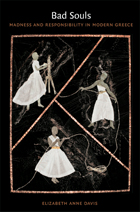 Bad Souls: Madness and Responsibility in Modern Greece
Elizabeth Anne Davis
Duke University Press, 2012 Bad Souls is an ethnographic study of responsibility among psychiatric patients and their caregivers in Thrace, the northeastern borderland of Greece. Elizabeth Anne Davis examines responsibility in this rural region through the lens of national psychiatric reform, a process designed to shift treatment from custodial hospitals to outpatient settings. Challenged to help care for themselves, patients struggled to function in communities that often seemed as much sources of mental pathology as sites of refuge. Davis documents these patients' singular experience of community, and their ambivalent aspirations to health, as they grappled with new forms of autonomy and dependency introduced by psychiatric reform. Planned, funded, and overseen largely by the European Union, this "democratic experiment," one of many reforms adopted by Greece since its accession to the EU in the early 1980s, has led Greek citizens to question the state and its administration of human rights, social welfare, and education. Exploring the therapeutic dynamics of diagnosis, persuasion, healing, and failure in Greek psychiatry, Davis traces the terrains of truth, culture, and freedom that emerge from this questioning of the state at the borders of Europe.
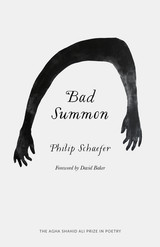 Bad Summon
Philip Schaefer
University of Utah Press, 2017
Winner of the Agha Shahid Ali Poetry Prize
Bad Summon explores the relationship between the majesty of nature and the quiet violence humans inflict upon themselves and others. The poems are dipped in loss, traveling between death and mountains, romance and rivers. They are addicted to the truth of experience and the energy behind regret. Bad Summon conjures its own ghost. According to David Baker, the judge who selected the winning manuscript, this is a “surprising, coherent, original collection of lyric poems. I felt peril, heartbreak, catastrophe, sorrow, genuine soulfulness. It’s also funny, yet its humor is not comic but possesses a terrible gravity.” This is a volume every poetry lover will want to explore.
[In this one we aren’t exactly drowning]
but we are falling through water.
Quieter than we expect. Churning
is how we’ll later describe it.
Our arms dig out two wet Cs,
a heart if you want to look at it
that way. Though the body is always
in between—that unoriginal arrow.
 Bad Water: Nature, Pollution, and Politics in Japan, 1870-1950
Robert Stolz
Duke University Press, 2014 Bad Water is a sophisticated theoretical analysis of Japanese thinkers and activists' efforts to reintegrate the natural environment into Japan's social and political thought in the late nineteenth century and early twentieth. The need to incorporate nature into politics was revealed by a series of large-scale industrial disasters in the 1890s. The Ashio Copper Mine unleashed massive amounts of copper, arsenic, mercury, and other pollutants into surrounding watersheds. Robert Stolz argues that by forcefully demonstrating the mutual penetration of humans and nature, industrial pollution biologically and politically compromised the autonomous liberal subject underlying the political philosophy of the modernizing Meiji state. In the following decades, socialism, anarchism, fascism, and Confucian benevolence and moral economy were marshaled in the search for new theories of a modern political subject and a social organization adequate to the environmental crisis. With detailed considerations of several key environmental activists, including Tanaka Shōzō, Bad Water is a nuanced account of Japan's environmental turn, a historical moment when, for the first time, Japanese thinkers and activists experienced nature as alienated from themselves and were forced to rebuild the connections.
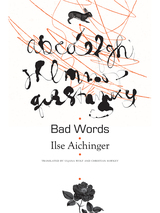 Bad Words: Selected Short Prose
Ilse Aichinger
Seagull Books, 2018 A moving work of fiction from one of the most important writers of postwar Austrian and German literature.
Born in 1921 to a Jewish mother, Ilse Aichinger (1921–2016) survived World War II in Vienna, while her twin sister Helga escaped with one of the last Kindertransporte to England in 1938. Many of their relatives were deported and murdered. Those losses make themselves felt throughout Aichinger’s writing, which since her first and only novel, The Greater Hope, in 1948, has highlighted displacement, estrangement, and a sharp skepticism toward language. By 1976, when she published Bad Words in German, her writing had become powerfully poetic, dense, and experimental. This volume presents the whole of the original Bad Words in English for the first time, along with a selection of Aichinger’s other short stories of the period; together, they demonstrate her courageous effort to create and deploy a language unmarred by misleading certainties, preconceived rules, or implicit ideologies.
 Badanj: Epipaleolithic Excavations in Herzegovina, 1986-1987
Robert Whallon
University of Michigan Press, 2025 This book presents the results of excavations made from 1986 to 1987 at the Epipaleolithic site of Badanj, which lies near the town of Stolac in southern Bosnia-Herzegovina. The site was already known from excavations made by Đuro Basler and from an engraved boulder uncovered by him that is frequently referred to as the first example of Paleolithic art from the Balkans.
The purpose of the 1986-1987 excavations was to provide a more detailed picture of the individual occupation and other layers at Badanj, to define the faunal assemblages of these layers as indicators of the changing ecology of the site, and to place the site within its regional cultural context. The excavations exposed a sequence of some ten occupation levels, seven activity or refuse levels, covering a period from approximately 16,000 to 13,000 cal BP, from the latter part of the Oldest Dryas to the end of the Bølling-Allerød late glacial climatic phases.
Over this period, two phases of lithic typology were identified, as well as parallel changes in a specific kind of decorative beads. In terms of ecology, red deer (Cervus elaphus) consistently provided by far the majority of the meat consumed at the site, but secondary fauna shows a clear, gradual replacement of colder-climate species such as ibex and chamois by warmer-climate roe deer and wild pig. Combining both qualitative and quantitative aspects of lithic technology and typology, the reconstruction of the potential foraging areas around Badanj, and estimates of supportable population allows the site to be placed in a clear regional context, which can be extended to suggest a hypothetical regional organization of similar sites over the eastern coast of the Adriatic Sea.
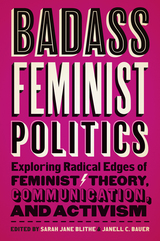 Badass Feminist Politics: Exploring Radical Edges of Feminist Theory, Communication, and Activism
Sarah Jane Blithe
Rutgers University Press, 2022 In the late 2010s, the United States experienced a period of widespread silencing. Protests of unsafe drinking water have been met with tear gas; national park employees, environmentalists, and scientists have been ordered to stop communicating publicly. Advocates for gun control are silenced even as mass shootings continue. Expressed dissent to political power is labeled as “fake news.” DREAMers, Muslims, Trans military members, women, black bodies, the LGBTQI+ community, Latina/o/x communities, rape survivors, sex workers, and immigrants have all been systematically silenced. During this difficult time and despite such restrictions, advocates and allies persist and resist, forming dialogues that call to repel inequality in its many forms. Addressing the oppression of women of color, white women, women with (dis)abilities, and LBTQI+ individuals across cultures and contexts remains a central posit of feminist struggle and requires “a distinctly feminist politics of recognition.” However, as second wave debates about feminism have revealed, there is no single way to express a feminist politic. Rather, living feminist politics requires individual interpretation and struggle, collective discussion and disagreement, and recognizing difference among women as well as points of convergence in feminist struggle.
Badass Feminist Politics includes a diverse range of engaging feminist political projects to not only analyze the work being done on the ground but provide an overview for action that can be taken on by those seeking to engage in feminist activism in their own communities. Contributors included here are working for equality and equity and resisting violent, racist, homophobic, transphobic, xenophobic, and sexist language and action during this tension-filled political moment. Collectively, the book explores what it means to live and communicate feminist politics in everyday choices and actions, and how we can facilitate learning by analyzing these examples. Taking up current issues and new theoretical perspectives, the authors offer novel perspectives into what it means to live feminist politics. This book is a testament to resilience, resistance, communication, and forward thinking about what these themes all mean for new feminist agendas. Learning how to resist oppressive structures through words and actions is particularly important for students. Badass Feminist Politics features scholars from non-dominant groups taking up issues of marginalization and oppression, which can help people accomplish their social justice goals of inclusivity on the ground and in the classroom.
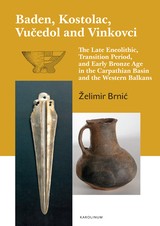 Baden, Kostolac, Vucedol and Vinkovci: The Late Eneolithic, Transition Period, and Early Bronze Age in the Carpathian Basin and the Western Balkans
Želimir Brnic
Karolinum Press, 2024 An archeological history of the indigenous cultures of the Carpathian Basin.
Baden, Kostolac, Vucedol and Vinkovci uses archaeology and genetics to create a novel cultural and historical interpretation of the Carpathian Basin during the Late Eneolithic period. The author traces the linear development of indigenous cultures from the Baden Culture through the Kostolac Culture to the Vucedol Culture, before positing that certain qualitative and quantitative shifts were driven by the entry of foreign populations—the Pit Grave Culture and the Bell Beaker Culture—into the Carpathian Basin.
The book also analyzes the emergence of the Early Bronze Age, establishing an absolute chronology, and examines the Vucedol Culture’s influence on geographically distant Bronze Age groups. An appendix also includes a discussion of findings that, while outside the Carpathian Basin, are part of its cultural sphere.
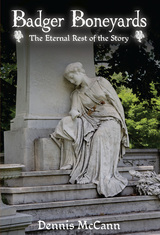 Badger Boneyards: The Eternal Rest of the Story
Dennis McCann
Wisconsin Historical Society Press, 2010 The bodies are buried, but the stories are not. From the ornate tombs of Milwaukee beer barons to displaced Chippewa graves and miniscule family plots, Badger Boneyards: The Eternal Rest of the Story unearths the stories of Wisconsin. Football great John Heisman is buried here, as is the state's smallest man, a woman whose tombstone names her murderer, and the boy who would not tell a lie and paid the price. Even in a graveyard, peace proves hard to come by: Wisconsin's Native American tribes have fought for undisturbed grounds and proper burial. A patch of Belgian graves now resides beneath a parking lot while the headstones cluster nearby, and the inhabitants of a Bayfield cemetery were unearthed by a raging flood. Sometimes the dead are recalled with only a first name, and sometimes no name at all. Following the clues in tips from readers, unusual epitaphs, and well-worn stones, Dennis McCann finds the melancholy, the humorous, the tragic, and the universal in Wisconsin's cities of the dead.
 Badiou: A Subject To Truth
Peter Hallward
University of Minnesota Press, 2003 The most complete and accessible guide in any language to this key contemporary thinker Alain Badiou is one of the most inventive and compelling philosophers working in France today—a thinker who, in these days of cynical resignation and academic specialization, is exceptional in every sense. Guided by disciplines ranging from mathematics to psychoanalysis, inspired as much by Plato and Cantor as by Mao and Mallarmé, Badiou’s work renews, in the most varied and spectacular terms, a decidedly ancient understanding of philosophy—philosophy as a practice conditioned by truths, understood as militant processes of emancipation or transformation. This book is the first comprehensive introduction to Badiou’s thought to appear in any language. Assuming no prior knowledge of his work, it provides a thorough and searching overview of all the main components of his philosophy, from its decisive political orientation through its startling equation of ontology with mathematics to its resolute engagement with its principal competition (from Wittgenstein, Heidegger, and Deleuze, among others). The book draws on all of Badiou’s published work and a wide sampling of his unpublished work in progress, along with six years of correspondence with the author. Peter Hallward pays careful attention to the aspect of Badiou’s work most liable to intimidate readers in continental philosophy and critical theory: its crucial reliance on certain key developments in modern mathematics. Eschewing unnecessary technicalities, Hallward provides a highly readable discussion of each of the basic features of Badiou’s ontology, as well as his more recent account of appearance and “being-there.” Without evading the difficulties, Peter Hallward demonstrates in detail and in depth why Badiou’s ongoing philosophical project should be recognized as the most resourceful and inspiring of his generation.
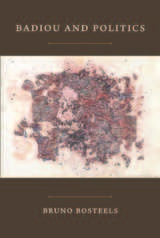 Badiou and Politics
Bruno Bosteels
Duke University Press, 2011 Badiou and Politics offers a much-anticipated interpretation of the work of the influential French philosopher Alain Badiou. Countering ideas of the philosopher as a dogmatic, absolutist, or even mystical thinker enthralled by the force of the event as a radical break, Bruno Bosteels reveals Badiou’s deep and ongoing investment in the dialectic. Bosteels draws on all of Badiou’s writings, from the philosopher’s student days in the 1960s to the present, as well as on Badiou’s exchanges with other thinkers, from his avowed “masters” Louis Althusser and Jacques Lacan, to interlocutors including Gilles Deleuze, Slavoj Žižek, Daniel Bensaïd, Jacques Derrida, Ernesto Laclau, and Judith Butler. Bosteels tracks the philosopher’s political activities from the events of May 1968 through his embrace of Maoism and the work he has done since the 1980s, helping to mobilize France’s illegal immigrants or sans-papiers. Ultimately, Bosteels argues for understanding Badiou’s thought as a revival of dialectical materialism, and he illuminates the philosopher’s understanding of the task of theory: to define a conceptual space for thinking emancipatory politics in the present.
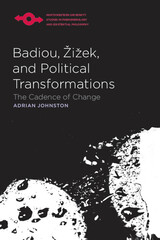 Badiou, Zizek, and Political Transformations: The Cadence of Change
Adrian Johnston
Northwestern University Press, 2009 Alain Badiou and Slavoj Žižek together have emerged as two of Europe’s most significant living philosophers. In a shared spirit of resistance to global capitalism, both are committed to bringing philosophical reflection to bear upon present-day political circumstances. These thinkers are especially interested in asking what consequences the supposed twentieth-century demise of communism entails for leftist political theory in the early twenty-first century. Badiou, Žižek, and Political Transformations examines Badiouian and Žižekian depictions of change, particularly as deployed at the intersection of philosophy and politics. The book details the origins of Badiou’s concept of the event and Žižek’s concept of the act as related theoretical visions of revolutionary happenings, delineating a number of difficulties arising from these similar concepts. Johnston finds that Badiou and Žižek tend to favor models of transformation that risk discouraging in advance precisely the efforts at changing the world of today that these uncompromising leftists so ardently desire. Badiou, Žižek, and Political Transformations will surely join Johnston’s Žižek’s Ontology as an instant classic in its field.
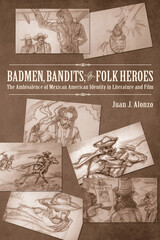 Badmen, Bandits, and Folk Heroes: The Ambivalence of Mexican American Identity in Literature and Film
Juan J. Alonzo
University of Arizona Press, 2009 Badmen, Bandits, and Folk Heroes is a comparative study of the literary and cinematic representation of Mexican American masculine identity from early twentieth-century adventure stories and movie Westerns through contemporary self-representations by Chicano/a writers and filmmakers. In this deeply compelling book, Juan J. Alonzo proposes a reconsideration of the early stereotypical depictions of Mexicans in fiction and film: rather than viewing stereotypes as unrelentingly negative, Alonzo presents them as part of a complex apparatus of identification and disavowal. Furthermore, Alonzo reassesses Chicano/a self-representation in literature and film, and argues that the Chicano/a expression of identity is characterized less by essentialism than by an acknowldgement of the contingent status of present-day identity formations.
Alonzo opens his provocative study with a fresh look at the adventure stories of Stephen Crane and the silent Western movies of D. W. Griffith. He also investigates the conflation of the greaser, the bandit, and the Mexican revolutionary into one villainous figure in early Western movies and, more broadly, traces the development of the badman in Westerns. He newly interrogates the writings of Américo Paredes regarding the makeup of Mexican masculinity, and productively trains his analytic eye on the recent films of Jim Mendiola and the contemporary poetry of Evangelina Vigil.
Throughout Badmen, Bandits, and Folk Heroes, Alonzo convincingly demonstrates how fiction and films that formerly appeared one-dimensional in their treatment of Mexicans and Mexican Americans actually offer surprisingly multifarious and ambivalent representations. At the same time, his valuation of indeterminacy, contingency, and hybridity in contemporary cultural production creates new possibilities for understanding identity formation.
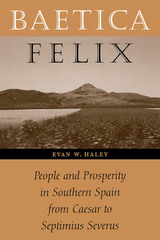 Baetica Felix: People and Prosperity in Southern Spain from Caesar to Septimius Severus
By Evan W. Haley
University of Texas Press, 2003 Baetica, the present-day region of Andalusia in southern Spain, was the wealthiest province of the Roman Empire. Its society was dynamic and marked by upward social and economic mobility, as the imperial peace allowed the emergence of a substantial middle social and economic stratum. Indeed, so mutually beneficial was the imposition of Roman rule on the local population of Baetica that it demands a new understanding of the relationship between Imperial Rome and its provinces. Baetica Felix builds a new model of Roman-provincial relations through a socio-economic history of the province from Julius Caesar to the end of the second century A.D. Describing and analyzing the impact of Roman rule on a core province, Evan Haley addresses two broad questions: what effect did Roman rule have on patterns of settlement and production in Baetica, and how did it contribute to wealth generation and social mobility? His findings conclusively demonstrate that meeting the multiple demands of the Roman state created a substantial freeborn and ex-slave "middle stratum" of the population that outnumbered both the super-rich elite and the destitute poor.
A Bag of Marbles
Joseph Joffo
University of Chicago Press, 2000 When Joseph Joffo was ten years old, his father gave him and his brother fifty francs and instructions to flee Nazi-occupied Paris and, somehow, get to the south where France was free. Previously out of print, this book is a captivating and memorable story; readers will instinctively find themselves rooting for these children caught in the whirlwind of World War II.
Baghdad, Adieu: Selected Poems of Memory and Exile
Salah Al Hamdani
Seagull Books, 2018 Iraqi poet Salah Al Hamdani has lived a remarkable life. The author of some forty books in French and Arabic, he began life as a child laborer, with little or no education. As a political prisoner under Saddam Hussein, he learned to read and write Arabic; once he was released form prison, he continued to work against the regime, ultimately, at age twenty-one, choosing exile in Paris. He now writes in French, but he remains a poet of exile, of memory, wounded by the loss of his homeland and those dear to him.
This landmark collection gathers thirty-five years of his writings, from his first volume in Arabic, Memory of Embers, to his latest collection, written originally in French, For You I Dream. It offers English-language readers their first substantial overview of Al Hamdani’s work, fired by the fight against injustice and shot through with longing for the home to which he can never return.
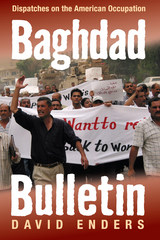 Baghdad Bulletin: Dispatches on the American Occupation
David Enders
University of Michigan Press, 2009 "David Enders has a stunning independent streak and the courage to trust his own perceptions as he reports from outside the bubble Americans have created for themselves in Iraq."
-Joe Sacco, author of Safe Area Gorazde
"Baghdad Bulletin takes us where mainstream news accounts do not go. Disrupting the easy clichés that dominate U.S. journalism, Enders blows away the media fog of war. The result is a book that challenges Americans to see through double speak and reconsider the warfare being conducted in their names."
-Norman Solomon, author of War Made Easy: How Presidents and Pundits Keep Spinning Us to Death
"Journalism at its finest and on a shoestring to boot. David Enders shows that courage and honesty can outshine big-budget mainstream media. Wry but self-critical, Baghdad Bulletin tells a story that a few of us experienced but every journalist, nay every citizen, should read."
-Pratap Chatterjee, Managing Editor and Project Director, CorpWatch
"Young and tenacious, Dave Enders went, saw, and wrote it down. Here it is-a well-informed and detailed tale of Iraq's decline under American rule. Baghdad Bulletin offers tragic politics, wacky people, and keen insights about what really matters on the ground in Iraq."
-Christian Parenti
"I wrote my first piece for Baghdad Bulletin after visiting the mass graves at Al-Hilla in 2003. The Baghdad Bulletin was essential reading in the first few months after the end of the war. I handed that particular copy to Prime Minister Tony Blair. I am only sorry that I cannot read it anymore. David Enders and his team were brave, enterprising, and idealistic."
-Rt. Hon. Ann Clwyd, member of the British Parliament
Baghdad Bulletin is a street-level account of the war and turbulent postwar period as seen through the eyes of the young independent journalist David Enders. The book recounts Enders's story of his decision to go to Iraq, where he opened the only English-language newspaper completely written, printed, and distributed there during the war.
Young, courageous, and anti-authoritarian, Enders is the first reporter to cover the war as experienced by ordinary Iraqis. Deprived of the press credentials that gave his embedded colleagues access to press conferences and officially sanitized information, Enders tells the story of a different war, outside the Green Zone. It is a story in which the struggle of everyday life is interspersed with moments of sheer terror and bizarre absurdity: wired American troops train their guns on terrified civilians; Iraqi musicians prepare a recital for Coalition officials who never show; traveling clowns wreak havoc in a Baghdad police station.
Orphans and intellectuals, activists and insurgents: Baghdad Bulletin depicts the unseen complexity of Iraqi society and gives us a powerful glimpse of a new kind of warfare, one that coexists with-and sometimes tragically veers into-the everyday rhythms of life.
Baghdad, Mon Amour: Selected Writings of Salah Al Hamdani
Salah Al Hamdani
Northwestern University Press, 2008 Baghdad, Mon Amour is a memoir by Salah Al Hamdani centered on his imprisonment under Saddam Hussein, his subsequent exile in France for more than thirty years, and his emotional return to Baghdad and seeing his family again after all those years with feelings of tremendous joy but also guilt for having “abandoned” them. The beauty of Al Hamdani’s prose and poetry is skillfully captured in Sonia Alland’s translation.
Baghdad Sketches
Freya Stark
Northwestern University Press, 1996 In the fall of 1928, thirty-five year-old Freya Stark set out on her first journey to the Middle East. She spent most of the next four years in Iraq and Persia, visiting ancient and medieval sites, and traveling alone through some of the wilder corners of the region.
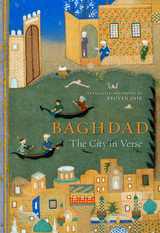 Baghdad: The City in Verse
Reuven Snir
Harvard University Press, 2013 Baghdad: The City in Verse captures the essence of life lived in one of the world’s great enduring metropolises. In this unusual anthology, Reuven Snir offers original translations of more than 170 Arabic poems—most of them appearing for the first time in English—which represent a cross-section of genres and styles from the time of Baghdad’s founding in the eighth century to the present day. The diversity of the fabled city is reflected in the Bedouin, Muslim, Christian, Kurdish, and Jewish poets featured here, including writers of great renown and others whose work has survived but whose names are lost to history.
Through the prism of these poems, readers glimpse many different Baghdads: the city built on ancient Sumerian ruins, the epicenter of Arab culture and Islam’s Golden Age under the enlightened rule of Harun al-Rashid, the bombed-out capital of Saddam Hussein’s fallen regime, the American occupation, and life in a new but unstable Iraq. With poets as our guides, we visit bazaars, gardens, wine parties, love scenes (worldly and mystical), brothels, prisons, and palaces. Startling contrasts emerge as the day-to-day cacophony of urban life is juxtaposed with eternal cycles of the Tigris, and hellish winds, mosquitoes, rain, floods, snow, and earthquakes are accompanied by somber reflections on invasions and other catastrophes.
Documenting the city’s 1,250-year history, Baghdad: The City in Verse shows why poetry has been aptly called the public register of the Arabs.
Baghdadi Judeo-Arabic: An Introductory Text
Assaf Bar-Moshe
University College London, 2024 A one-of-a-kind textbook teaching Baghdadi Judeo-Arabic.
This textbook is dedicated to spoken Baghdadi Judeo-Arabic—the native tongue spoken by the Jews of Baghdad and other towns of Southern Iraq—and is designed to guide beginners to an advanced level of speaking. It focuses on common expressions, introduces Baghdad’s historic Jewish culture, and guides readers through sample texts, key vocabulary, grammar points, and exercises, as well as particular topics, such as greetings, family, shopping, and cuisine.
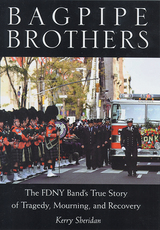 Bagpipe Brothers: The FDNY Band's True Story of Tragedy, Mourning, and Recovery
Kerry Sheridan
Rutgers University Press, 2004 After the 9/11 World Trade Center terrorist attacks, New York City's Emerald Society Bagpipe Band of firefighter-musicians took out their instruments and prepared to bury their dead--343 brothers in duty and in blood. Many firefighters alternated between playing their instruments at funerals and digging for the missing in the rubble of Ground Zero. The Irish American tradition of funeral bagpiping became the sound of mourning for an entire nation.
Bagpipe Brothers tells the unforgettable story of four firefighters in the band, who struggled to bring peace to their families and themselves while searching for the dead, coping with the endless round of funerals, and rethinking the meaning of faith. Their experiences illustrate the grief and recovery of the nation in the aftermath of the terrorist attacks.
Kerry Sheridan has written the first book to cover the ordeal of the massive number of funerals, the importance of recovering bodies in Irish American culture, and the bagpiping ritual, both traditional and modern.
Bags to Riches: The Story of I J Wagner
Gale, Don
University of Utah Press, 2007 The life of I. J. 'Izzi' Wagner mirrors the development of Salt Lake City during the twentieth century—from poverty and obscurity to affluence and prominence. Wagner was born in poverty, but through hard work, wise management, and good luck, he built a fortune. He also changed the city for the better—leading the movement to eliminate overhead signs on Main Street, opening the southwest quadrant to controlled industrial development, ridding the city center of railroad tracks, funding the Rose Wagner Center for Performing Arts, and using his substantial influence to promote tolerance.
His sense of humor was legendary. His tenacity in pursuit of goals was unwavering. His grasp of past, present, and future opportunities was profound. Bags to Riches shows the personal side of an 'outsider' who became an 'insider' through congeniality, good humor, and integrity.
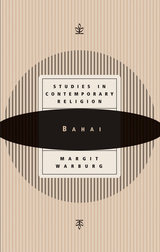 Baha'i: Studies in Contemporary Religion
Margit Warburg
Signature Books, 2001 There are 100,000 Baha’is in the United States, about five million worldwide including a significant population in Iran, their country of origin. They are also the most persecuted minority in Iran, where they are accused of being heretics by the Shi’i establishment.
In fact, Baha’i draws on a diverse heritage that encompasses both East and West. Reflecting their Islamic roots, they observe daily prayers and the reading of sacred texts; a month of fast; pilgrimage to Haifa, Israel, where the religion’s relics are preserved; and abstinence from alcohol. They face toward their prophet Baha’u'llah’s resting place when praying, which is reminiscent of Muslims facing Mecca to pray.
In other ways, the Baha’i religion has dissociated itself from orthodox Shi’ism. Adherents avoid communal prayer, reject the idea of a professional clergy, promote gender equality, and devote a great deal of attention to education, health care, and environmental issues. They work actively through the United Nations system to promote their view of a new world order of peace and harmony that they feel will one day unify humankind across all nations, races, and religions.
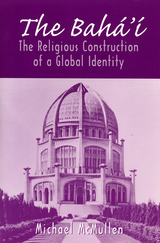 The Bahá'í: The Religious Construction of a Global Identity
McMullen, Michael
Rutgers University Press, 2000 The Bahá’í Faith is one of the fastest growing, but least studied, of the world’s religions. Adherents view themselves as united by a universal belief that transcends national boundaries. Michael McMullen examines how the Bahá’í develop and maintain this global identity. Taking the Bahá’í community in Atlanta, Georgia, as a case in point, his book is the first to comprehensively examine the tenets of this little-understood faith. McMullen notes that, to the Bahá’í, Buddha, Moses, Jesus, and Mohammed are all divinely sent teachers of ‘the Truth’, whose messages conform to the needs of their individual cultures and historical periods. But religion—which draws from the teaching of Bahá’u’lláh, a nineteenth-century Persian—encourages its members to think of themselves as global citizens. It also seeks to establish unity among its members through adherence to a Bahá’í worldview. By examining the Atlanta Bahá’í community, McMullen shows how this global identity is interpreted locally. He discusses such topics as: the organizational structure and authority relations in the Bahá’í “Administrative Order”; Bahá’í evangelicalism; and the social boundaries between Bahá’ís and the wider culture.
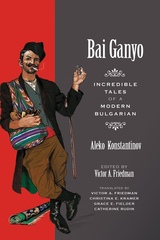 Bai Ganyo: Incredible Tales of a Modern Bulgarian
Aleko Konstantinov
University of Wisconsin Press, 2010 A comic classic of world literature, Aleko Konstantinov’s 1895 novel Bai Ganyo follows the misadventures of rose-oil salesman Ganyo Balkanski (“Bai” is a Bulgarian title of intimate respect) as he travels in Europe. Unkempt but endearing, Bai Ganyo blusters his way through refined society in Vienna, Dresden, and St. Petersburg with an eye peeled for pickpockets and a free lunch. Konstantinov’s satire turns darker when Bai Ganyo returns home—bullying, bribing, and rigging elections in Bulgaria, a new country that had recently emerged piecemeal from the Ottoman Empire with the help of Czarist Russia.
Bai Ganyo has been translated into most European languages, but now Victor Friedman and his fellow translators have finally brought this Balkan masterpiece to English-speaking readers, accompanied by a helpful introduction, glossary, and notes. Winner, Bulgarian Studies Association Book Prize Finalist, Foreword Magazine’s Multicultural Fiction Book of the Year Winner, John D. Bell Book Prize, Bulgarian Studies Association Best Books for Special Interests, selected by the American Association for School Libraries Best Books for High Schools, selected by the American Association for School Libraries Best Books for Special Interests, selected by the Public Library Association
Baiae
Giovanni Gioviano PontanoTranslated by Rodney G. Dennis
Harvard University Press, 2006 Giovanni Gioviano Pontano (1426–1503) was an important humanist and scholar of Renaissance Italy, the presiding spirit of the Accademia Pontaniana, and chief minister and tutor to the Aragonese Kings of Naples. He was also the most innovative and versatile Latin poet of Quattrocento Italy. His Two Books of Hendecasyllables, given the subtitle Baiae by their first editor Pietro Summonte, experiment brilliantly with the metrical form associated principally with the ancient Latin poet Catullus. The poems are the elegant offspring of Pontano’s leisure, written to celebrate love, good wine, friendship, nature, and all the pleasures of life to be found at the seaside resort of Baiae on the Bay of Naples. They are translated here for the first time into English.
 The Baileys Harbor Bird and Booyah Club
Dave Crehore
University of Wisconsin Press, 2012 Open this book and you are in Door County, Wisconsin, strolling down Coot Lake Road—a one-lane, dead-end gravel track just a few miles from Baileys Harbor and the Lake Michigan shore. Along the way you meet George and Helen O’Malley, who are growing old gracefully. Russell, their brave and empathetic golden retriever, wags hello and offers you a paw to shake.
The Olsons and the Berges live just down the road. Bump Olson is the local septic tank pumper and birdwatcher extraordinaire, and Hans Berge, MD, PhD, was at one time the only Norwegian psychiatrist in Chicago—or so he says. In a cottage out by the highway, you may spot Lloyd Barnes, ex–Tennessee state trooper, hound fancier, and local man of mystery. Uncle Petter Sorenson, visiting from Grand Forks, takes the polar bear plunge at Jacksonport. Around the neighborhood you’ll meet Deputy Doug, the flirtatious cellist Debbie Dombrowski, and Italian import Rosa Zamboni.
Dave Crehore’s sketches of life on the Door peninsula also expound on:
• the delights of codfish pizza
• how to insult Canadians
• what to expect at your fiftieth high school reunion
• how to lose a school board election
• the prevention of creeping old-fogyism
• Marilyn, a buxom eight-pound smallmouth bass
• and what goes on in the winter, when no one is there.
Bait
David Albahari
Northwestern University Press, 2001 In self-exile in Canada after the collapse of Yugoslavia and his mother's death, the narrator of Bait is listening to a series of tapes he recorded of his mother years before. As her story is told, he reflects on her life and their relationship, attempting to come to terms with his Jewishness and his own new life in a foreign culture.
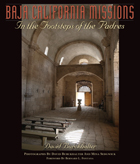 Baja California Missions: In the Footsteps of the Padres
David Burckhalter; Photographs by David Burckhalter and Mina Sedgwick; Foreword by Bernard L. Fontana
University of Arizona Press, 2013 Bathed in desert light and shadow, rising up from the earth in improbable, faraway places, stand eight original Spanish missions on Mexico’s Baja California peninsula. Built of stone by Roman Catholic priests and indigenous laborers in the eighteenth century, these stunning missions dominate the landscape around them. Baja California Missions: In the Footsteps of the Padres is a beautiful and informative book about the eight monumental Spanish colonial churches, buildings seldom seen by those familiar with the missions of California, Arizona, and Sonora, Mexico.
With gorgeous photographs of the architecture and religious art, and supported by a concise history that outlines the peninsula’s exploration and colonization by Roman Catholic priests, Baja California Missions excels as a book of photography and history. It promises adventure for readers at home, as well as for travelers ready to explore the churches in person.
The eight Spanish colonial stone churches of Baja California endure as the only intact originals of 34 missions built by the padres during the peninsula’s colonization. Due to structural renovations and restorations of the artwork undertaken over the last 30 years, the renowned mission churches have become sources of pride to the citizens of Baja California. Travelers are invited to visit at any time, especially during patron saint day celebrations.
As a guide, Baja California Missions is fully up to date, with directions for navigating Baja’s paved highways and desert and mountain roads. The mission sites are pinpointed on a topographic roadmap of the peninsula. A church floor plan is provided to accompany a walk-through tour for each church interior. The lovely eighteenth-century oil paintings and wooden statues that grace the church altars are also identified and described
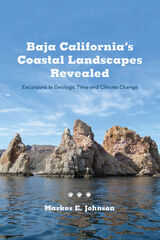 Baja California's Coastal Landscapes Revealed: Excursions in Geologic Time and Climate Change
Markes E. Johnson
University of Arizona Press, 2021 Baja California is an improbably long and narrow peninsula. It thrusts out like a spear, parting the Mexican mainland from the Pacific Ocean. In his third installment on the Gulf of California’s coastal setting, expert geologist and guide Markes E. Johnson reveals a previously unexplored side to the region’s five-million-year story beyond the fossil coral reefs, clam banks, and prolific beds of coralline algae vividly described in his earlier books. Through a dozen new excursions, in Baja California’s Coastal Landscapes Revealed, Johnson returns to these yet wild shores to share his gradual recognition of another side to the region.
Johnson reveals a geologic history that is outside the temporal framework of a human lifetime and scored by violent storms. We see how hurricanes have shaped coastal landscapes all along the peninsula’s inner coast, a fascinating story only possible by disassembling the rocks that on first appraisal seem incomprehensible.
Looking closely, Johnson shows us how geology not only helps us look backward but also forward toward an uncertain future. The landscape Johnson describes may be apart from the rest of Mexico, but his expert eye reveals how it is influenced by the unfolding drama of Planet Earth’s global warming.
 The Bajío Revolution: Remaking Capitalism, Community, and Patriarchy in Mexico, North America, and the World
John Tutino
Duke University Press, 2025 In The Bajío Revolution, John Tutino examines how popular insurgents reshaped Mexico, the United States, and global capitalism during the nineteenth century. After detailing New Spain’s silver-driven wealth, Tutino shows how the Bajío insurgency of 1810–20 broke silver flows and Asian trades, opening markets to industrial cloth made in England from cotton made by enslaved hands in the US South—while Bajío women claimed pivotal roles making maize to sustain families and guerrilla bands. As Mexico gained independence in 1821, mining remained broken while family growers held strong. Then, in the 1830s, a new silver-industrial capitalism fed by family maize makers rose in the Bajío. Women still led rural families and took on mill labor; one woman became Mexico’s leading silver capitalist. Facing that competition, in the 1840s the United States invaded to claim Texas for cotton and slavery and California for gold. The new Mexican capitalism carried on until the United States mobilized gold taken in war to join a global gold standard in the 1870s—blocking Mexico’s independent route to capitalism.
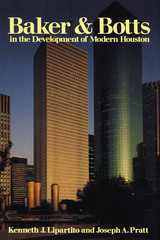 Baker & Botts in the Development of Modern Houston
By Kenneth J. Lipartito and Joseph A. Pratt
University of Texas Press, 1991 As counsel for Pennzoil's successful effort to recover billions of dollars in damages from Texaco over the acquisition of Getty Oil Company, the Baker & Botts law firm of Houston, Texas, achieved wide public recognition in the 1980s. But among its peers in the legal and corporate worlds, Baker & Botts has for more than a century held a preeminent position, handling the legal affairs of such blue-chip clients as the Southern Pacific Railroad, Houston Lighting & Power Company, Rice University, Texas Commerce Bank, and Tenneco. In this study, Kenneth J. Lipartito and Joseph A. Pratt chronicle the history of Baker & Botts, placing particular emphasis on the firm's role in Houston's economic development. Founded in 1840, Baker & Botts literally grew up with Houston. The authors chart its evolution from a nineteenth-century regional firm that represented eastern-based corporations moving into Texas to a twentieth-century national firm with clients throughout the world. They honestly discuss the criticisms that Baker & Botts has faced as an advocate of big business. But they also identify the important impact that corporate law firms of this type have on business reorganization and government regulation. As the authors demonstrate in this case study, law firms throughout the twentieth century have helped to shape public policy in these critical areas. Always prominent in the community, and with prominent connections (former Secretary of State James A. Baker III is the great-grandson of the original Baker), the Baker & Botts law firm belongs in any history of the development of Houston and the Southwest.
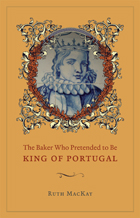 The Baker Who Pretended to Be King of Portugal
Ruth MacKay
University of Chicago Press, 2012 On August 4, 1578, in an ill-conceived attempt to wrest Morocco back from the hands of the infidel Moors, King Sebastian of Portugal led his troops to slaughter and was himself slain. Sixteen years later, King Sebastian rose again. In one of the most famous of European impostures, Gabriel de Espinosa, an ex-soldier and baker by trade—and most likely under the guidance of a distinguished Portuguese friar—appeared in a Spanish convent town passing himself off as the lost monarch. The principals, along with a large cast of nuns, monks, and servants, were confined and questioned for nearly a year as a crew of judges tried to unravel the story, but the culprits went to their deaths with many questions left unanswered. Ruth MacKay recalls this conspiracy, marked both by scheming and absurdity, and the legal inquest that followed, to show how stories of this kind are conceived, told, circulated, and believed. She reveals how the story of Sebastian, supposedly in hiding and planning to return to claim his crown, was lodged among other familiar stories: prophecies of returned leaders, nuns kept against their will, kidnappings by Moors, miraculous escapes, and monarchs who die for their country. As MacKay demonstrates, the conspiracy could not have succeeded without the circulation of news, the retellings of the fatal battle in well-read chronicles, and the networks of rumors and correspondents, all sharing the hope or belief that Sebastian had survived and would one day return. With its royal intrigues, ambitious artisans, dissatisfied religious women, and corrupt clergy, The Baker Who Pretended to Be King of Portugal will undoubtedly captivate readers as it sheds new light on the intricate political and cultural relations between Spain and Portugal in the early modern period and the often elusive nature of historical truth.
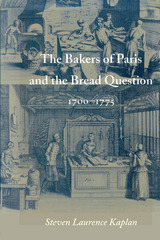 The Bakers of Paris and the Bread Question, 1700-1775
Steven Laurence Kaplan
Duke University Press, 1996 In preindustrial Europe, dependence on grain shaped every phase of life from economic development to spiritual expression, and the problem of subsistence dominated the everyday order of things in a merciless and unremitting way. Steven Laurence Kaplan’s The Bakers of Paris and the Bread Question, 1700–1775 focuses on the production and distribution of France’s most important commodity in the sprawling urban center of eighteenth-century Paris where provisioning needs were most acutely felt and most difficult to satisfy. Kaplan shows how the relentless demand for bread constructed the pattern of daily life in Paris as decisively and subtly as elaborate protocol governed the social life at Versailles.
Despite the overpowering salience of bread in public and private life, Kaplan’s is the first inquiry into the ways bread exercised its vast and significant empire. Bread framed dreams as well as nightmares. It was the staff of life, the medium of communion, a topic of common discourse, and a mark of tradition as well as transcendence. In his exploration of bread’s materiality and cultural meaning, Kaplan looks at bread’s fashioning of identity and examines the conditions of supply and demand in the marketplace. He also sets forth a complete history of the bakers and their guild, and unmasks the methods used by the authorities in their efforts to regulate trade.
Because the bakers and their bread were central to Parisian daily life, Kaplan’s study is also a comprehensive meditation on an entire society, its government, and its capacity to endure. Long-awaited by French history scholars, The Bakers of Paris and the Bread Question, 1700–1775 is a landmark in eighteenth-century historiography, a book that deeply contextualizes, and thus enriches our understanding of one of the most important eras in European history.
Bakhtin and Religion: A Feeling for Faith
Susan M. Felch and Paul J. Contino
Northwestern University Press, 2001 The dimension of religion in the life and work of Bakhtin has been fiercely contested--and willfully ignored--by critics. Unique in its in-depth focus on this subject, Bakhtin and Religion brings together leading British, American, and Russian scholars to investigate the role of religious thought in shaping and framing Bakhtin's writings.
These essays provide an overview of Bakhtin's attitude toward religion in general and Russian Orthodoxy in particular, addressing topics ranging from how Bakhtin's religious ideas informed his linguistic and aesthetic theories to the idea of love in his secular and religious thought and to the religious component of Bakhtin's theory of laughter.
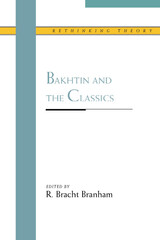 Bakhtin and the Classics
R. Bracht Branham
Northwestern University Press, 2001 Mikhail Bakhtin's critical and theoretical experiments have inspired original work in the humanities and social sciences, but Bakhtin and the Classics is the first book to focus on the relationship between Bakhtin and classical studies, the discipline in which Bakhtin himself was trained. Clearly demonstrating the fundamental importance of classical literature in his work, Bakhtin and the Classics expands our understanding of both Bakhtin's thought and the literary and cultural history of antiquity.
The authors, eminent classicists and distinguished critics of Bakhtin, put Bakhtin into dialogue with the classics--and classicists into dialogue with Bakhtin. Each essay offers a critical account of an important aspect of Bakhtin's thought and examines the value of his approach in the context of literary or cultural history. Beginning with an overview of Bakhtin's notion of carnival laughter, perhaps his central critical concept, the volume explores Bakhtin's thought and writing in relation to Homer's epic verse. Catullus's lyric poetry, ancient Roman novels, and Greek philosophy from Aristotle's theory of narrative to the work of Antiphon the Sophist. The results are of interest and importance to Bakhtinians, theorists, and classicists.
 Bakhtin/ Bakhtin: The Archives and Beyond, Volume 97
Peter Hitchcock
Duke University Press Offering original research on Mikhail Bakhtin by leading scholars in the field, this special issue of SAQ both celebrates the recent centennial of Bakhtin’s birth and elaborates significant new strains in Bakhtinian thinking. The distinction between Bakhtin and “Bakhtin” is a measure of the incommensurable space between the biographically verifiable figure and the one who emerges from contemporary critical applications of his work. While the inevitability of this space must be acknowledged, so too must its implications for a politics of culture where theory is concerned. Can there be a real Bakhtin, and can this one simply be the relevant Bakhtin? Is the deified Bakhtin just a reified Bakhtin? Exploring both the dynamism of Bakhtin versus “Bakhtin” and the dynamics of “possible Bakhtins,” the contributors tackle this theorist’s range of shifting shapes, from the carnival-messianistic and the chronotopic, through the philosophic and the ideologic, to the “applied Bakhtin” of the social sciences. Bakhtin’s texts are examined in the context of work by such disparate figures as Ernst Cassirer and Rudolph Rocker, while various aspects of the academic “Bakhtin industry” are examined, including the “will to mythology by anthology” and the inequities of a world market in ideas exemplified by the resource gap between Russian and Western scholarship. The “state of the archive” is assessed by both UK Bakhtin Centre Director David Shepherd and Russian Bakhtin Archivist Nikolai Pan’kov. Throughout the issue, which is framed by Peter Hitchcock’s introductory polemics and Michael Holquist’s afterword, author and archive are continually deconstructed and reconstructed. Contributors. Robert Barsky, Rachel Falconer, Maroussia Hadjukowski-Ahmed, Ken Hirschkop, Peter Hitchcock, Michael Holquist, Vitaly Makhlin, Nikolai Pan’kov, Brian Poole, David Shepherd, Galin Tihanov, Anthony Wall
 The Bakhtin Circle: Philosophy, Culture and Politics
Craig Brandist
Pluto Press, 2002 Mikhail Bakhtin and the group of thinkers known as the Bakhtin Circle have had a massive influence on contemporary literary and cultural theory. Bakhtin is recognised as perhaps the key theorist on the novel as a genre, and his writings on carnival in popular culture are a recurrent theme in cultural studies. The influence of the Circle has recently spread into social theory, philosophy and psychology, which means that a narrow literary approach is now inadequate for fully understanding the breadth of their ideas. Moreover, recent research has revolutionised our understanding of the work of the Bakhtin Circle and retranslation has shown that many of the existing translations are significantly flawed. It is also now clear that the work of the Circle was the product of discussions between members of an extraordinary group of scholars.
This is the first book to bring together this significant new research on the Circle, setting it within a historical and intellectual context and emphasising the importance of the work of the Circle as a whole. Craig Brandist offers a new look at the significance of Bakhtin's legacy, and brings into clearer focus the contribution of others in the circle--including Voloshinov, Medvedev, Pumpianskii and Kagan--whose work has so often been obscured, assessing the fundamental role they played in shaping Bakhtinian thought.
Bakhtin in Contexts: Across the Disciplines
Amy Mandelker
Northwestern University Press, 1995 The Russian critic M. M. Bakhtin has recently become a major figure in contemporary theory beyond his traditional influence in Slavic literary studies. Bakhtin in Contexts explores the revolutionary impact Bakhtin's ideas have carried in contemporary discussion of language, art, culture, and social science in recent years. The contributors represent a broad range of disciplines in the humanities and social sciences, epitomizing the views of Russian and American specialists in those fields Bakhtin often referred to as "the human sciences." The diversity of perspective and flexibility of approach make this a unique contribution to Bakhtin studies and to the ongoing dialogue between Western and Russian theorists.
 Bakhtin’s Adventure: An Essay on Life without Meaning
Benjamin Paloff
Northwestern University Press, 2025 A bold rereading of Mikhail Bakhtin’s groundbreaking theories
A century after Mikhail Bakhtin first began formulating his now-canonical reflections on freedom and literary representation, we often seem as confused as ever about the relationship between narrative form and what it means to live ethically. Focusing on the throughline of adventure in Bakhtin’s thought, we find a peculiar, yet no less ethically urgent challenge: not to imagine the literary hero as if they were a real person but to recognize how we are always imagining real people as if they were literary characters. This is a provocation with far-reaching consequences for how we understand ourselves, each other, and our situatedness in space and time.
In Bakhtin’s Adventure: An Essay on Life without Meaning, Benjamin Paloff argues that the major aesthetic, ethical, and sociological threads of Bakhtin’s thought intersect in his concept of adventure. Reading across a wide variety of media, from classic literature to contemporary film, Paloff demonstrates how, for Bakhtin and his interlocutors, the test of human freedom is whether narrative means nothing beyond its own adventure. Reframed in this light, Bakhtin’s most influential ideas (eventness, chronotope, heteroglossia, polyphony, carnival) form a cohesive model for how to maintain ethical relations in a world where we can never really know each other the way we know ourselves.
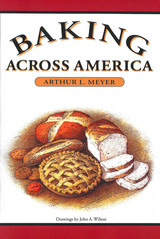 Baking across America
By Arthur L. Meyer
University of Texas Press, 1998 Whether it's a slice of warm bread and butter, a Thanksgiving pumpkin pie, or a piece of cake, baked goods have been among America's favorite comfort foods ever since the Pilgrims arrived. From the days of hand mixing and baking on the hearth to today's use of food processors and electric ranges, American cooks have created an amazing variety of breads and baked goods that are as distinctive as the cultures from which we came.
Spanning colonial times to the present and every region of the United States, this book is a comprehensive guide to baking in America. Certified master baker Arthur L. Meyer brings together some 700 kitchen-tested recipes for America's favorite breads, pies, cakes, and cookies. Compiled from almost 300 regional cookbooks dating from the 1890s to the 1980s, these are the authentic recipes for the traditional baked goods of every part of our country. In these pages, you'll find regional specialties such as Appalachian Buttermilk Cracklin' Bread and Hawaiian Pineapple-Macadamia Bread, as well as old family recipes.
In addition to the recipes, Meyer offers a fascinating overview of the history of baking in America, complete with descriptions of early breads, pies, cakes, and cookies. Whether you're a home or professional baker, a food historian, or someone who just enjoys reading cookbooks, you're sure to find lots of tasty treats here. Let Baking across America become your basic source for all the baked goodies Americans love to eat.
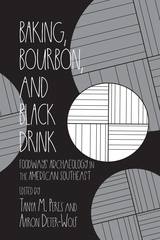 Baking, Bourbon, and Black Drink: Foodways Archaeology in the American Southeast
Edited by Tanya M. Peres and Aaron Deter-Wolf
University of Alabama Press, 2018 Discover the deep cultural roots of Southern cuisine through archaeology.
Understanding and explaining societal rules surrounding food and foodways have been the foci of anthropological studies since the early days of the discipline. Baking, Bourbon, and Black Drink: Foodways Archaeology in the American Southeast, however, is the first collection devoted exclusively to southeastern foodways analyzed through archaeological perspectives. These essays examine which foods were eaten and move the discussion of foodstuffs into the sociocultural realm of why, how, and when they were eaten.
Editors Tanya M. Peres and Aaron Deter-Wolf present a volume that moves beyond basic understandings, applying new methods or focusing on subjects not widely discussed in the Southeast to date. Chapters are arranged using the dominant research themes of feasting, social and political status, food security and persistent places, and foodways histories. Contributors provide in-depth examination of specific food topics such as bone marrow, turkey, Black Drink, bourbon, earth ovens, and hominy.
Contributors bring a broad range of expertise to the collection, resulting in an expansive look at all of the steps taken from field to table, including procurement, production, cooking, and consumption, all of which have embedded cultural meanings and traditions. The scope of the volume includes the diversity of research specialties brought to bear on the topic of foodways as well as the temporal and regional breadth and depth, the integration of multiple lines of evidence, and, in some cases, the reinvestigation of well-known sites with new questions and new data.
|
|

